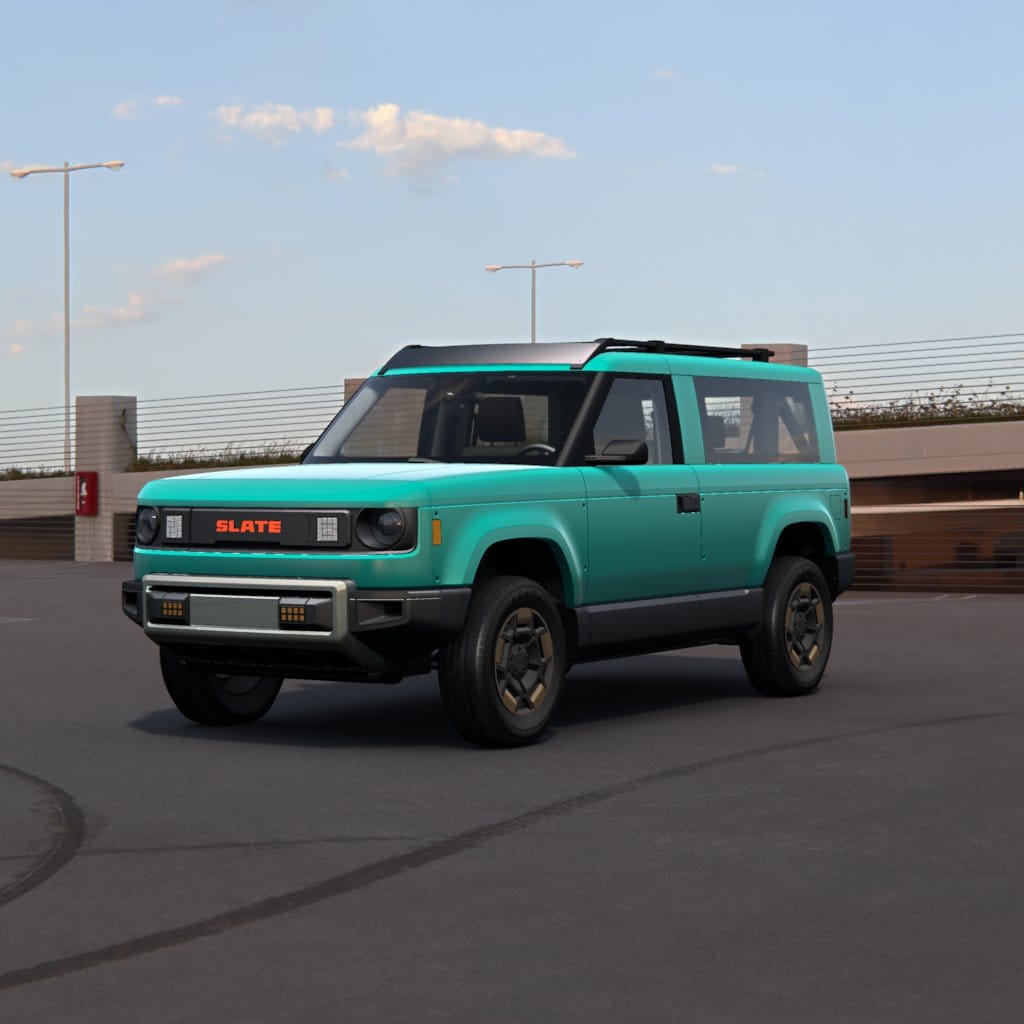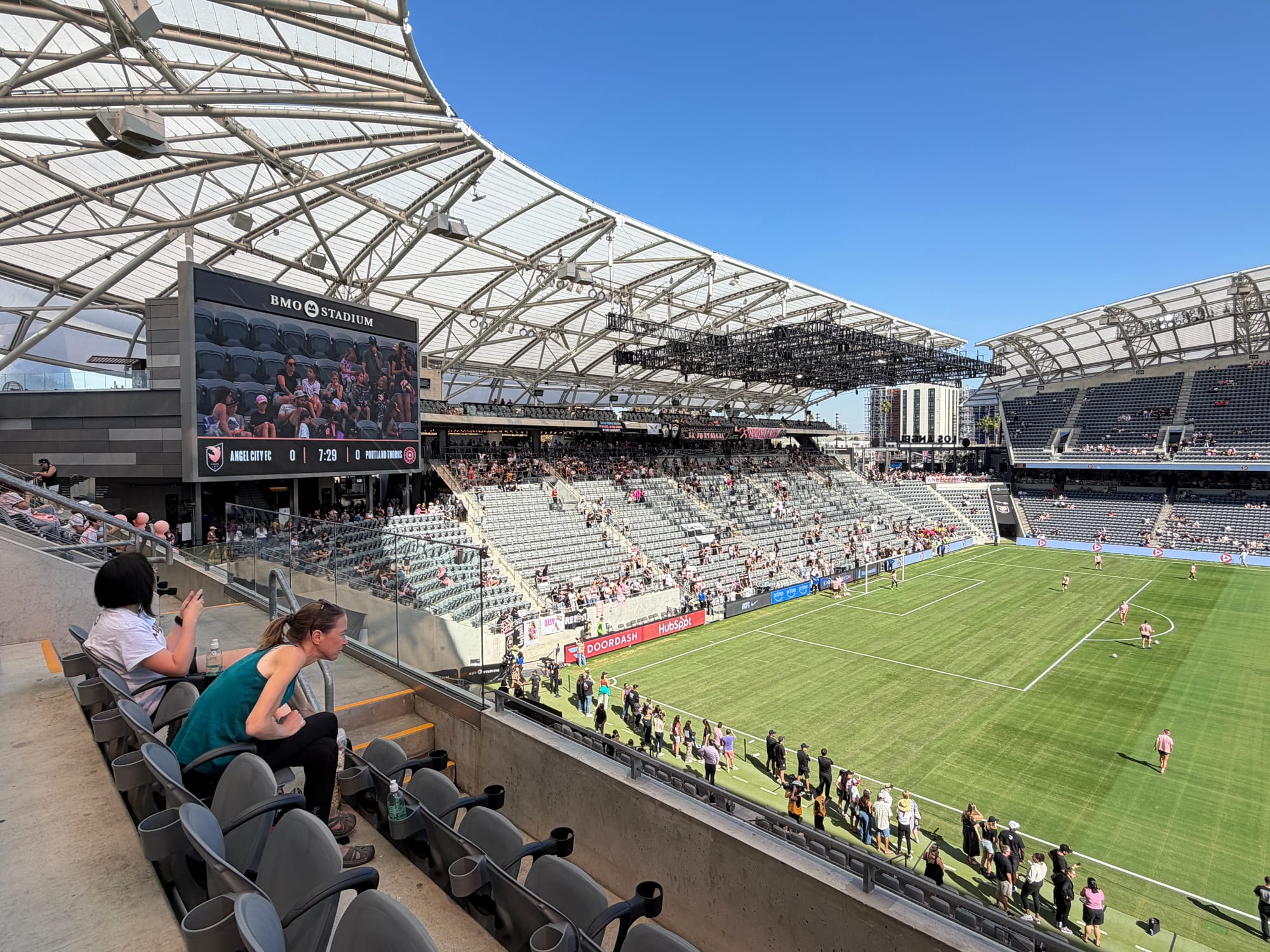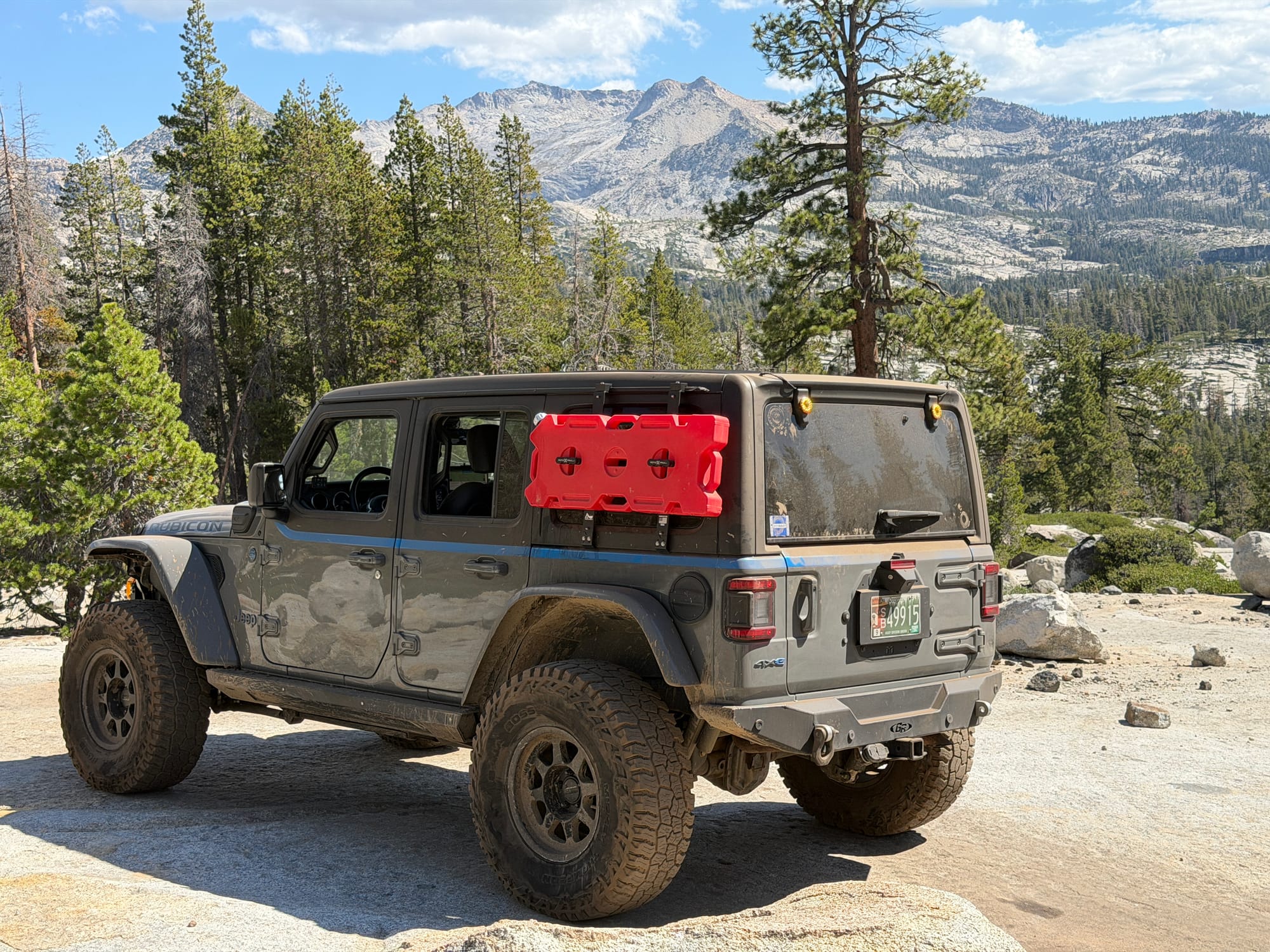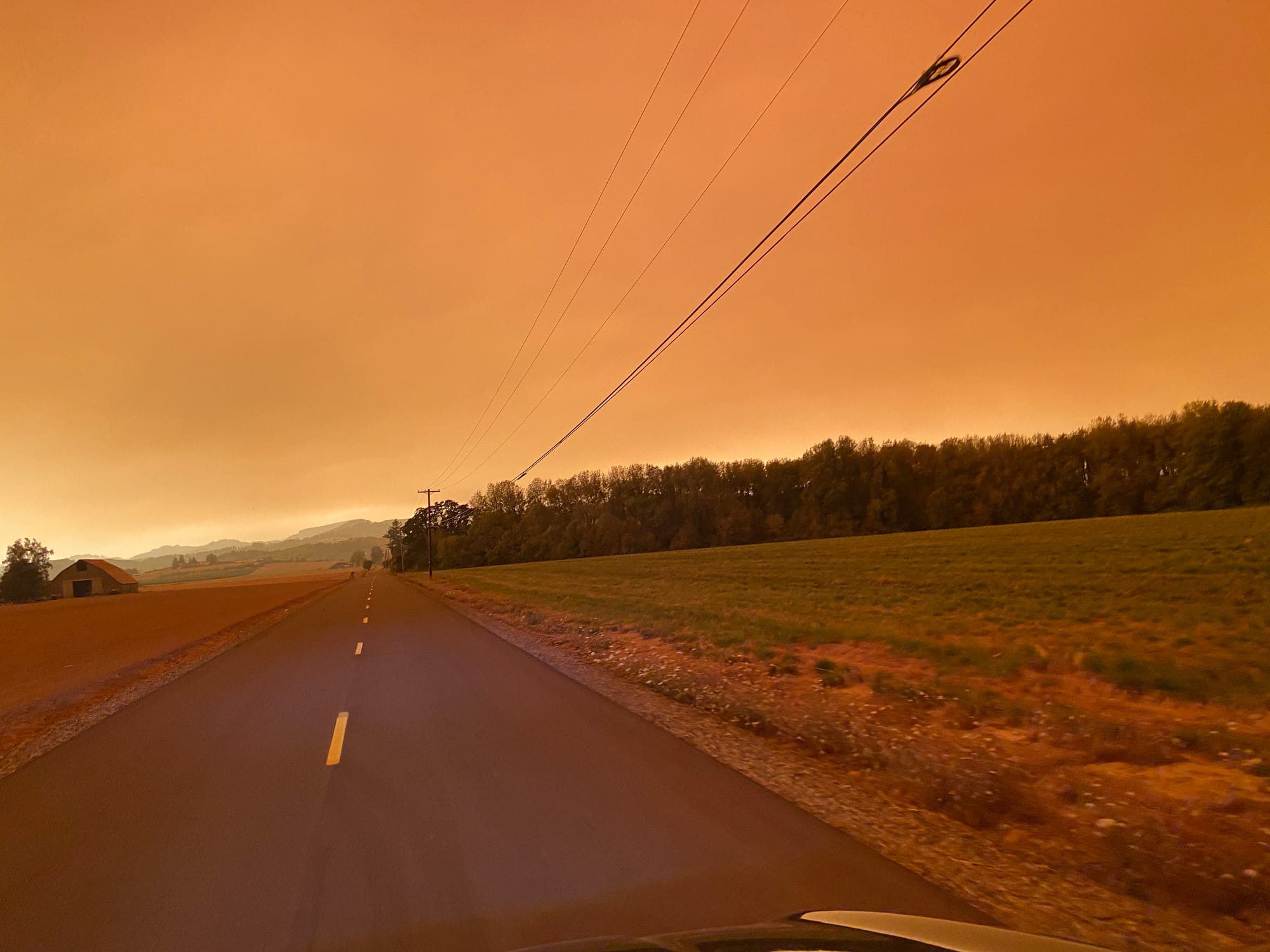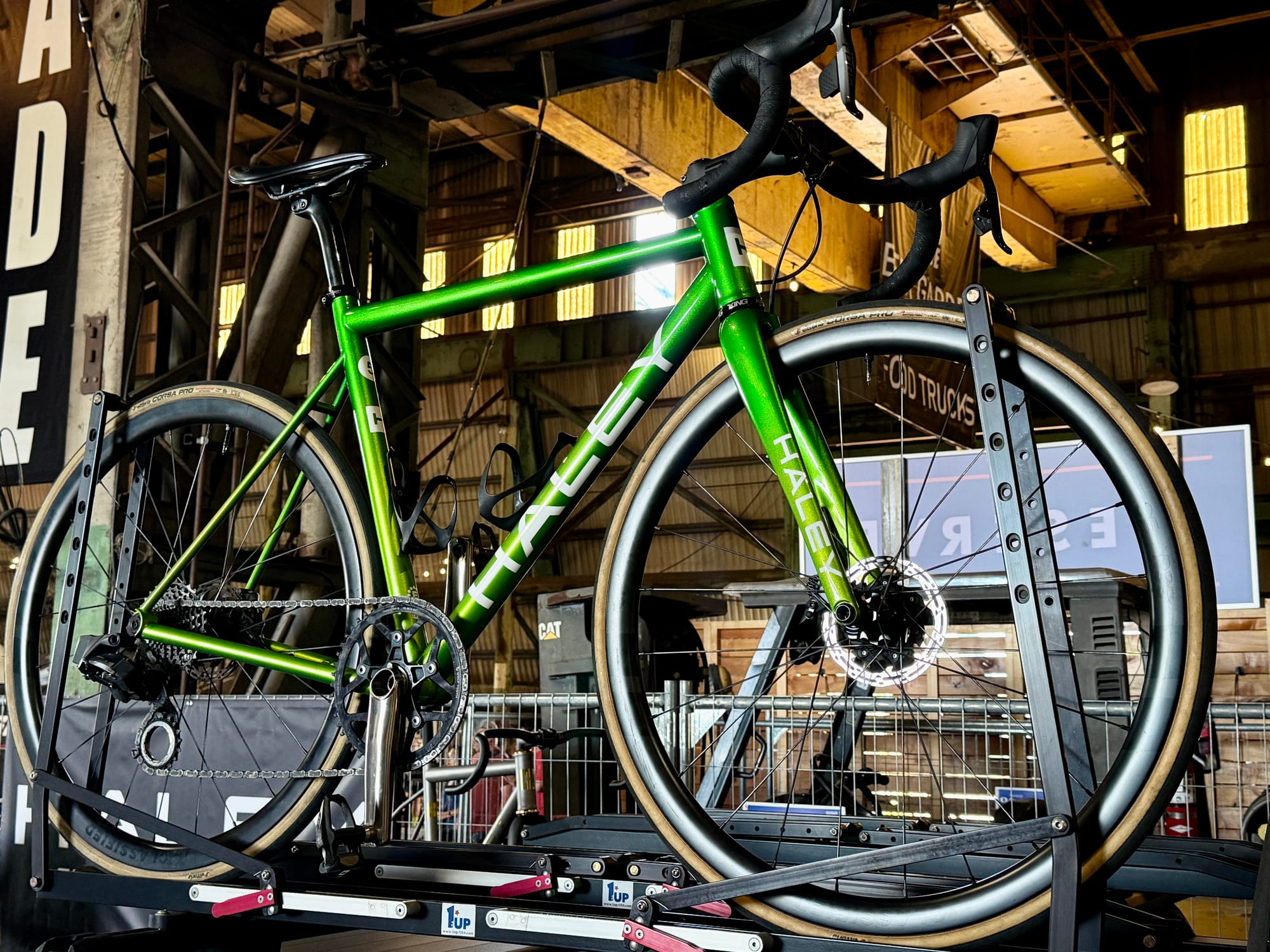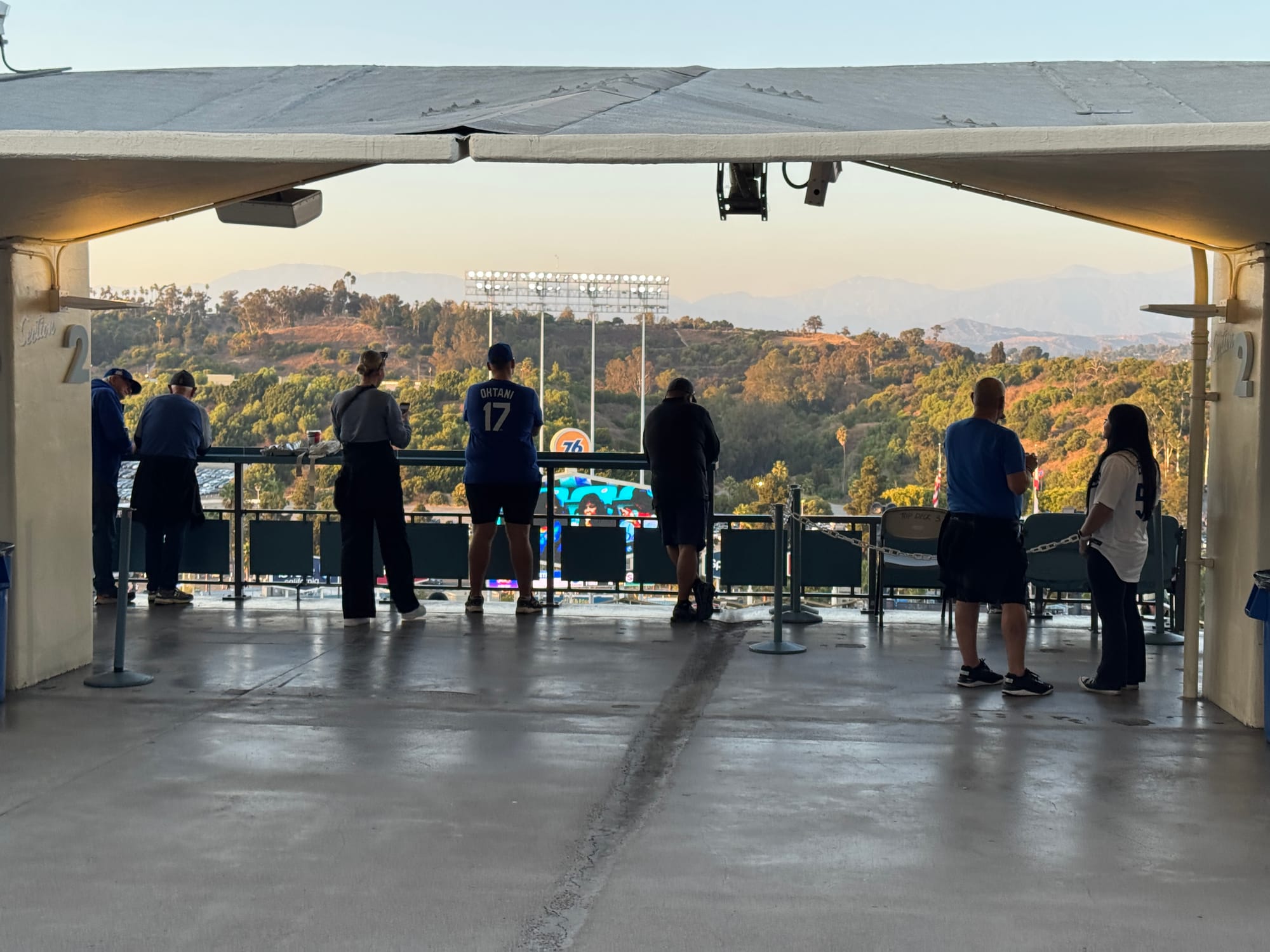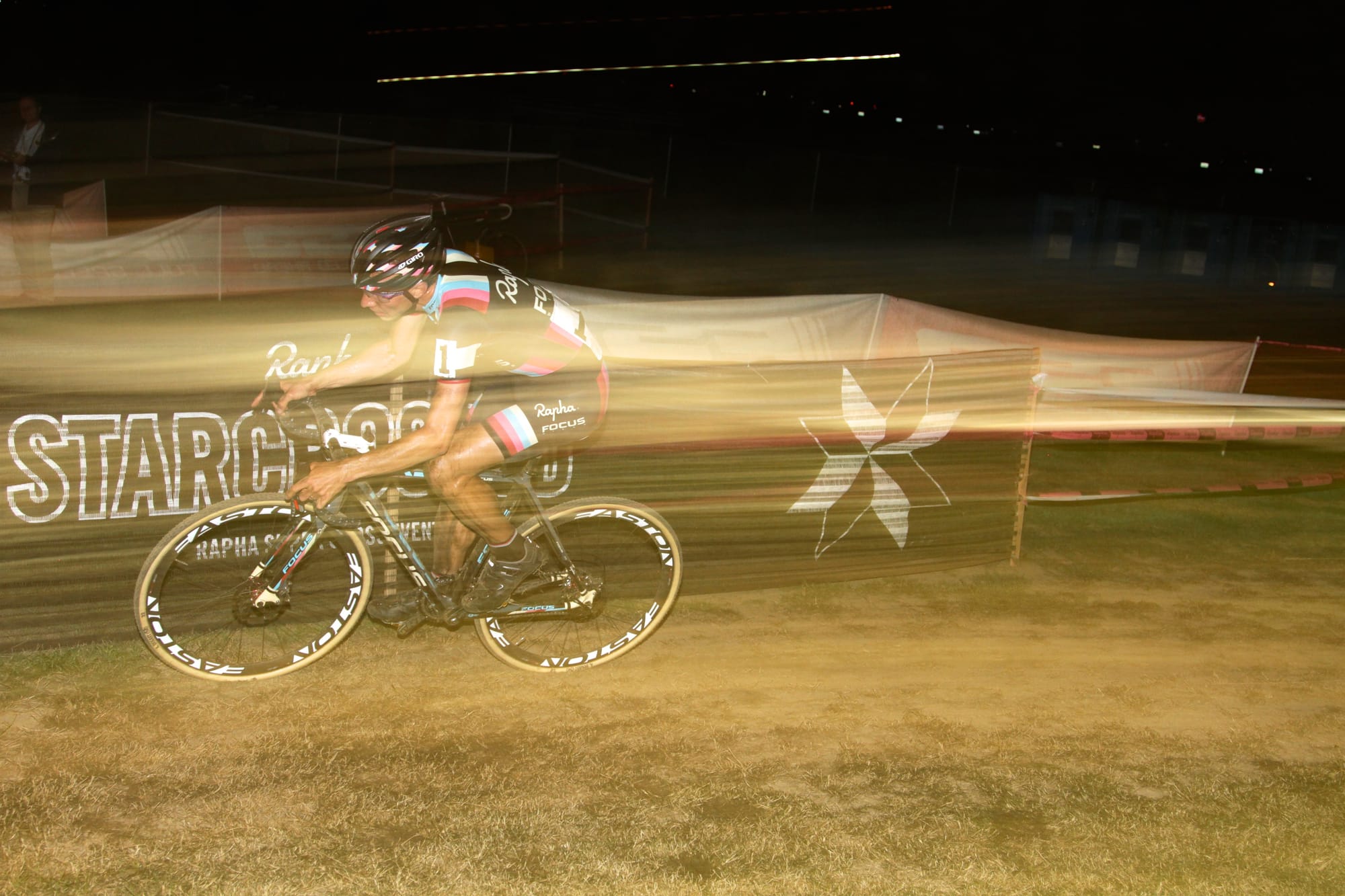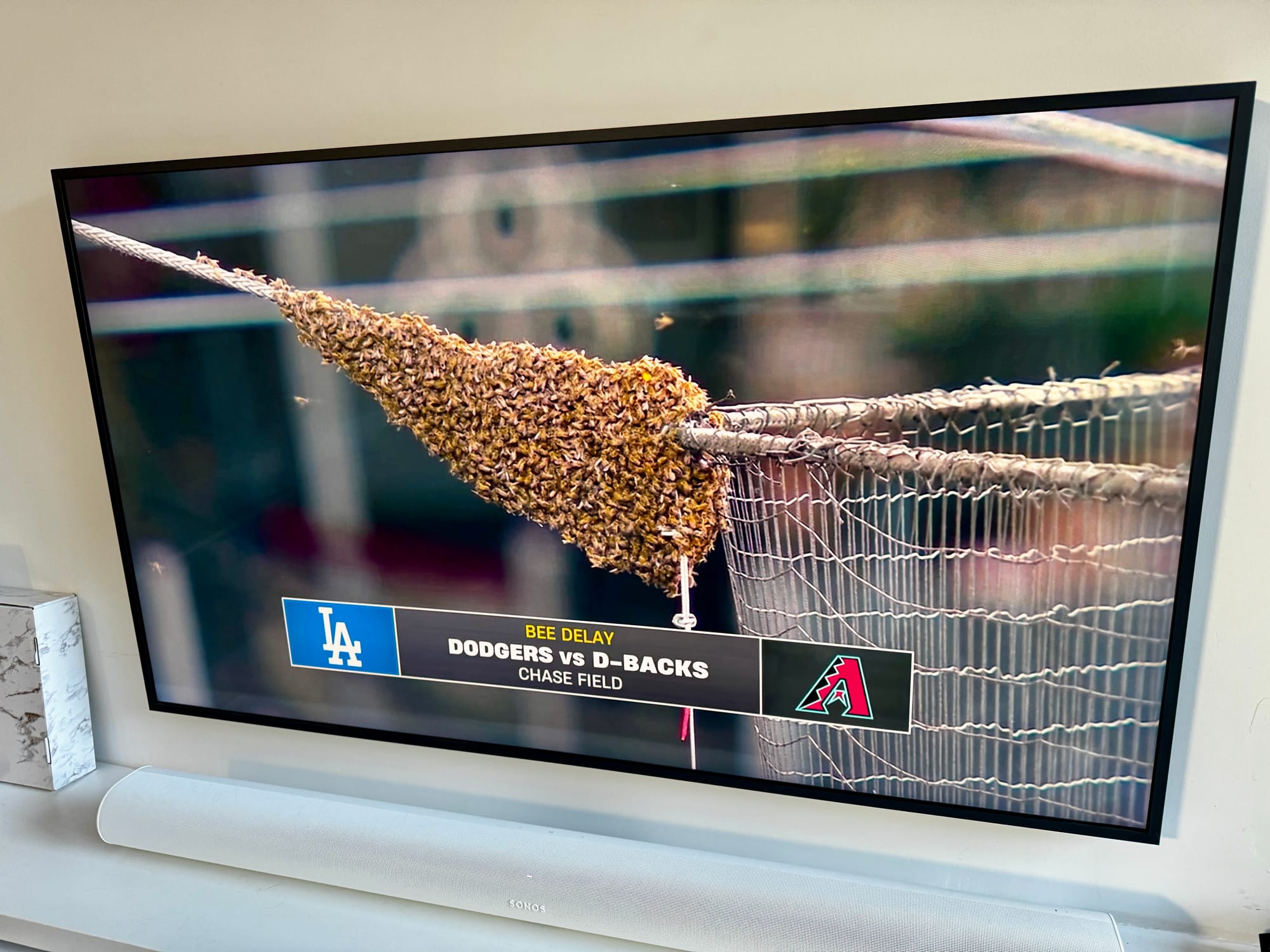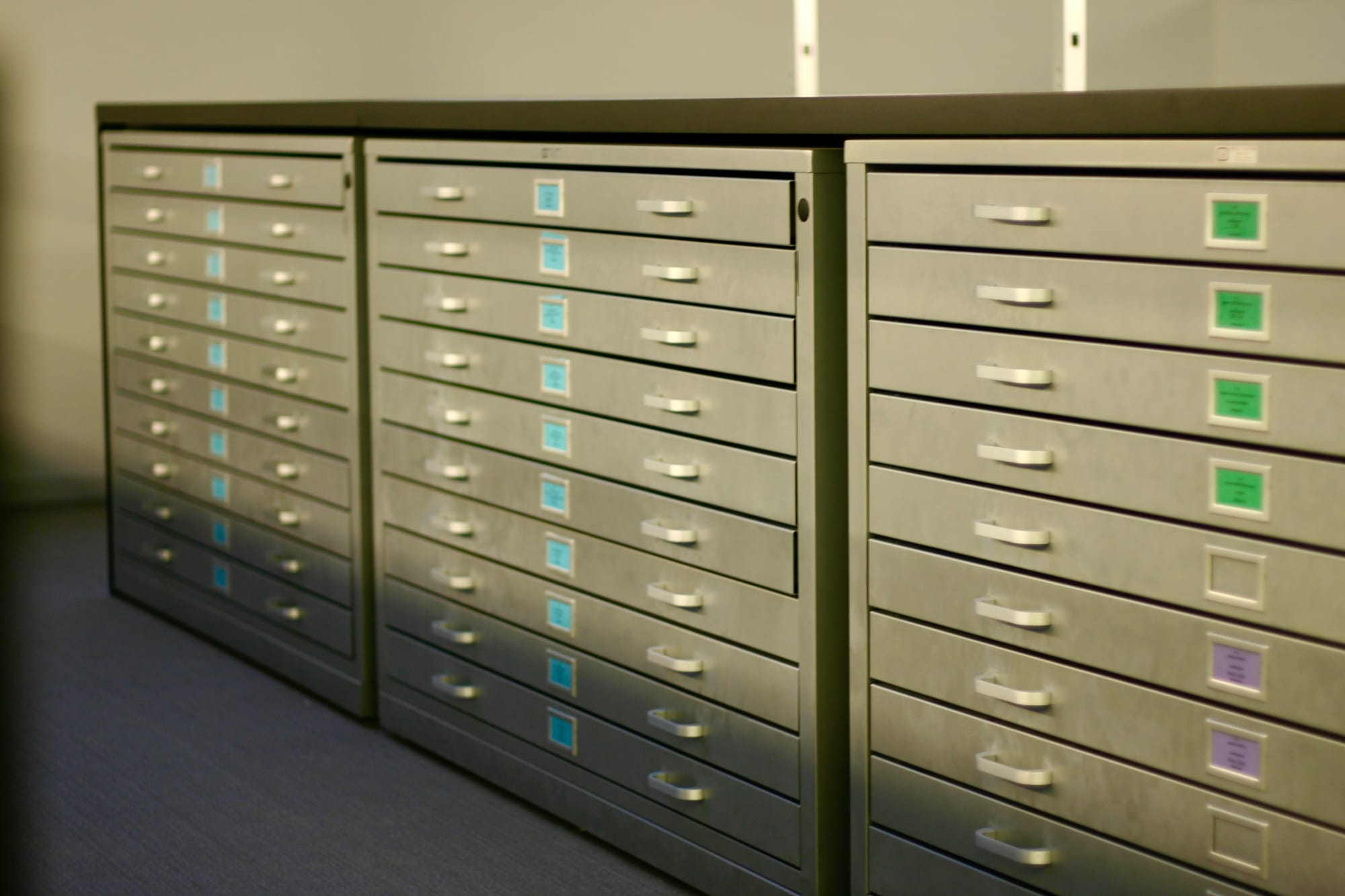BMO stadium in LA added AI to everything and what they got was a worse experience for everyone 20 Oct 10:49 AM (3 days ago)
I just got back from a 24hr trip to Los Angeles to catch my favorite Portland Thorns team, watching them clinch their playoff spot in a match at BMO stadium in downtown Los Angeles.
In May of 2024, I did the same trip to catch a match on Mother's Day, but I accidentally chose bad seats in the sun and it was hot and uncomfortable. Ultimately, it partially inspired my wife and I's book reviewing every NWSL soccer stadium so other fans wouldn't suffer the same fate when flying across the country to catch their favorite team.
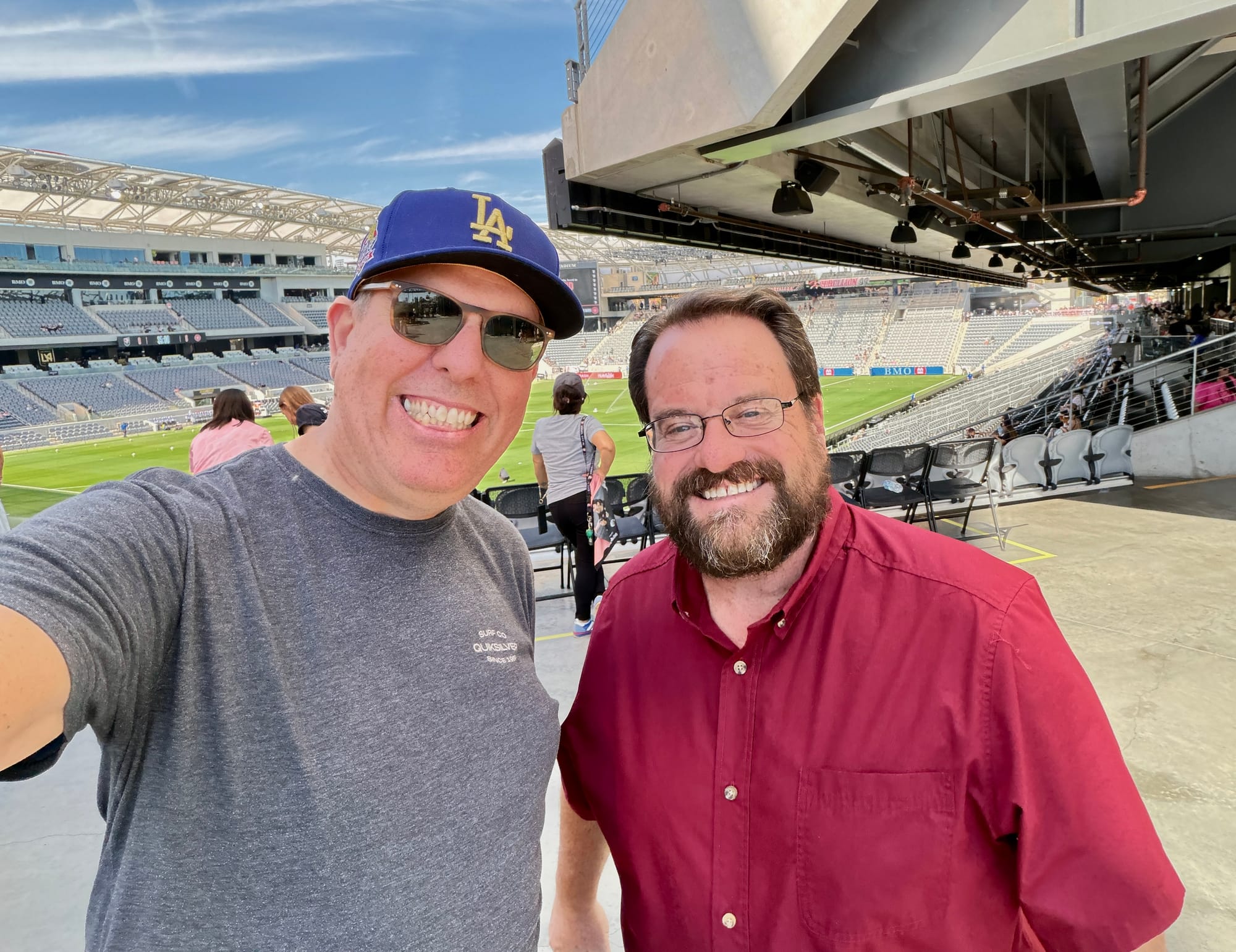
This year, I got better seats in the shade and enjoyed the game. But overall? The experience of being in the stadium was worse a year later. After thinking about it on the flight home, I think the reason was the stadium's rush to automation and AI in several places.
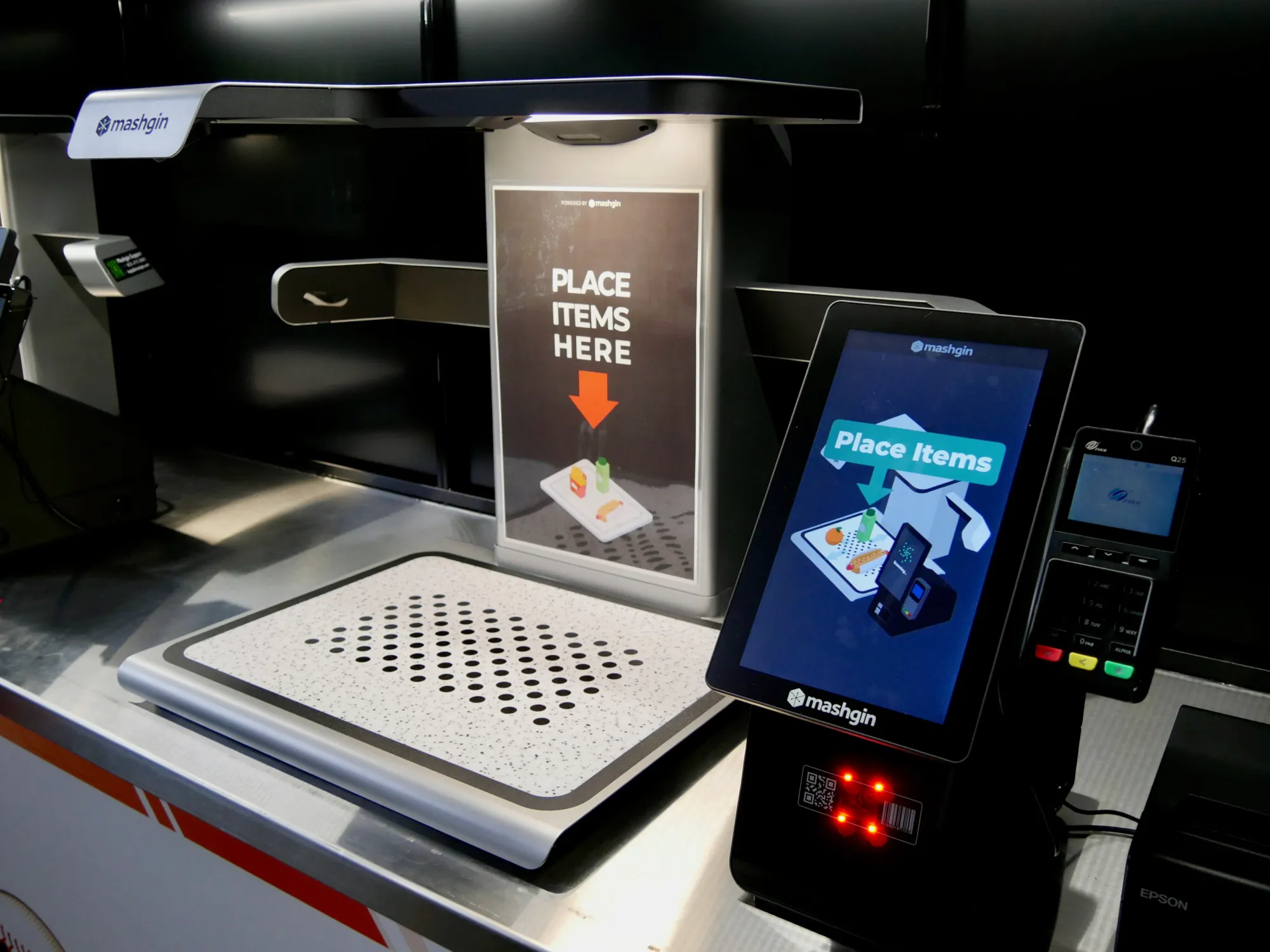
Spoiler alert: deploying camera/AI recognition for everything isn't great
Every concession stand, including the ones that didn't even serve hot food, used the apparatus in the photo above to control all checkouts. I assume these are expensive units, because most places that used to have several checkout lanes only had one of them, requiring everyone to checkout through a single location.
Here's how they worked in the stadium yesterday: You place all your items on the white shelf with some space between them. Although they were clearly designed to be a self-checkout experience, the stadium had a staff member rearrange your items, then for about 30 seconds the kiosk would be thinking. After, it would pop up all items on the menu, and the staff member would have to tap to confirm what each item was. Then another 30 seconds to calculate and move the purchase to a point of sale/tap on the side, then you'd pay.
Overall, this added at least one, if not two full minutes to every transaction that didn't normally have those delays. Lines were unbearably long, and it was a hot day in LA yesterday, at 87ºF/30ºC. I bought food and drinks several times over the the course of the day and had to endure the process multiple times.
When you add object recognition, you're incentivized to reduce choices
Here's an unintended consequence of moving all your concession stand checkouts to computer vision: it's easier if you have less things on offer.
Case in point: Let's talk about my favorite concession stand at BMO last year, a place that served rotisserie chicken with waffle fries and chicken sandwiches. Here's our meal from 2024, it was well-seasoned, came with great sauces, and was one of the best meals I had at a stadium in my entire nationwide tour, which is why I remembered it.
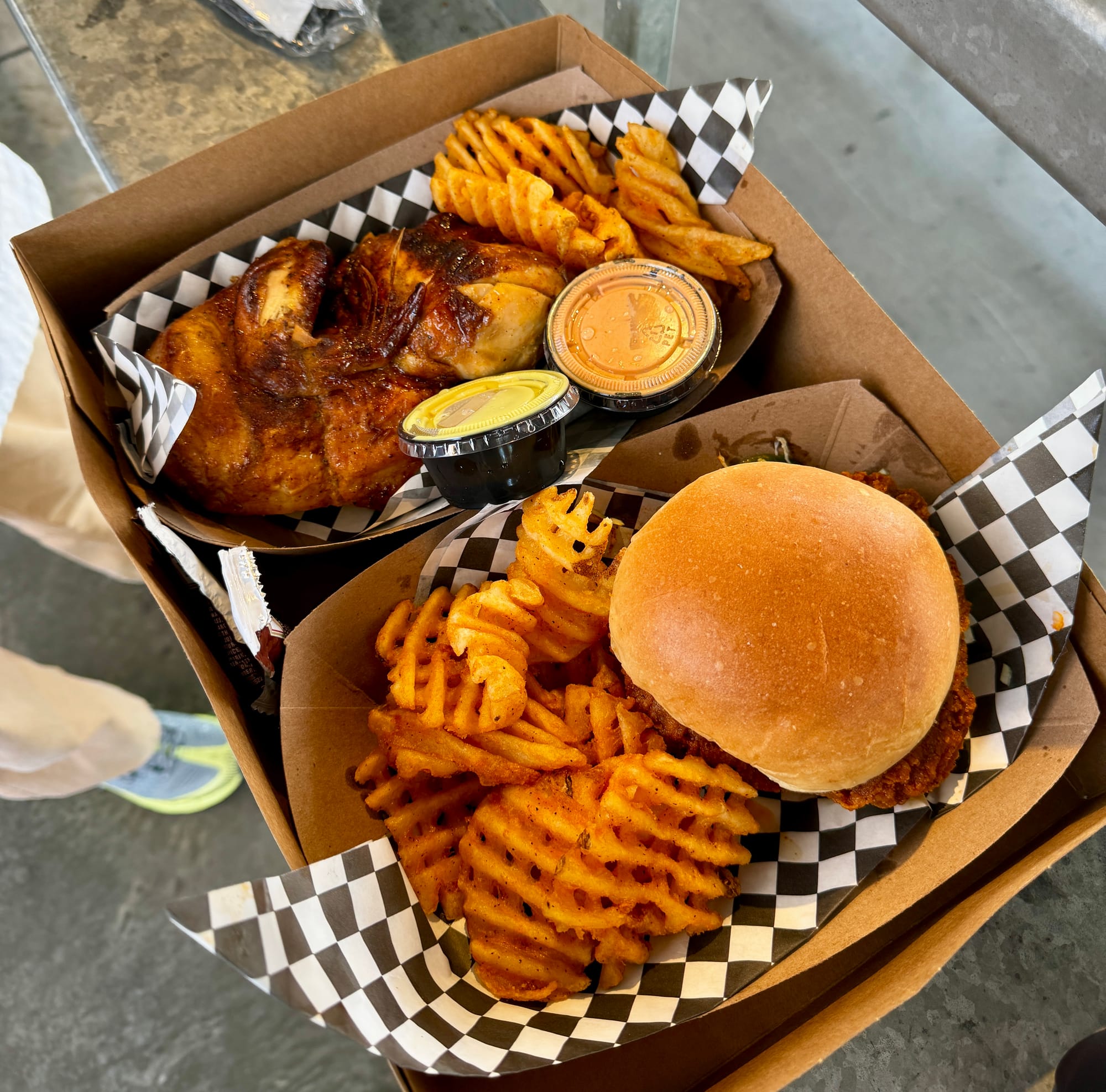
I returned to the same concession stand yesterday and here's their new menu:
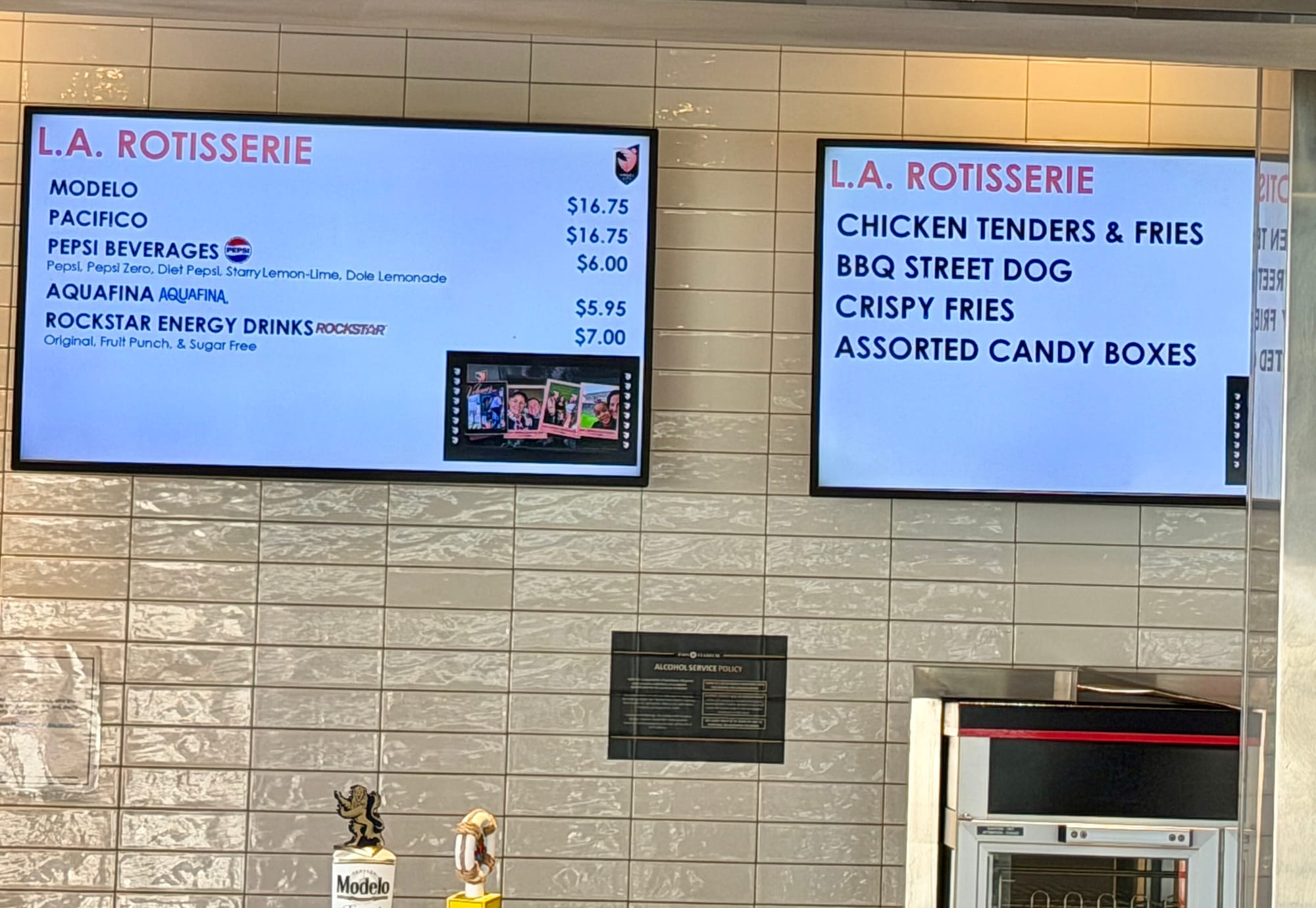
When your checkout stand relies on computer vision, it's probably confusing to have half a dozen different menu items that fans can enjoy. But if you could condense it to just chicken tenders, fries, a hot dog, and boxes of candy, your computer vision-based checkout system will probably work faster since it has to do less work with the obvious shapes of each of those items.
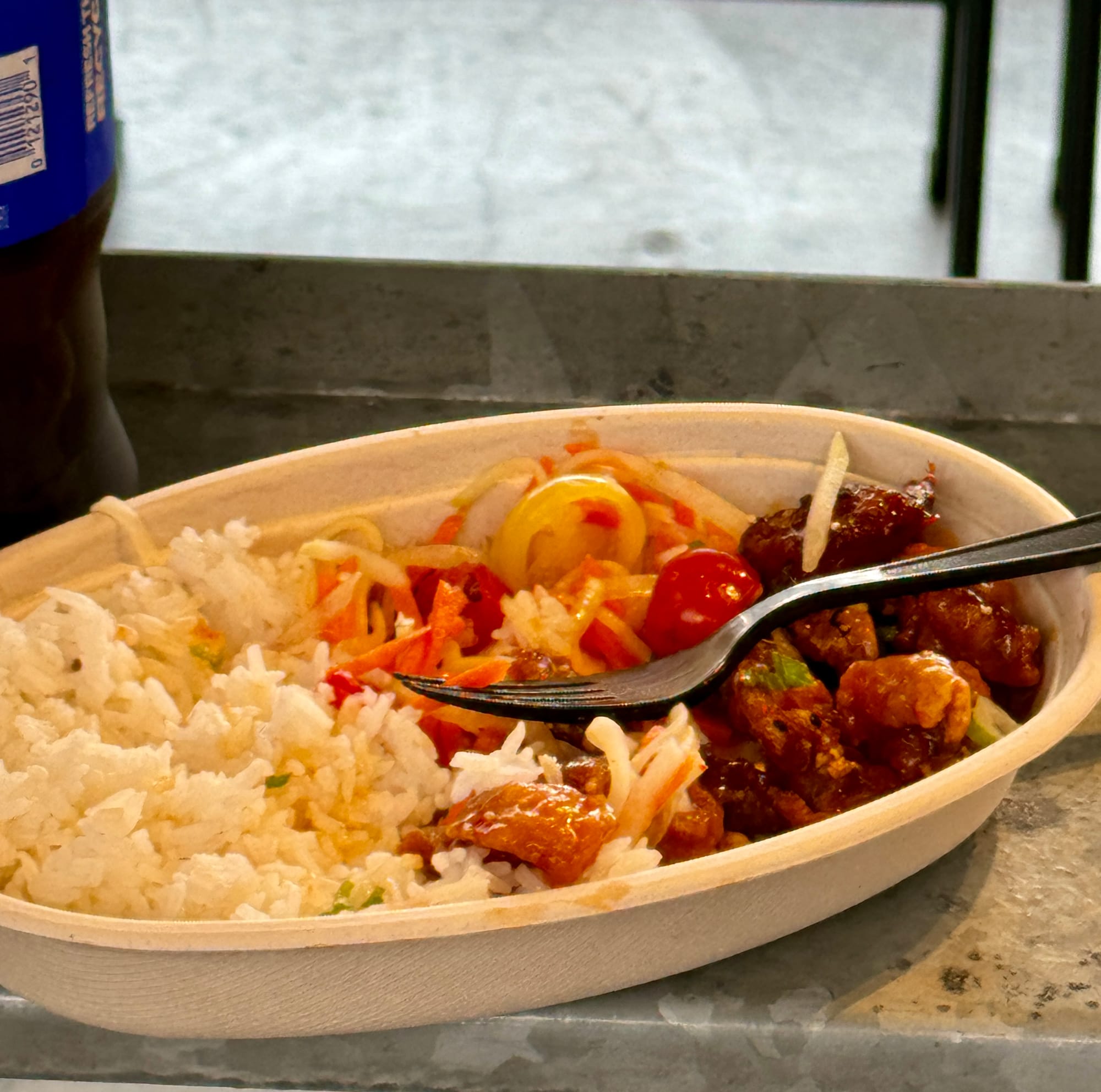
Looking through my photos from my 2024 visit, I saw a variety of food options including smashburgers and a Korean BBQ rice bowl I also tried, pictured above.
If foods are difficult for computer vision to decipher, why not get rid of most options? Walking around the stadium yesterday, the menus were basically all hot dogs, pizza, nachos, and chicken tenders.
Even quick service options sucked
As I said, it was a hot day, I was constantly parched, and I ended up drinking four bottles of water over the course of three hours. Each time, I had to go through the automated checkout gauntlet, and each time it required a long wait in a line, while I missed bits of the match.
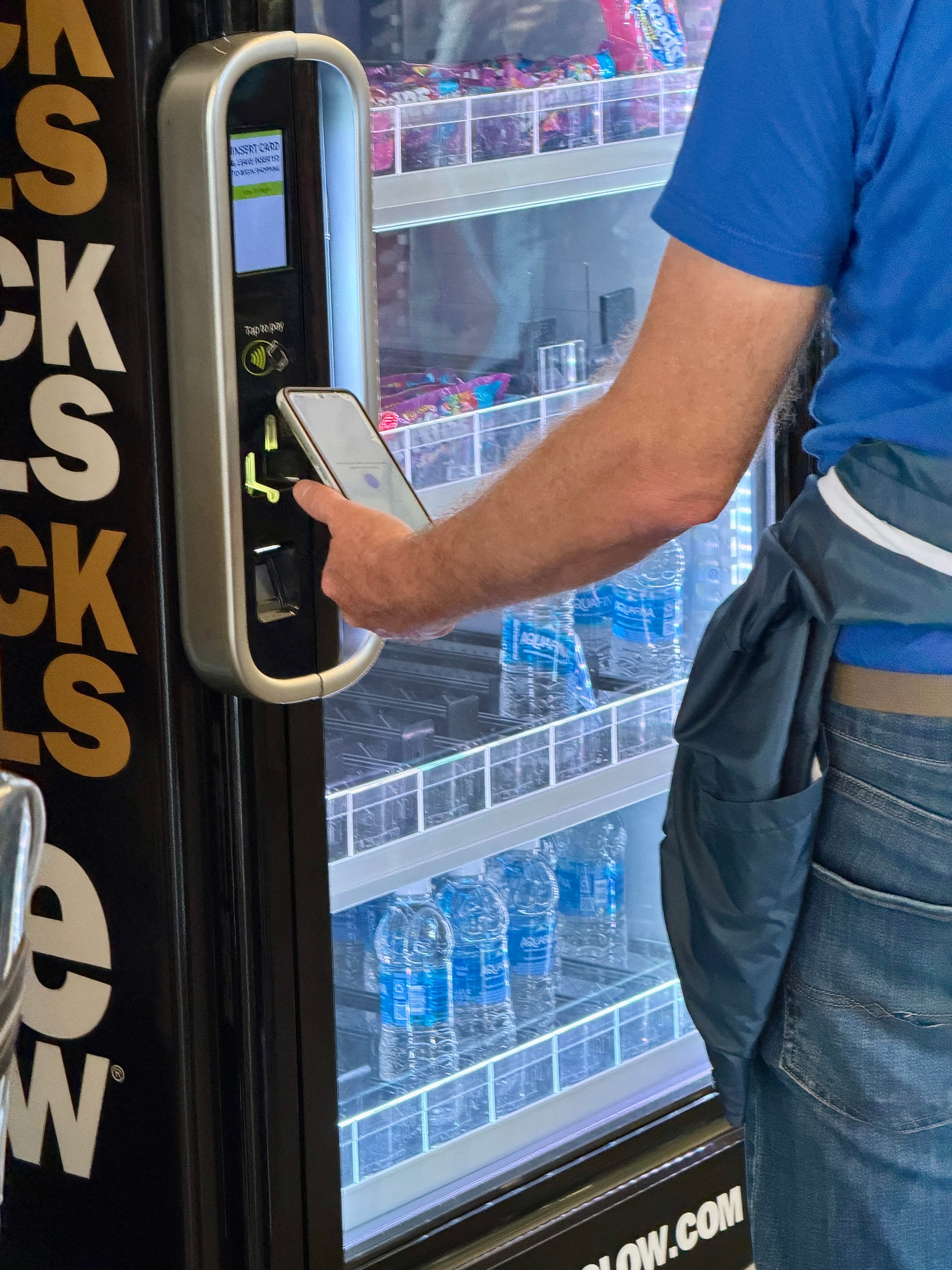
Late in the game, I wanted to get water quickly and they had these "vending kiosks" that were fully automated. You'd tap your phone on the locked door, it would unlock, you'd grab items, then close the door. Next, you had to stand there for about 2 minutes while it said "calculating checkout" before showing you a receipt on the screen.
What was supposed to be fast was very slow. The person in front of me bought two items and saw she got charged for three. Since there were no paper receipts, she took a photo of the machine before going to the guest services to complain. I missed ten minutes of the game getting water.
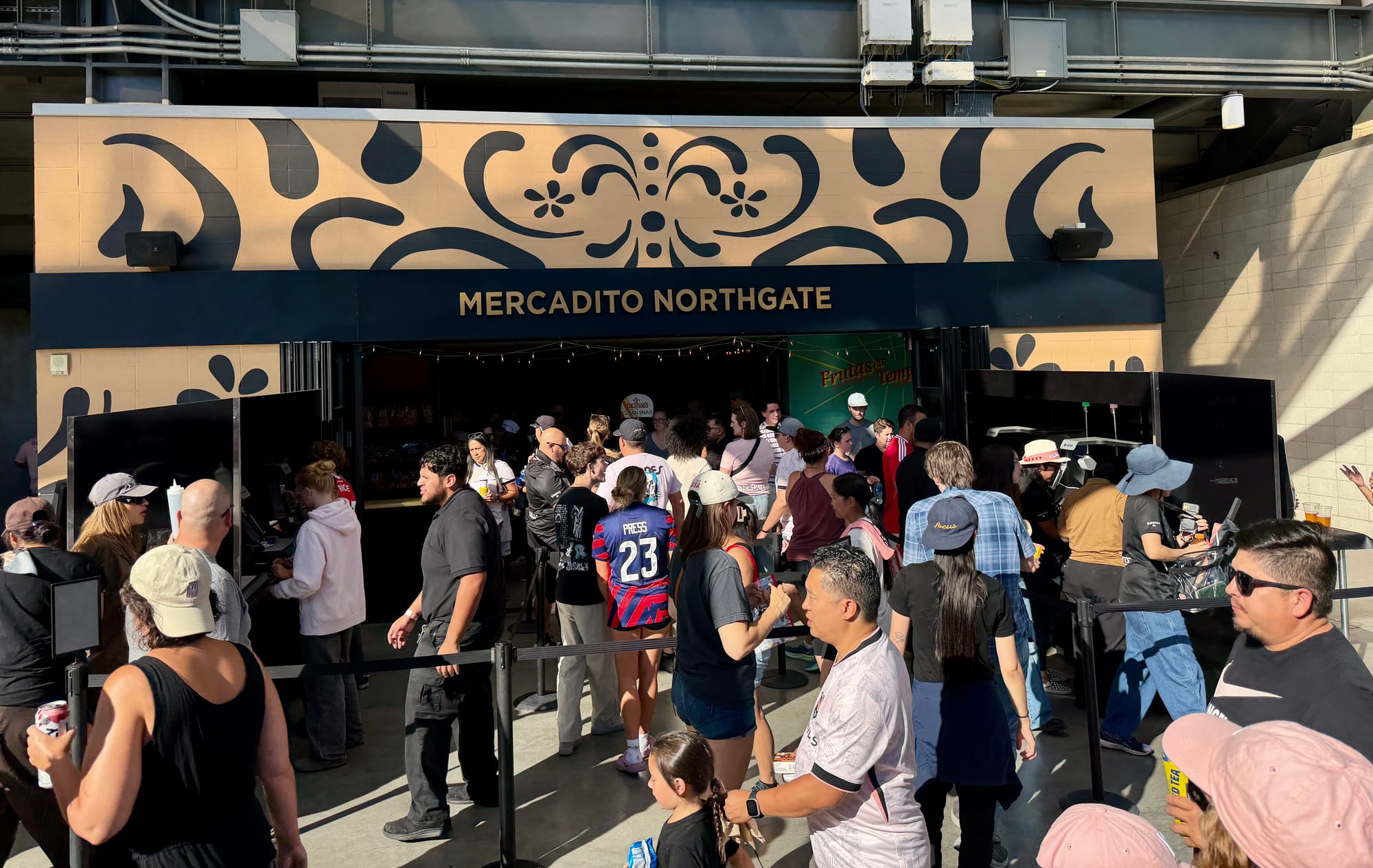
This was a quick service "market" style place and last year, you'd just grab stuff off a shelf, and checkout quickly from staff at multiple registers. This year, it had a long line snaking all over because of the slow AI/camera checkout kiosks.
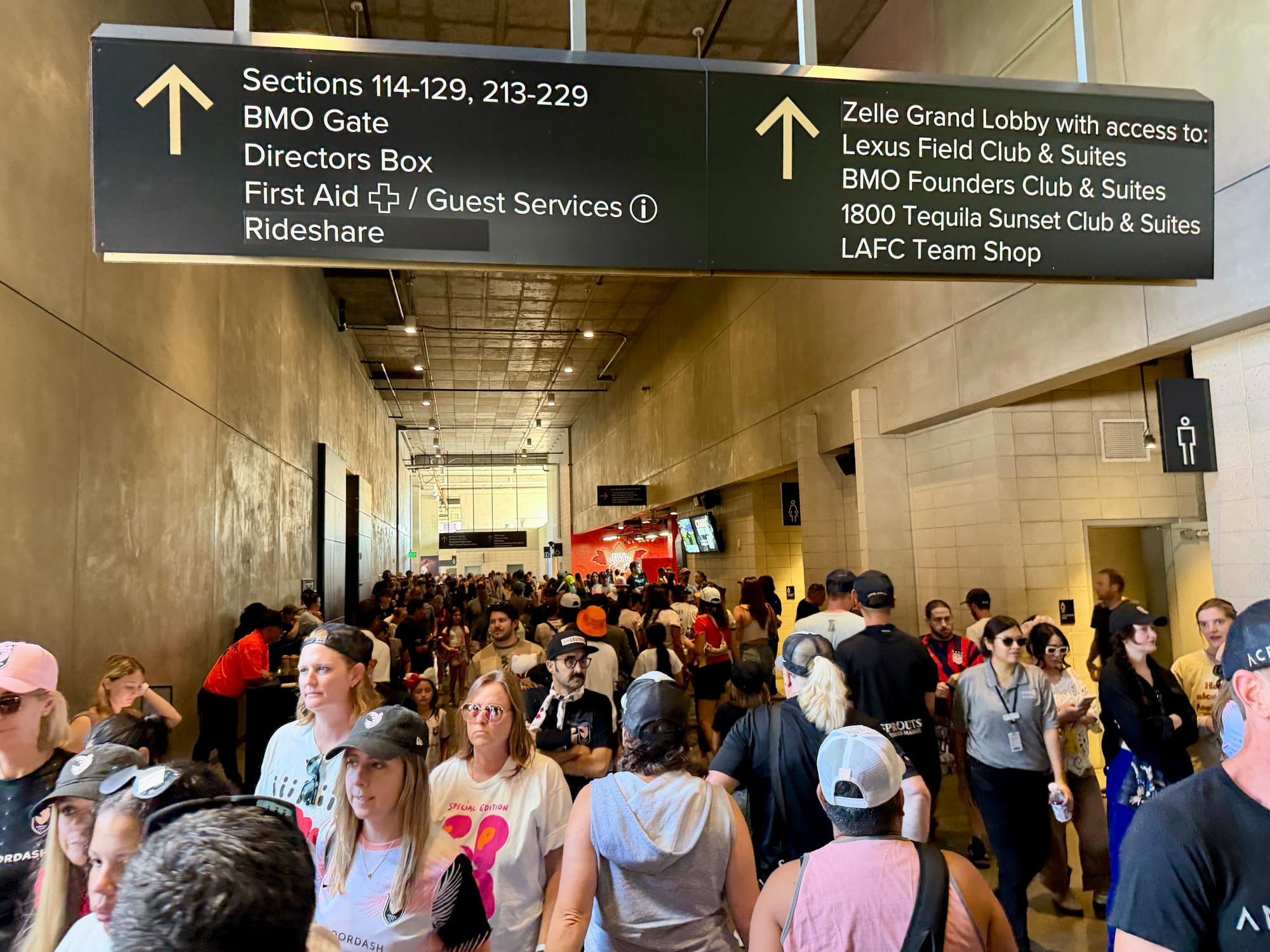
It was a busy game, being the last home match for the fans and I would guess there were around 17,000-18,000 people in attendance. When it's nearly 90ºF/30ºC, heat exhaustion becomes a problem for crowds. When it takes people ten minutes to buy a bottle of water (I didn't see automated water fillers at the restrooms), the embrace of slow AI/Camera-based checkout systems starts to become a health and safety issue for the crowd.
But Mrs. Lincoln—besides the obvious—how was the play?
A year later visiting the same stadium, I got worse food, slower service, and a worse overall experience. On the bright side, the billionaire stadium owners probably got to reduce their staff in the process while maybe increasing profits.
The company behind the kiosks claims they are 400% faster than human checkers and result in a 25% increase in profits. After experiencing it in person yesterday, I think those numbers are bullshit. Human checkers are clearly faster and smoother, and I bet they sold more food and drinks when people could get them quickly.
And the portions? They were so small!

Recent camping and travel discoveries 13 Oct 12:11 PM (10 days ago)
Let's be real: camping can be uncomfortable and unpleasant, which is why a lot of people don't do it. Sometimes, it even sucks, especially when it rains unexpectedly, so anything I find that takes the edge off of "roughing it" is welcome to me.
After a summer of camping and traveling around the western US, I wanted to highlight my favorite discoveries that truly made camping and traveling better.
An inflatable camp light
I bought a small, ten-inch long, inflatable, usb-c rechargeable light this summer for camping. It was about ten bucks on Amazon and the brand I bought currently only shows a 2 foot long version.
It's a small light that collapses into a bag, is quick to inflate to full size, and it can run for several hours on a charge over multiple nights. It's a soft LED that lights up and has two levels of white light (high/low) and also red and red flashing options. It's even got a magnet on the back so if you're stopped on the side of a road you can use it as an emergency flasher by sticking it to your car.
It quickly became our inside tent nightlight after dark, as well as a soft lantern around camp. You could also use in lieu of a flashlight for trips to the bathroom without blasting out your night vision with a typical flashlight.
The small one I bought was cheap, super useful, and honestly was one of the best little camping upgrades I tried out this year.
Going all electric while camping
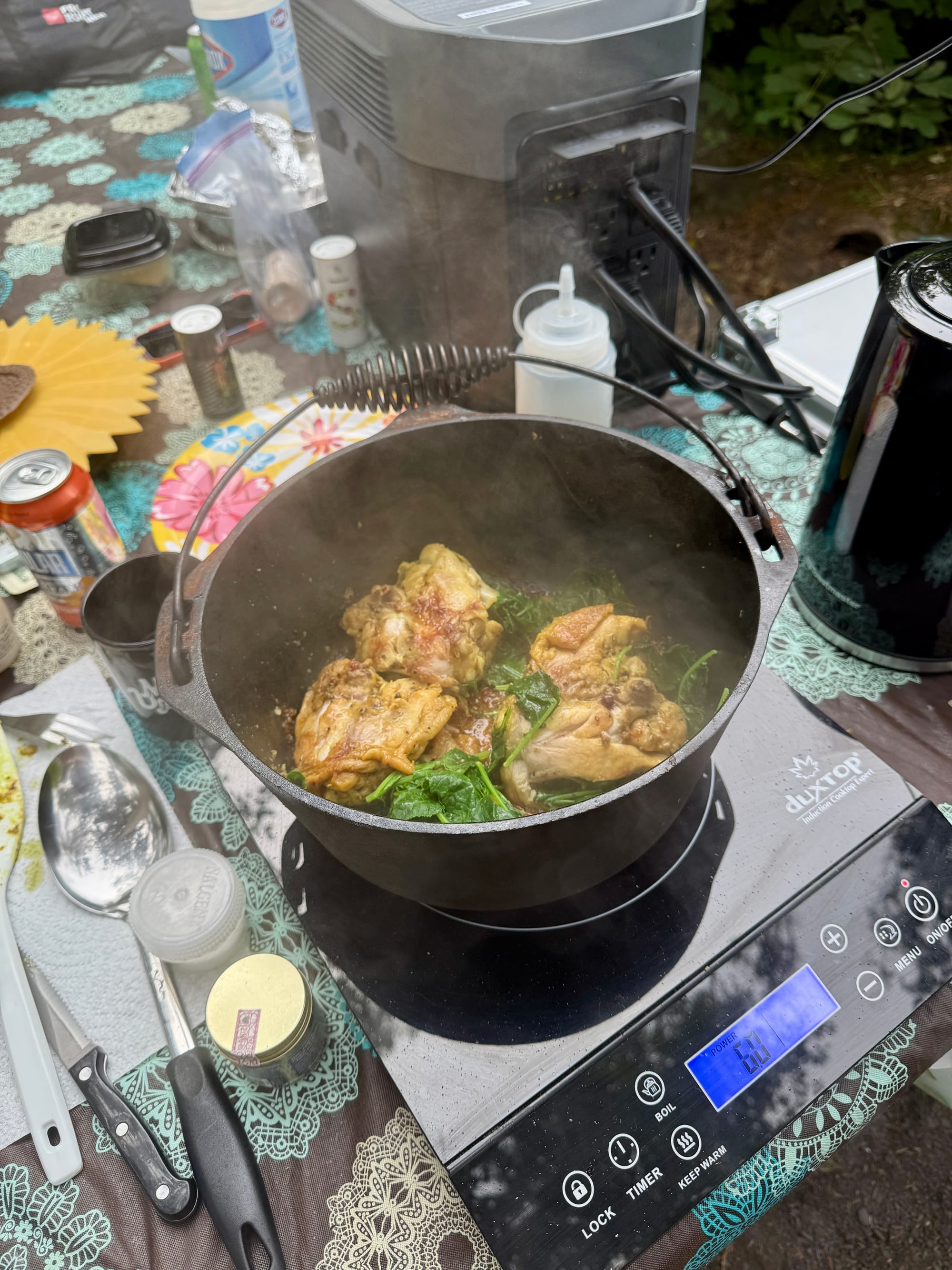
Everyone loves a campfire, but with increasing burn bans in effect in the mountains and forests, it's getting harder to enjoy a campfire safely and you can't always depend on it to cook. Personally, I‘m also tired of using up those green propane tanks on camp stoves, and wanted to try going full-electric on a trip.
The backbone of it all was my EcoFlow Delta 2 Max battery that packs 2kW of power. Next we used a Duxtop induction cooktop that America's Test Kitchen recommended for anyone wanting to test the waters with induction cooking versus gas. We grabbed a cheap plug-in kettle to boil water for our drinks and to make hot water for washing dishes afterwards. My Iceco 20L fridge ran off the battery instead of having to pack ice in a cooler. We also had good luck with a Starlink Mini for internet in remote places with no cell signal.
Overall, the best experience we had was in the photo above, at an Oregon state park on the coast because it had a power plug available in our campsite, which kept our battery topped up at all times. On more remote trips, I tend to get 2-3 days of heavy use per full charge. Ideally, if you drive your car a bit each day to a trailhead or into town to get supplies, you can recharge the battery as you drive in a couple hours. For a battery of this size, solar wasn't optimal in my experience, as my 150W panel would take many hours to refill the battery completely.
Overall, getting instant hot water within 5 minutes, cooking killer chicken and potatoes in a dutch oven on the induction, having cold food and drinks that weren’t covered in ice water, and being able to upload photos to the cloud during the trip were all amazing creature comforts made easier by all-electric camping. It's also a bonus when you're not burning gas while cooking—if you get stuck in a rainstorm, you can safely cook inside your tent on induction since it's entirely free of dangerous fumes.
Optimum sleep while car camping
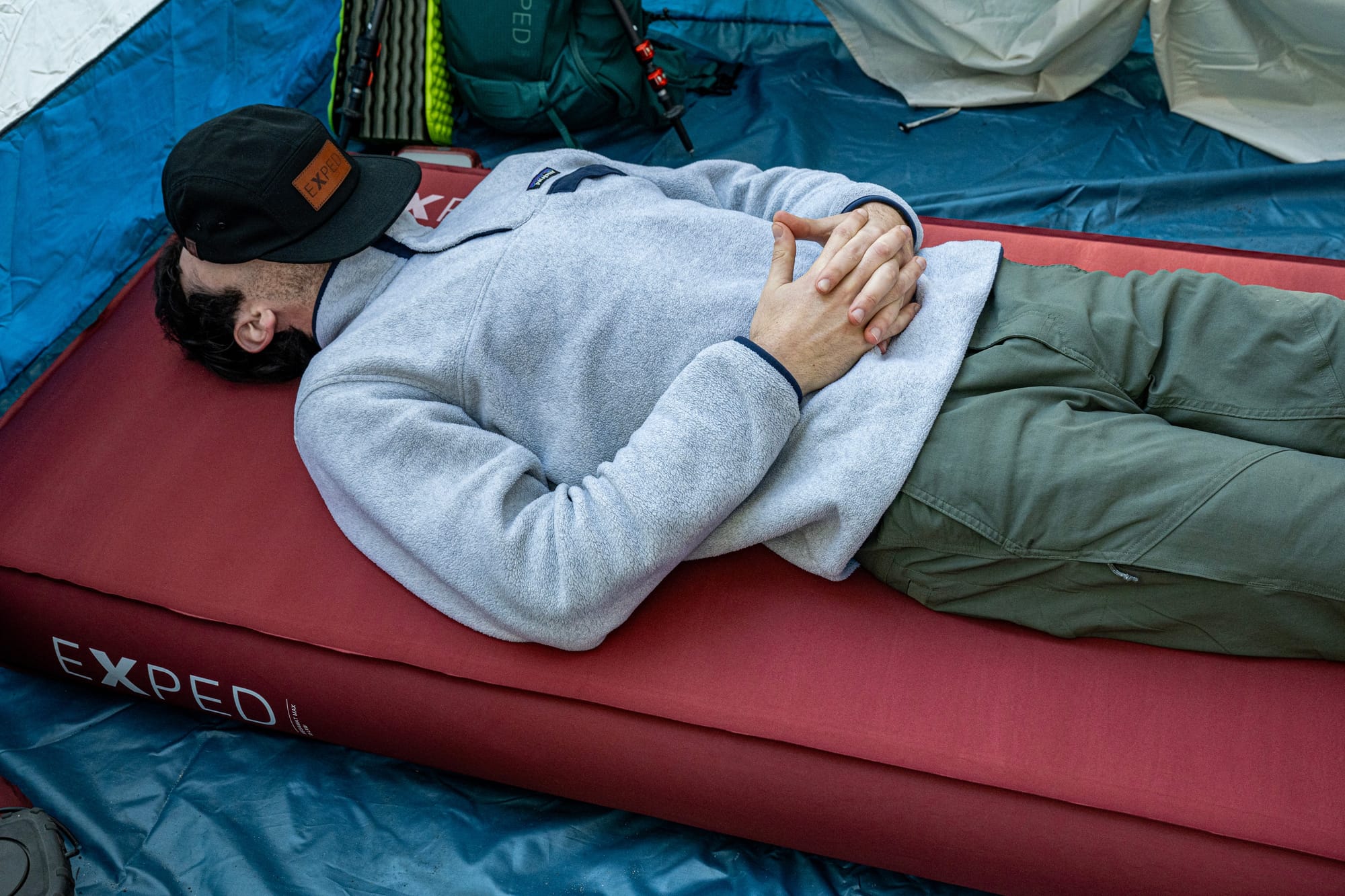
I had some bad nights sleeping outside this summer so I decided to go down the reddit rabbit holes of what was possible and I landed on the Exped MegaMat Max sleeping pad. It's a large, wide, 5" thick inflatable mattress and it's the first outdoor experience that truly came close to feeling like my home mattress. On my last trip using it along with Exped's sleeping bag designed for it, I got great sleep while out in the wilderness for the first time in years. The Exped mattress isn't cheap, but I will say it's worth the price and it'll be what I take car camping from here on out.
Another tip: I used a down comforter instead of a sleeping bag on a different trip and really loved it. Sleeping inside a cocoon of a bag is unusual and I sometimes wake up with a cold leg dangling out or a twisted bag I have to unravel to get back to sleep, while a comforter feels much more natural, like sleeping at home.
Various small tips
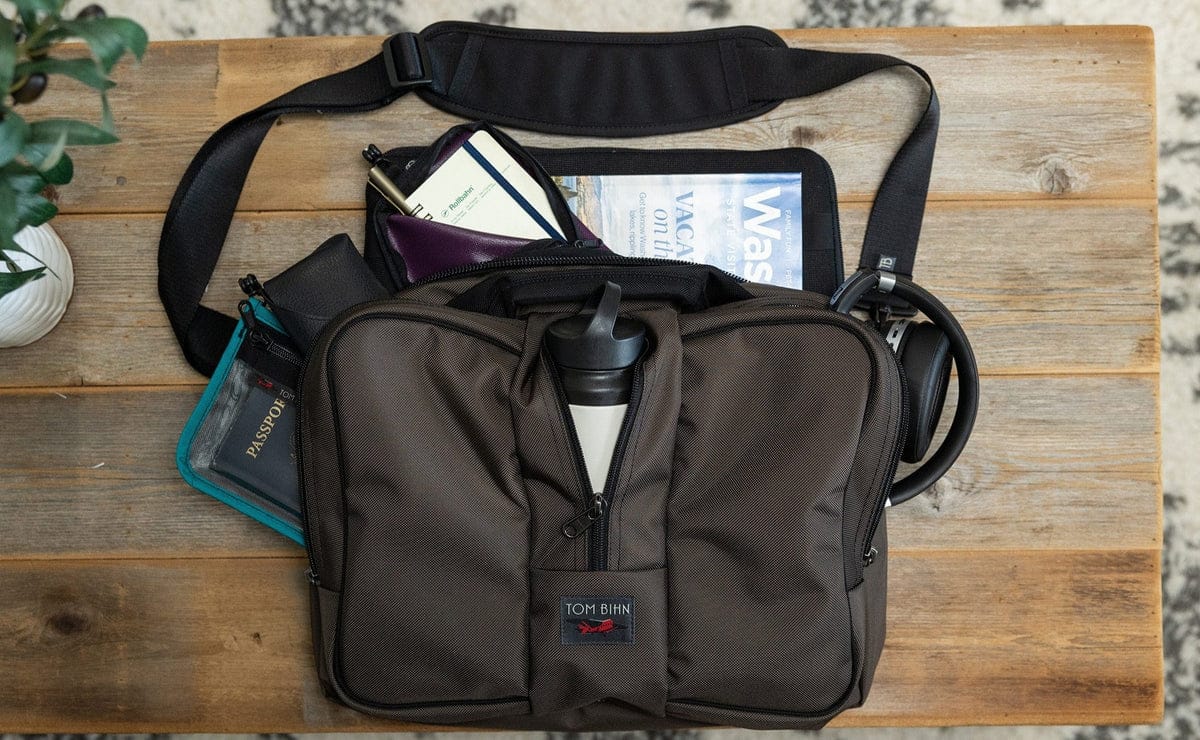
I finally followed advice I've heard for many years, which is: buy a small bag that is dedicated to your electronic items needed for travel, and keep everything in that bag, always.
I bought a Tom Bihn Copilot bag a couple months ago and I keep it stocked with a wall charger, two usb-c to usb-c cables, an Apple Watch charger cable, and a lightning cable. It has a slot for a water bottle and I toss in an iPad with downloaded movies along with my AirPod Max headphones before any trip. It's a great carry-on for flights and it's easy to stash in my car on road trips. I don't know why it took me so long to finally set up a dedicated travel bag, but it's like having a dop kit always ready to go with a dedicated toothbrush, toothpaste, deodorant, hair stuff, and soap. Make a promise to yourself that you’ll never plunder a cable out of the bag when you're at home and it'll always be ready for any trip.
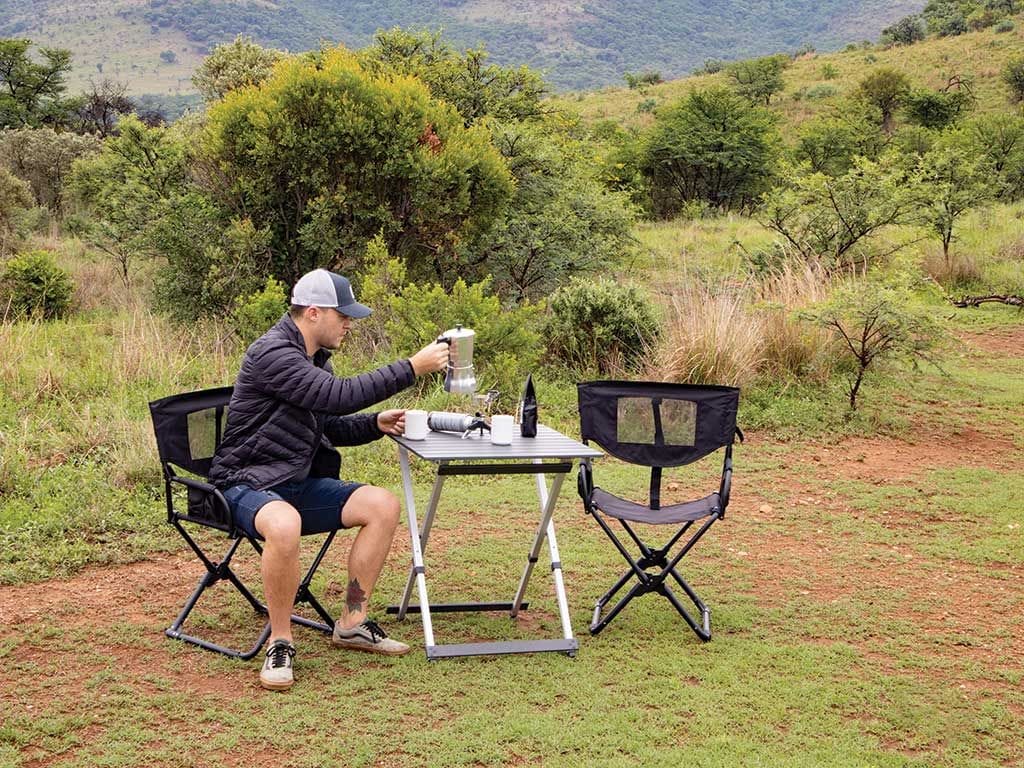
I feel like I spent the past ten years trying to find a folding camp chair that was comfortable, could be deployed in seconds, and was compact and not too heavy. I've tried every kind of cheap and expensive option before and eventually I fell in love with a pair of Front Runner Outfitters folding camp chairs along with its own storage bag and a small folding table that goes with it.
The chairs fold down small and pop out in seconds. They're comfortable directors-chair style seats and the table folds out instantly. I use these not only in every campsite but also for any picnics on the side of the road.
Another great thing to have on a camping trip is a hammock. You can find cheap, strong nylon hammocks with all the necessary straps for about $30-$40 these days from any outdoor store and I spent several summer afternoons happily swinging between two trees, napping, relaxed as could be.
Lastly, I highly recommend buying any knock-off version of a large YETI-style ice chest. On one trip this summer I was totally amazed that our $99 YETI knockoff plastic ice chest from Costco kept ice blocks and ice cubes frozen for 5 full days, even with frequent opening and closing of the ice chest to get supplies throughout the week. You can't beat physics, and having several inches of air gap between your cold stuff and the outside of your cooler is a total game changer.

September 9, 2020 9 Sep 11:44 AM (last month)
Five years ago, during an already messed up year, we had widespread wildfires in the Pacific Northwest that combined with a high pressure front and gave us hot, stale air currents that produced the worst air quality I've seen in over 20 years of living in Oregon.
I recently did some research on environmental risks of the Pacific Northwest, and "air quality" was the third highest risk after fires and earthquakes, largely due to that September 2020 event when AQI readings crested 500 for days all over the state.
Here's a screenshot of AQI from the 13th, and it's still quite bad. I seem to recall it took a week or two before it finally rained and "washed away" the bad air after the high point. I remember at the time not going outside much during that time and not being able to exercise at all, while working from home and still largely house-bound thanks to covid.
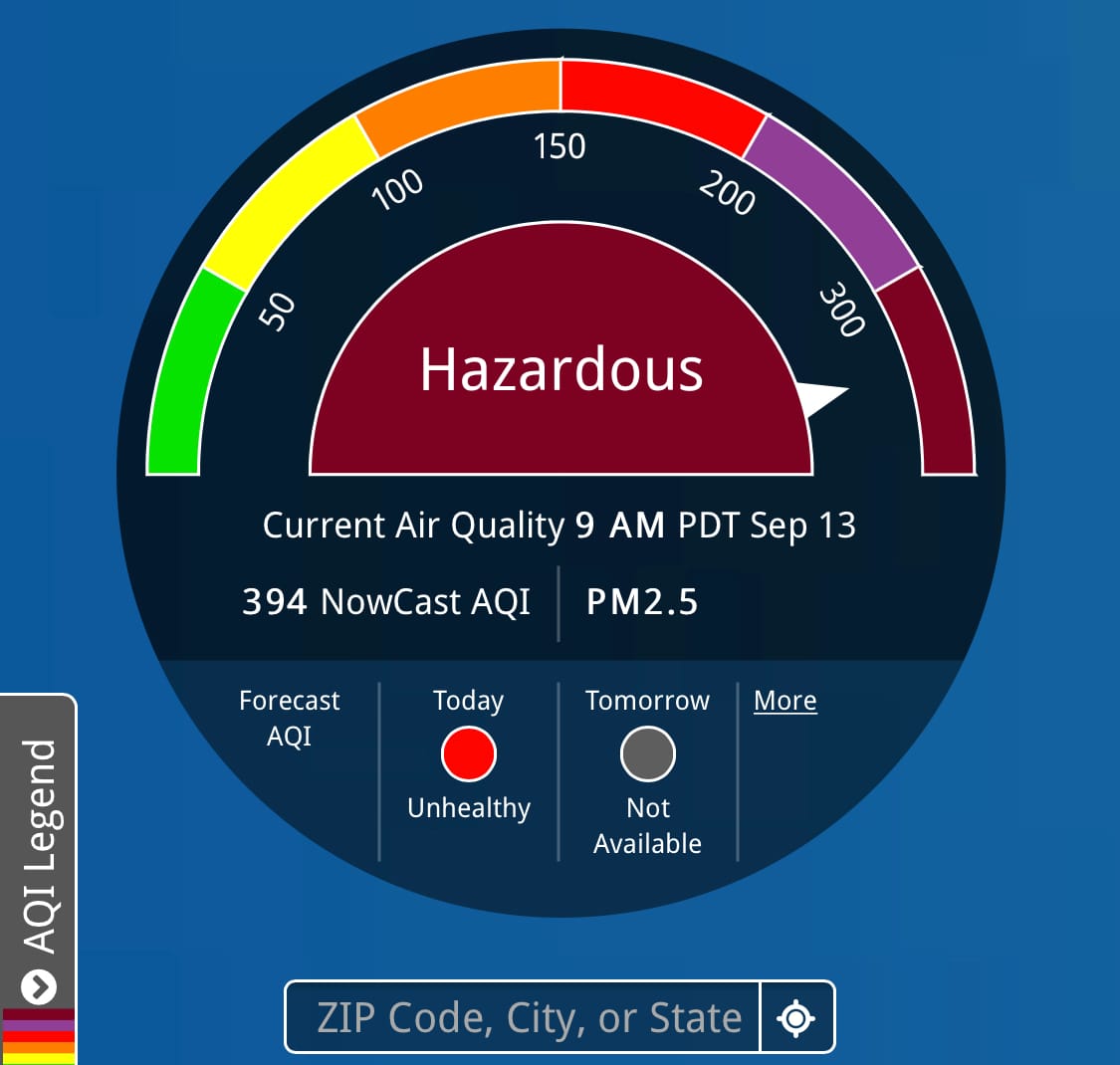
More shots
Here are my photos of the worst of it, from 9:55AM on the 9th, when I stopped at a McDonald's drive through to grab a McMuffin. This was the morning sky, and it helps to have some familiar signage to compare against.
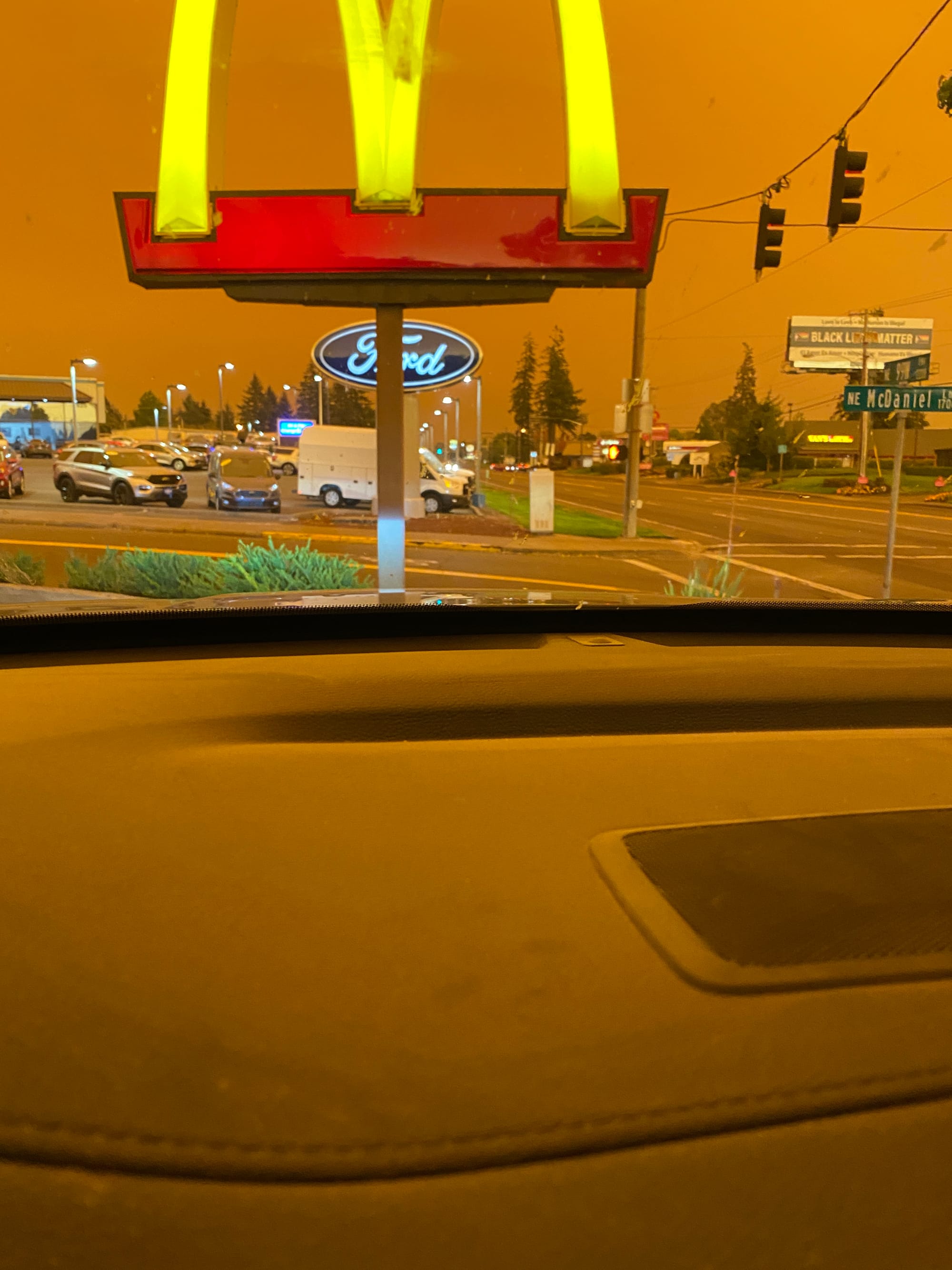
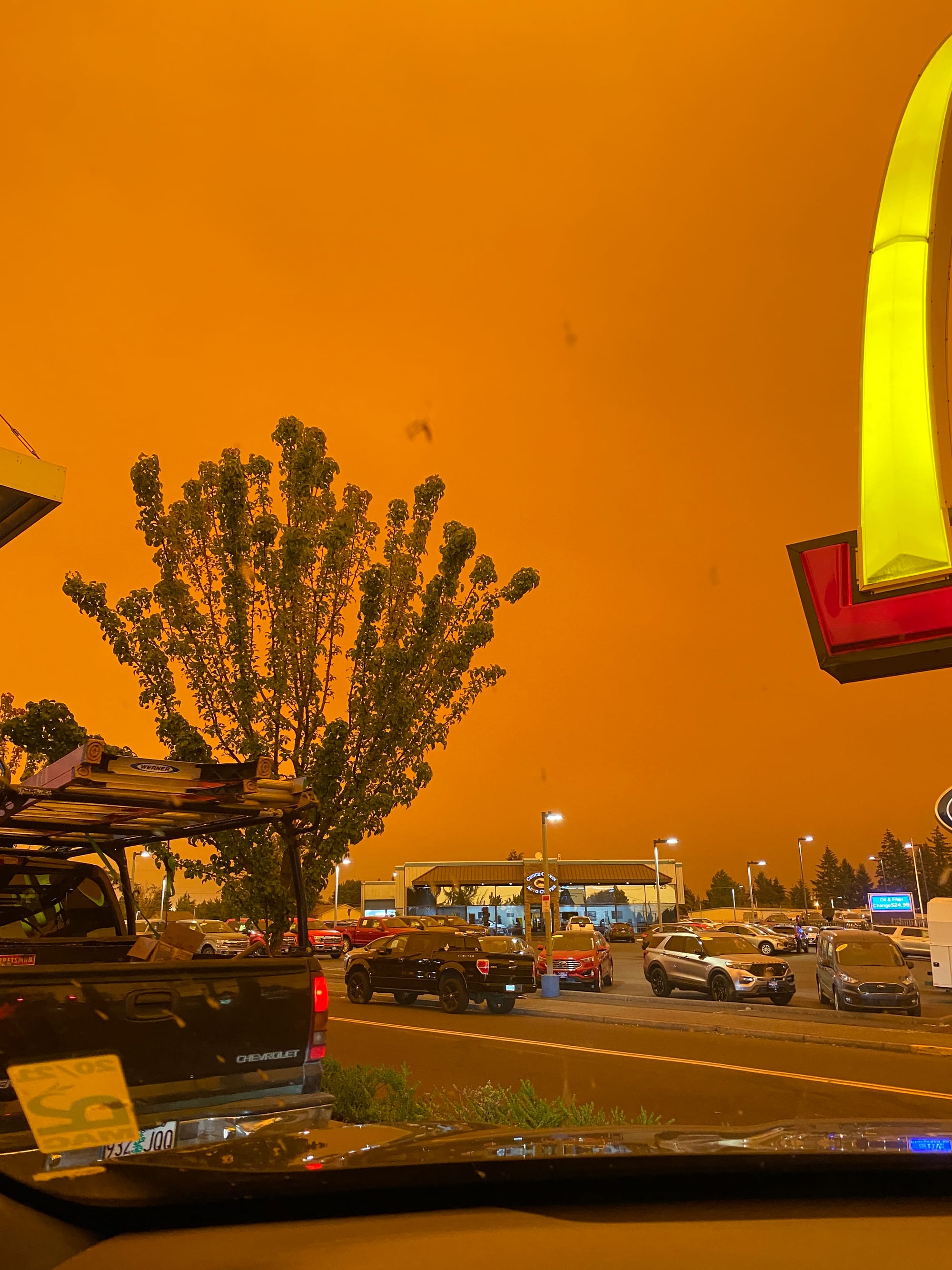
Here was part of downtown McMinnville, Oregon also on that day.
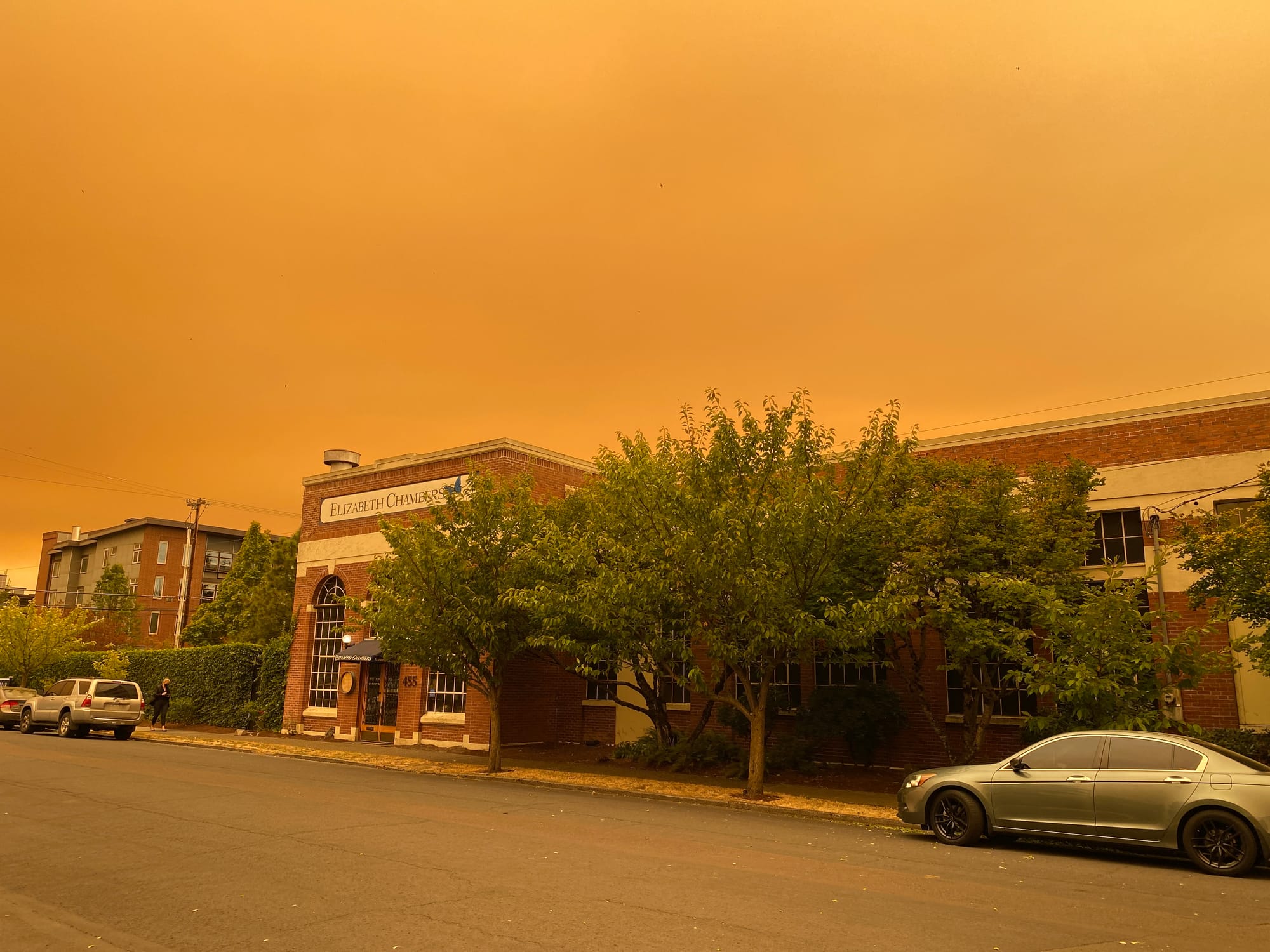
In the afternoon on the 9th, my daughter and I set out on a road trip to see the California Coastal Redwoods that we'd been planning for weeks and the orange sky followed us.
We headed out to the coast then pointed our way south. In the late afternoon, about halfway down the Oregon Coast we still had pretty bad air quality near Florence, Oregon.
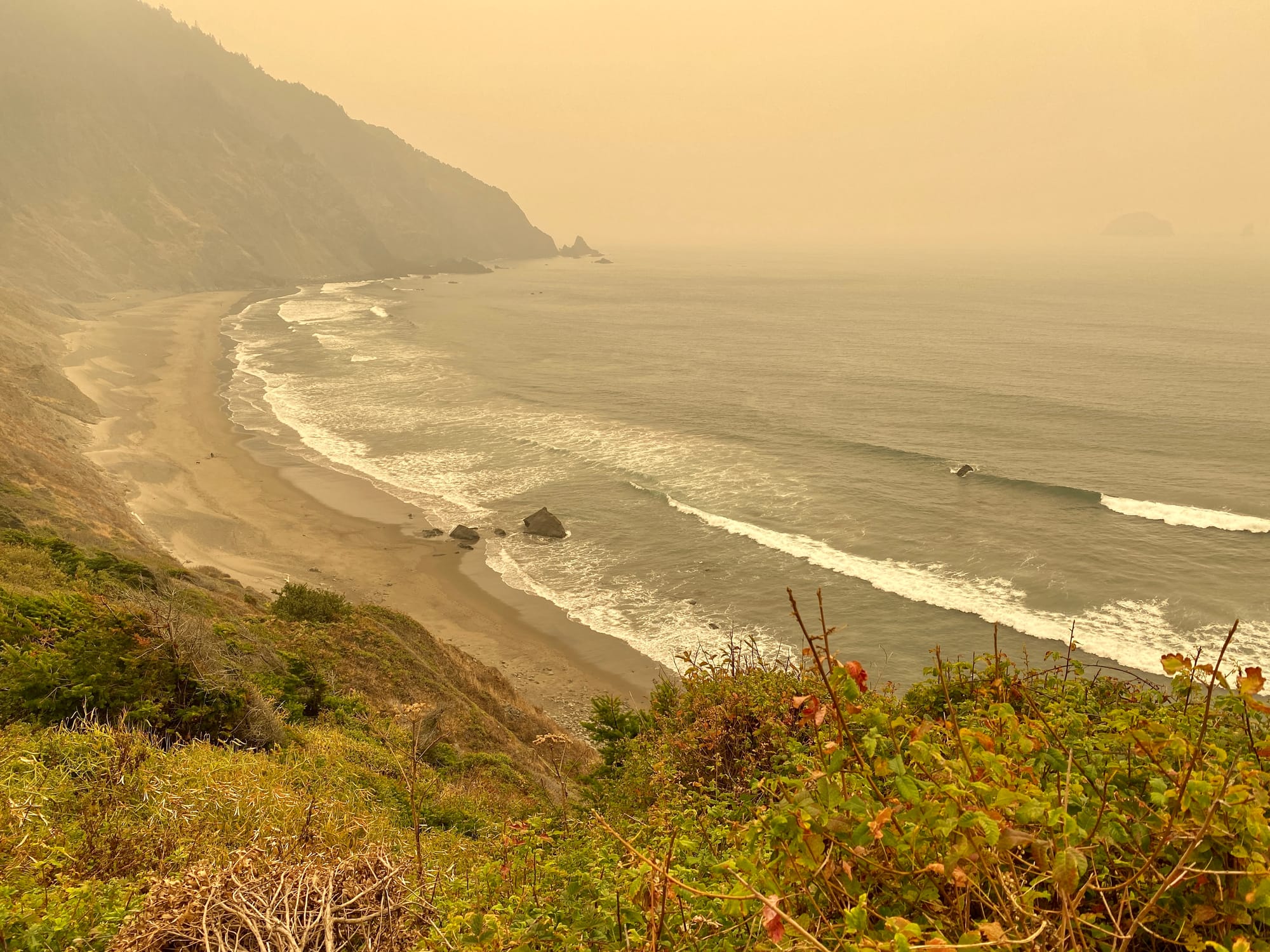
We made it down to California the next day and enjoyed our time as far away from the PNW fires as we could, but as you can see from this famous roadside landmark, air quality was still pretty bad 500 miles away.
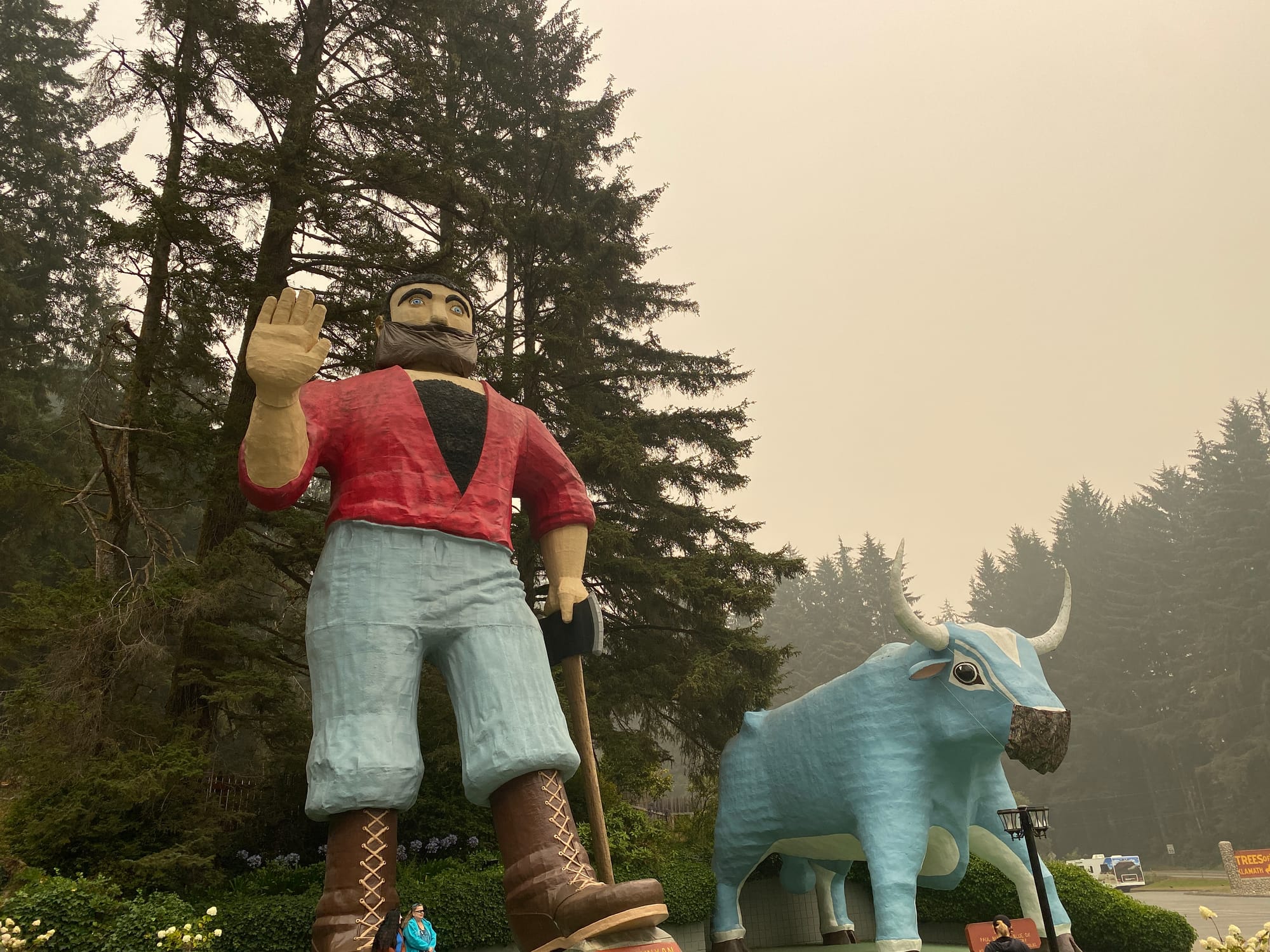
It was a quick trip and we returned a couple days later.
Another weird relic of the time
I happened to load up Craiglist while looking for a used car during the week of the fires and you could instantly tell which sellers took their photos that week.
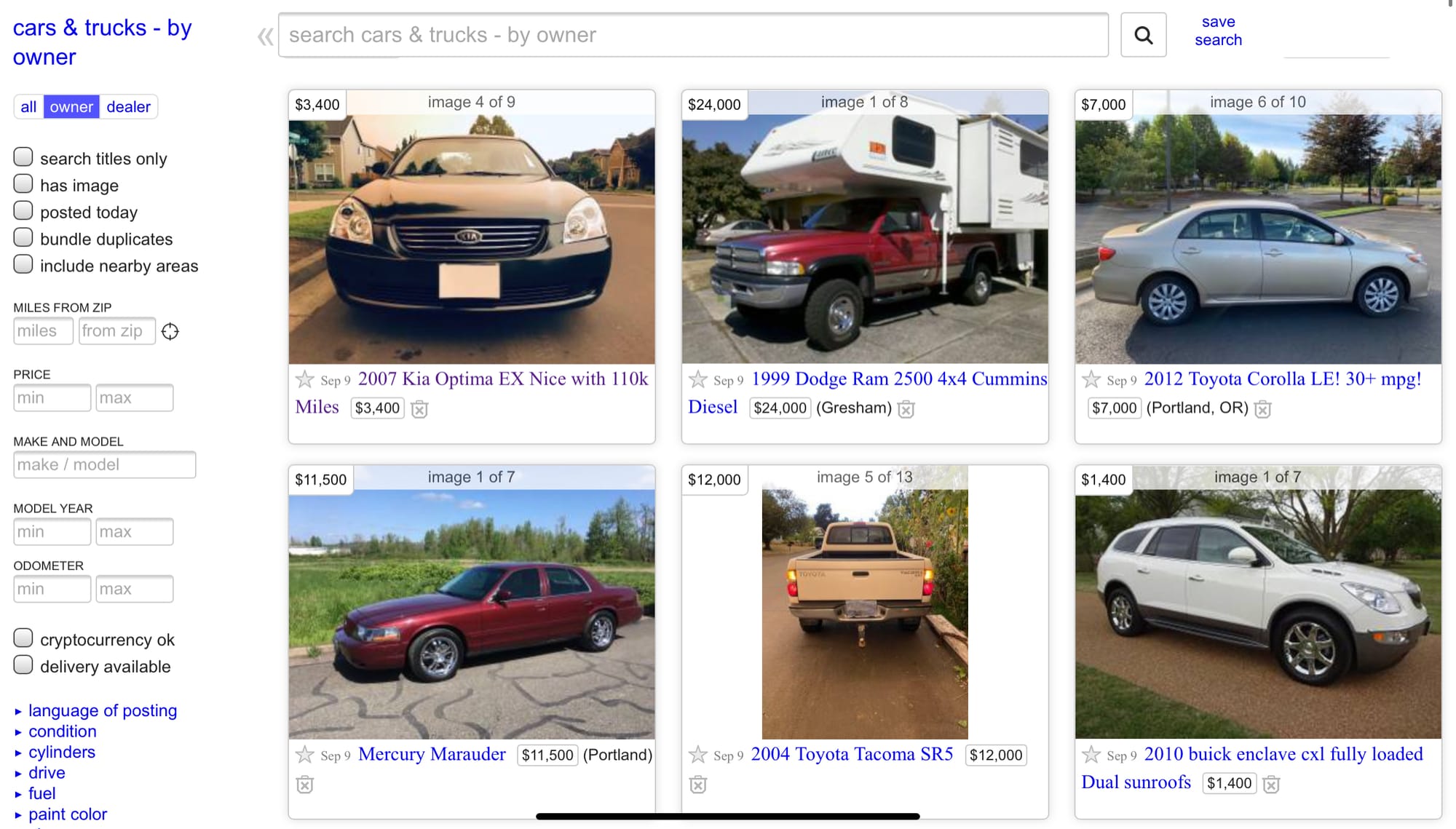
Here's a single listing where you can almost pinpoint the day they took the photo based on the sky alone.
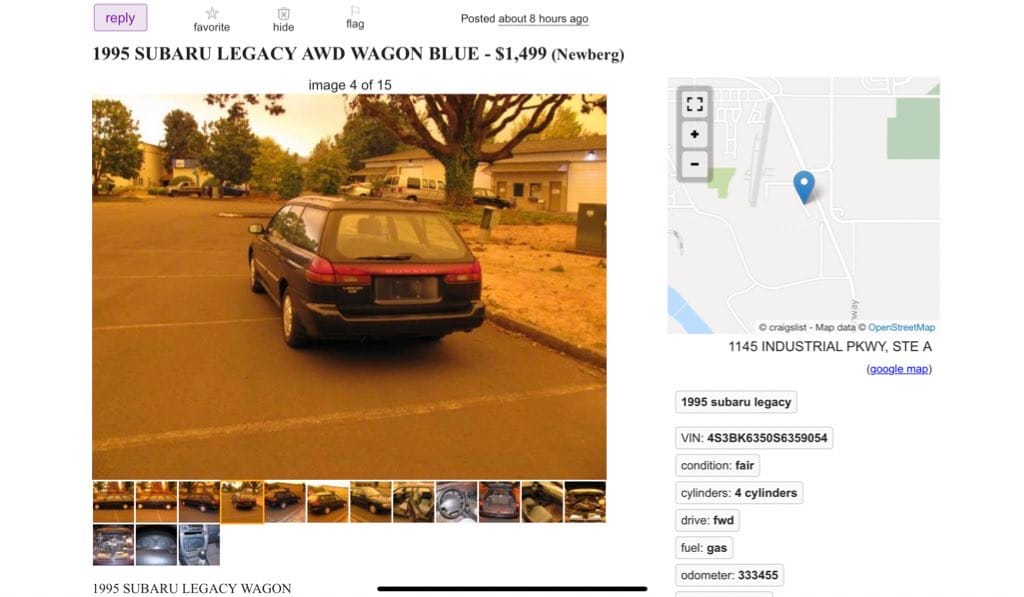
Monitoring air quality
We moved into a new house in 2019 and I just happened to buy a couple AWAIR air quality monitors back then for my bedroom and office. At the time, I got them because I was told the house was really air-tight thanks to its modern construction, so much so that it required an air exchanger that ran each morning to bring in fresh air. I wanted to make sure that all kept working, hence the AQI monitors inside the house.
Having them was great because we could tell any time we opened a window for more than a minute to let in cold air at night, or even opened a door to come and go, our AQI numbers would go from 50 to 100+ almost instantly and we'd have to shut everything up again.
2020 was a gnarly year. Covid, lockdowns, elections, police killings and subsequent protests, then on top of it all, much of September spent keeping our house closed up, changing air filters weekly, and running fans with air filters duct-taped onto them all over the house while we tried to get some sleep.
I wonder if 2020 will go down in history like 1968 did, since it seemed like the entire world was falling apart in front of our eyes.
A rabbit hole 4 Sep 9:45 AM (last month)
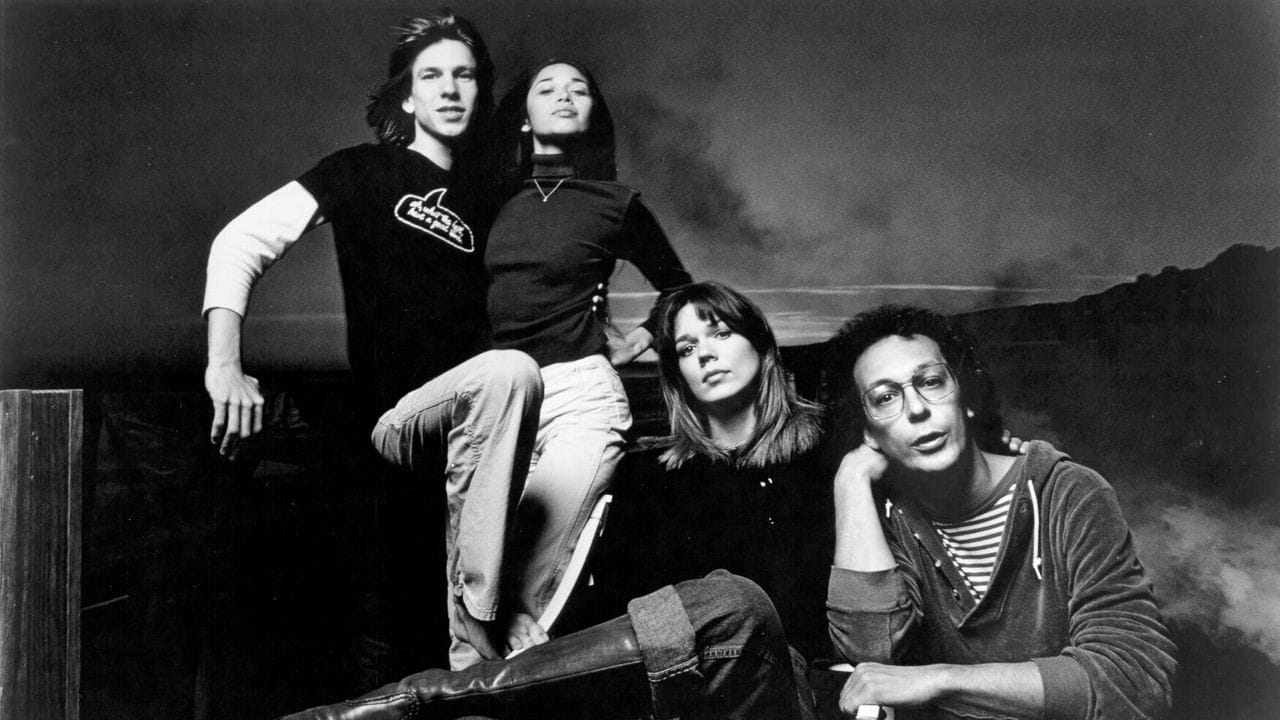
Last night, I went down a rabbit hole around the music group Starland Vocal Band, and their weird one-hit-wonder sex song Afternoon Delight that reached #1 on the Billboard charts in 1977.
I got to that after watching an episode of their summer network variety show (that was quickly canceled) which features David Letterman playing a mailman (his first post local TV weatherman gig!) who reads the band's fan mail while also serving as host between sketches and music numbers.
I found that show I never knew existed after watching a 1977 episode of The Gong Show where Letterman appears as a judge promoting his hot new show coming this summer.
And I only found that after watching several episodes of Match Game '73 and Match Game PM, which still surprisingly hold up as extremely funny.
I also know that Bill Danoff and Taffy Nivert who were half of the Starland Vocal Band probably had good careers despite their one-hit-wonder flash because they helped write Take Me Home Country Roads with John Denver (among other songs for John Denver) and I only know that because it's a plot point in Logan Lucky, which is still one of my all-time favorites.
To circle all the way back, I never thought about the song Afternoon Delight until it appeared in 2004 as a Daddy-Daughter karaoke scene in Arrested Development, which permanently seared into my brain what I thought was an innocuous 70s song I'd probably heard a hundred times in a grocery store but was really a pretty explicit tune.
The 2025 MADE bike show 22 Aug 4:08 PM (2 months ago)
This weekend in Portland (though Sunday!) the MADE bike show is happening again, showcasing handmade bikes and products from small companies around the world. I really love seeing the explosion of creativity every year at the event. Here's a quick bunch of photos I snapped this morning while looking through all the booths.
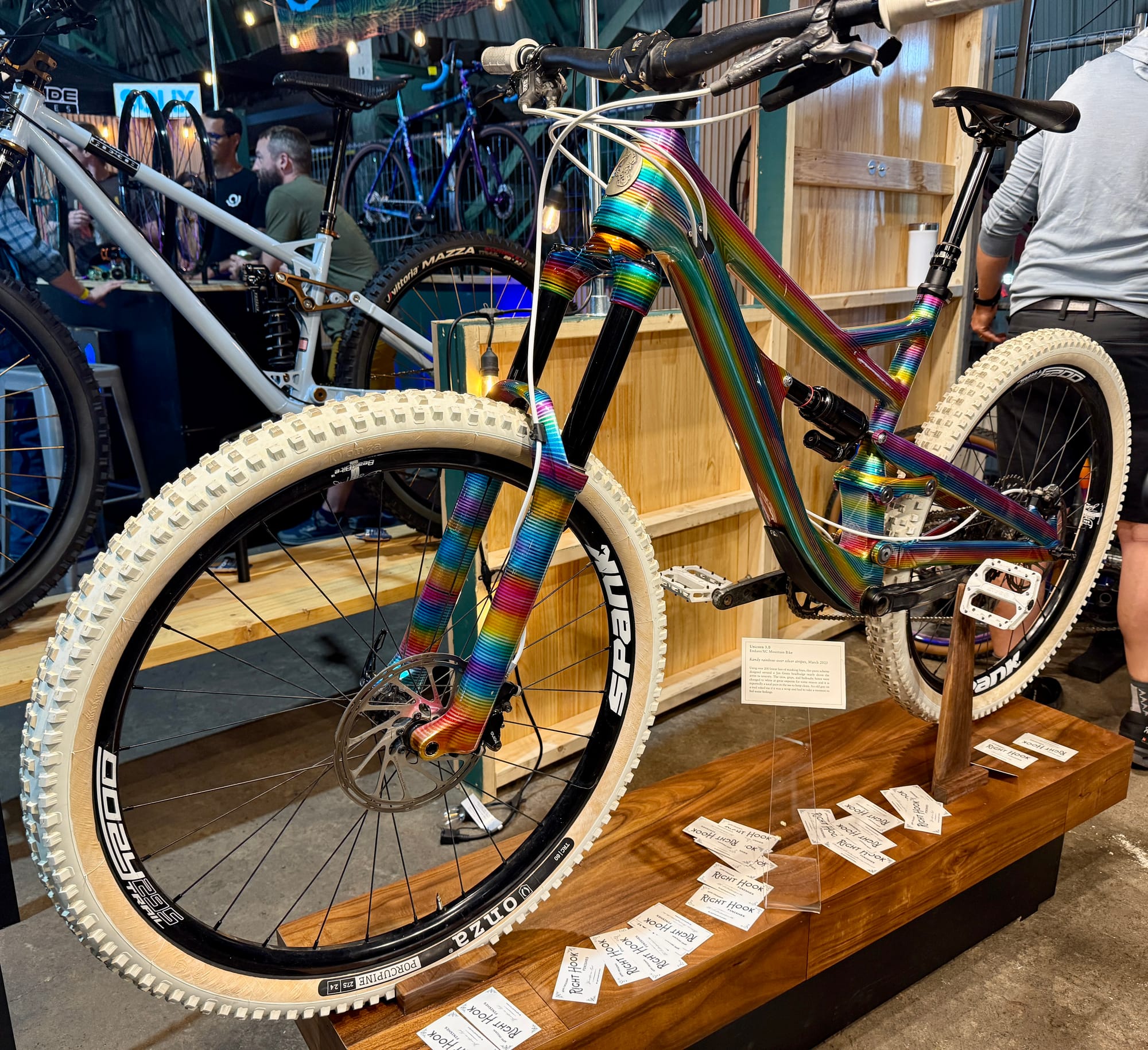
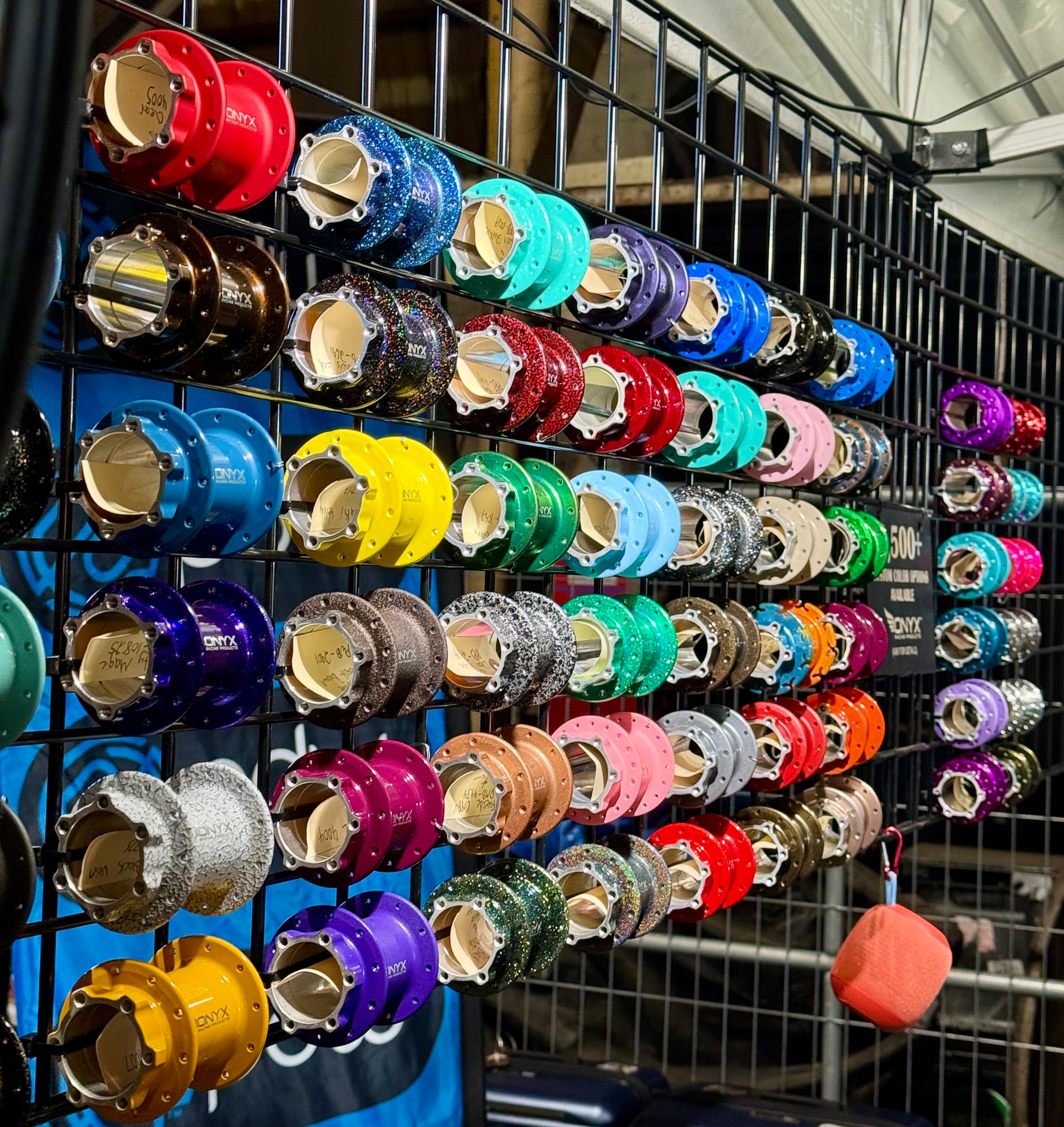
A few booths were dedicated to custom paint and anodizing outfits, ready to make any bike designer's color dreams come true. The MTB on the left looked like it had a very custom printed iridescent vinyl wrap on the frame and fork, while the company on the right had examples of every color and finish imaginable.
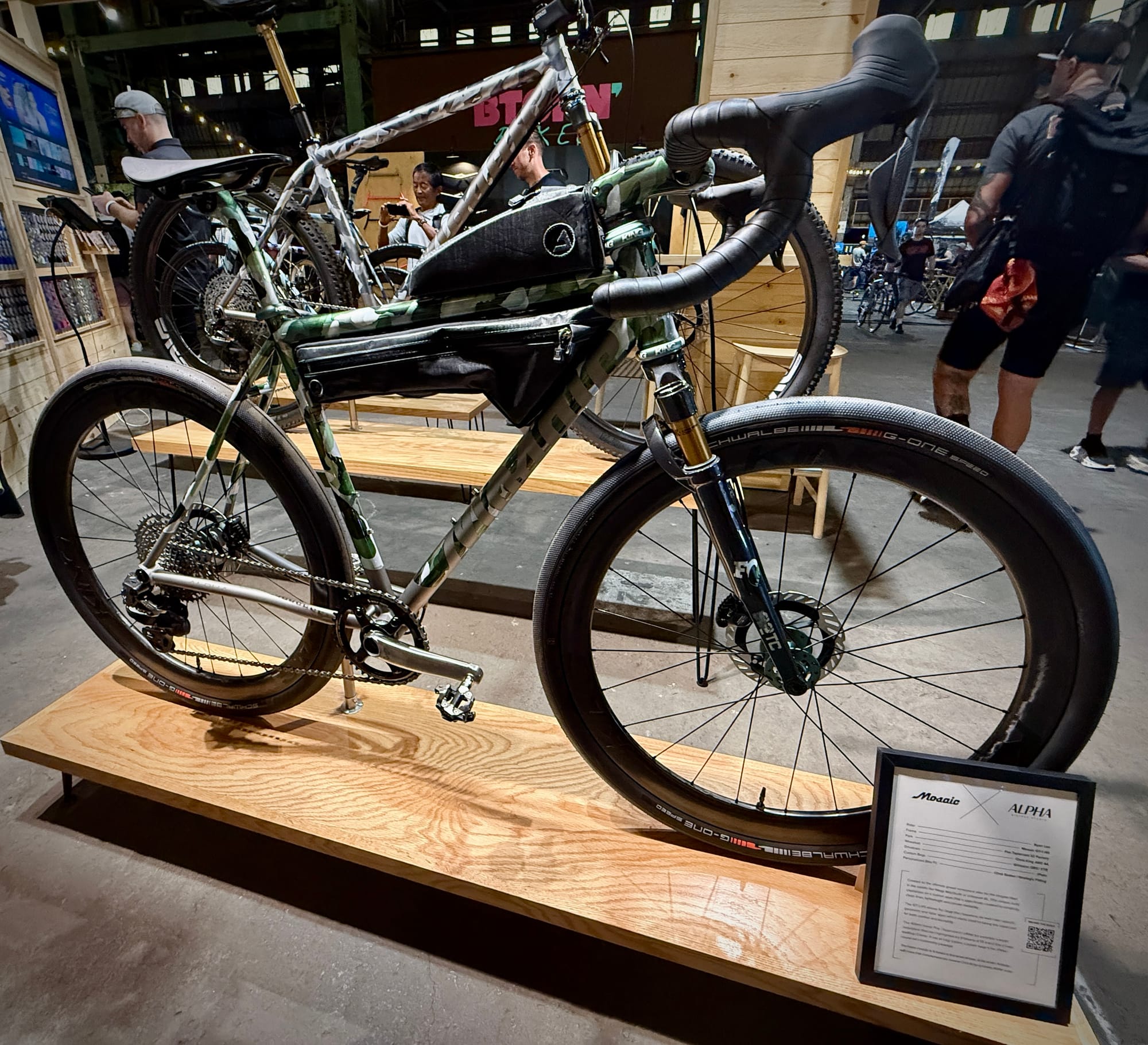
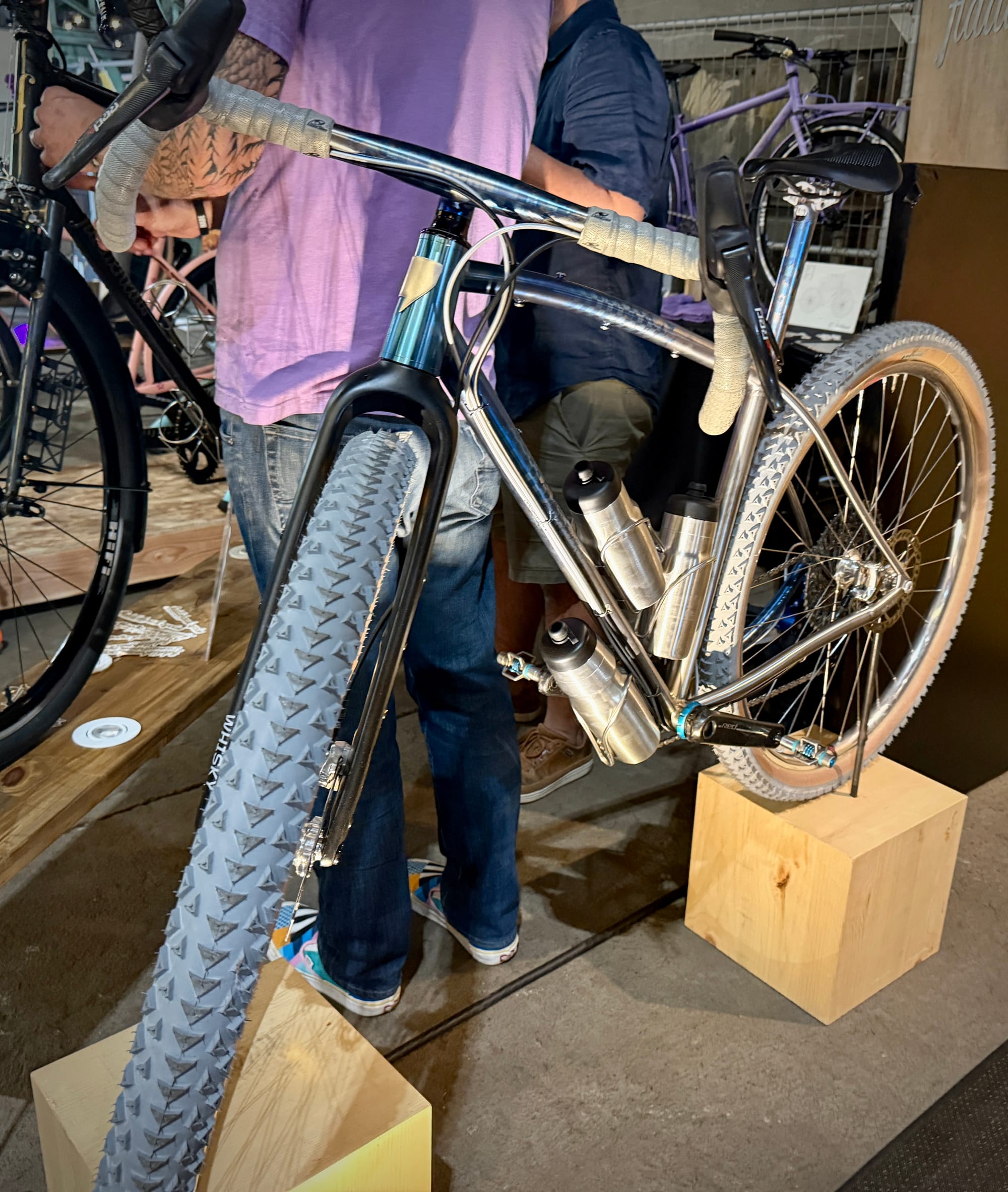
It was cool to see lots of titanium bikes among builders and I loved seeing the new Chris King Jade color way on a bunch of builds like the Mosaic on the left. The other bike had some cool anodizing on a titanium frame that is starting to show up on more builds.
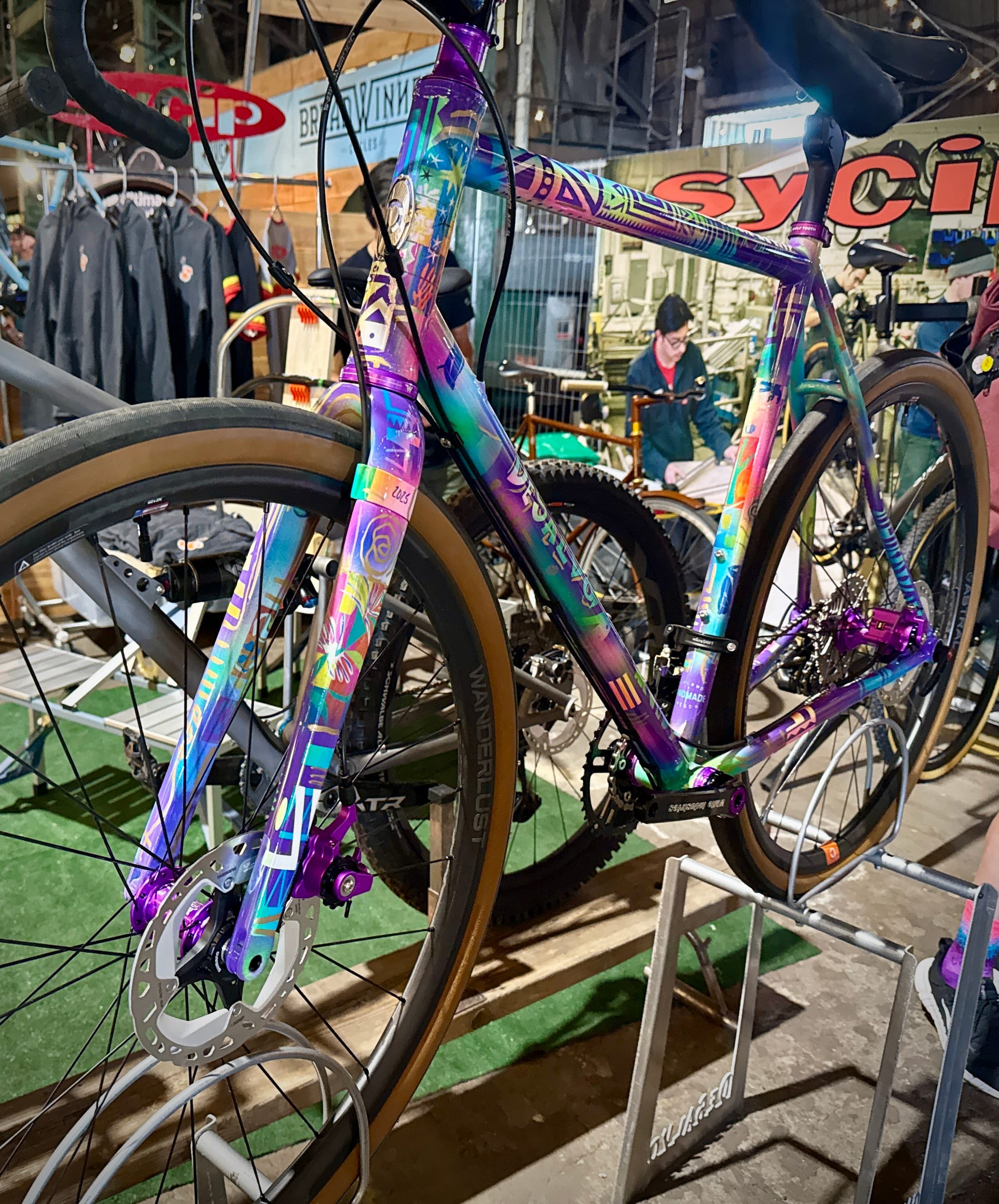
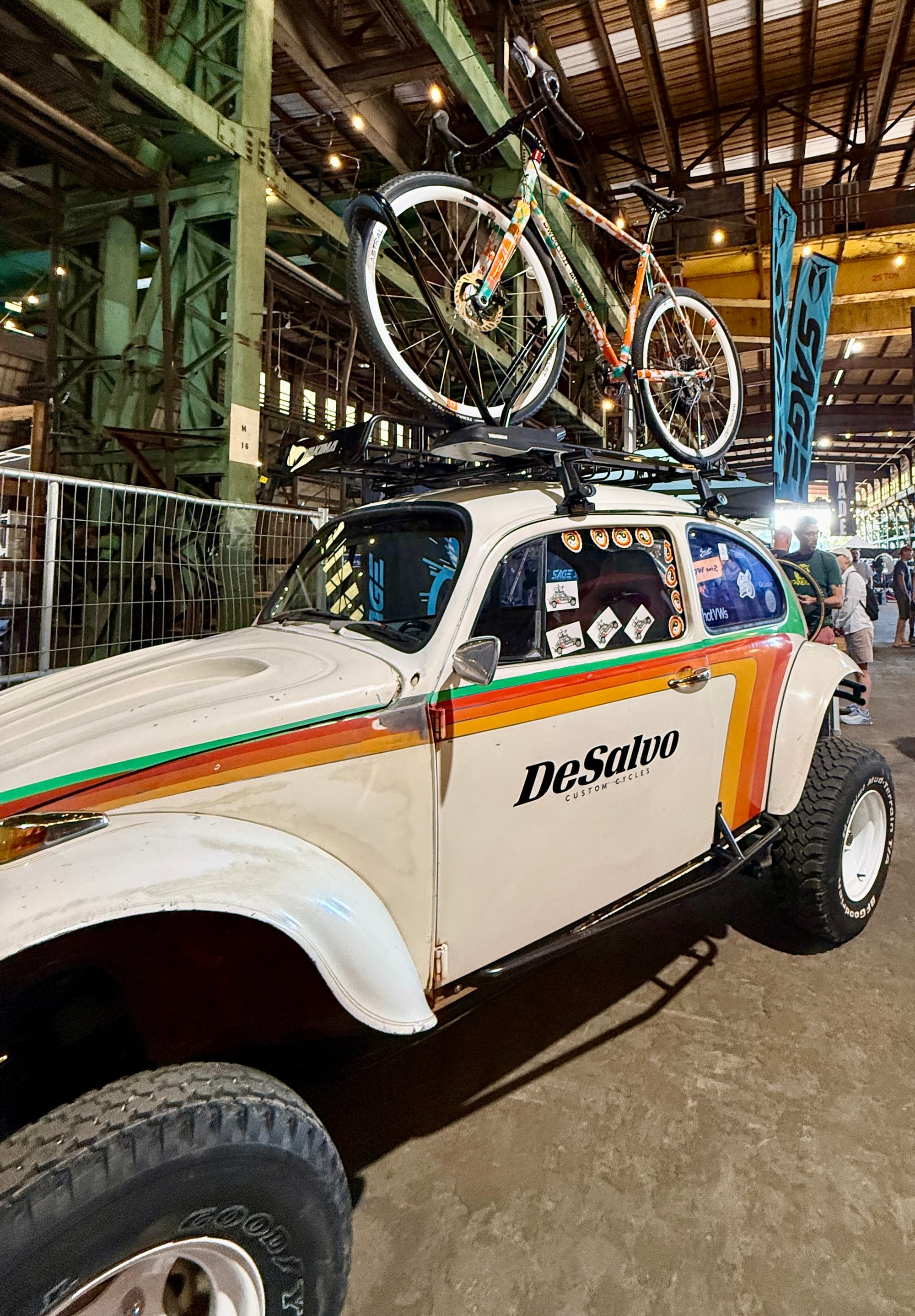
My first custom built frame was from Mike DeSalvo and his booth was rocking this year with some pretty crazy paint designs, but he's more known for really sharp, clean understated builds and paint schemes.
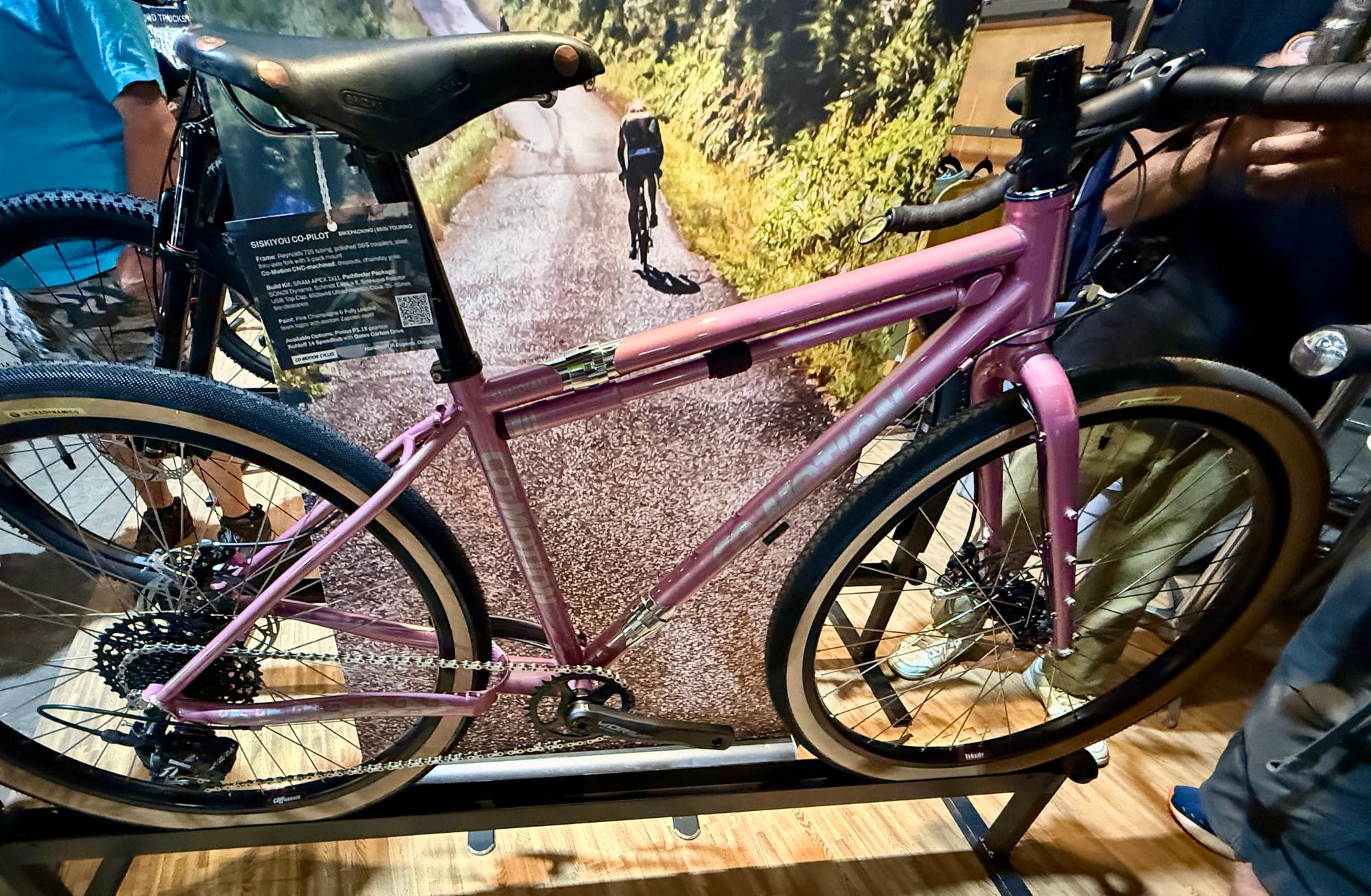
I love that this CoMotion bike's color gives off 1980s Univega road bike vibes
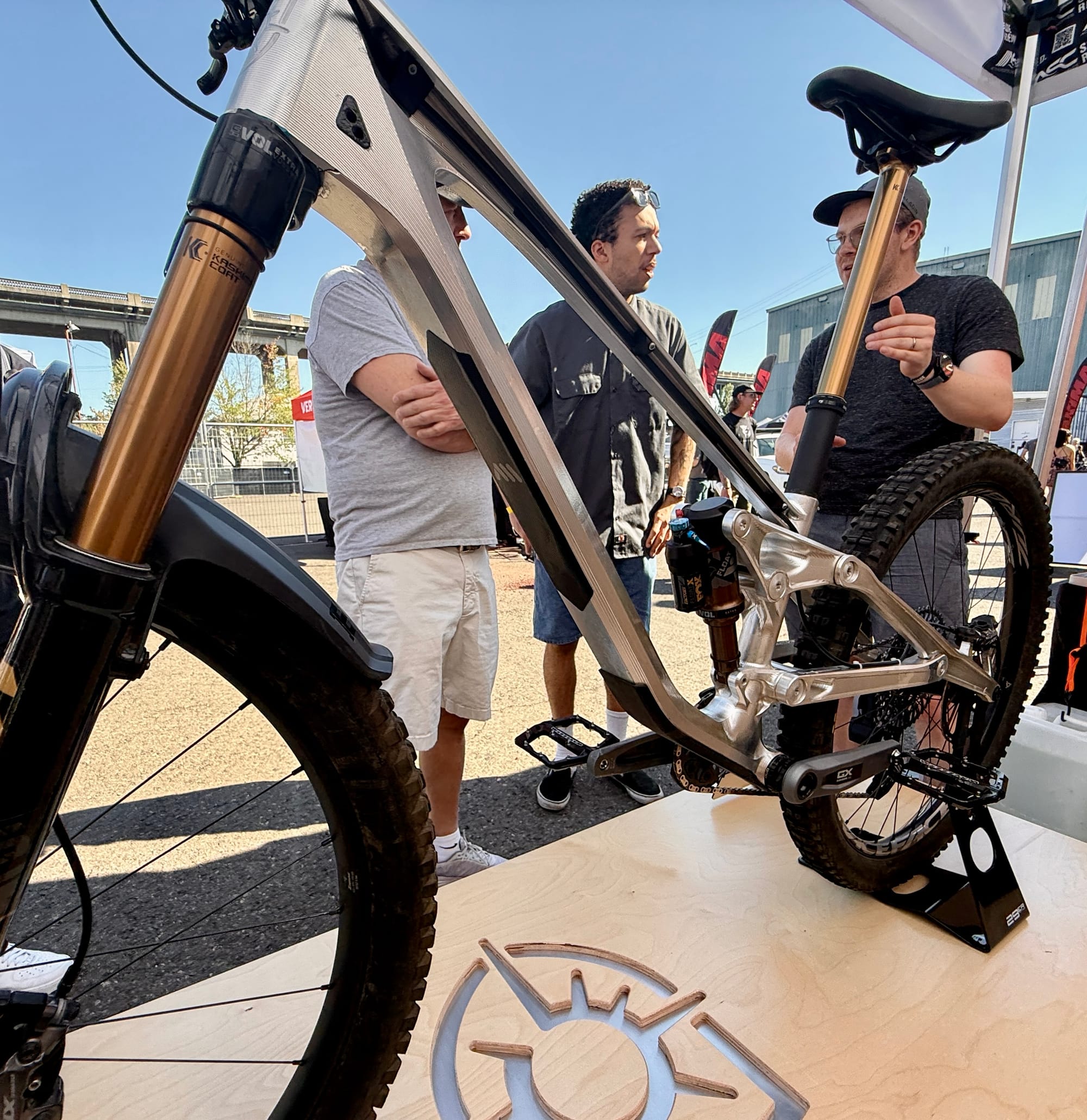
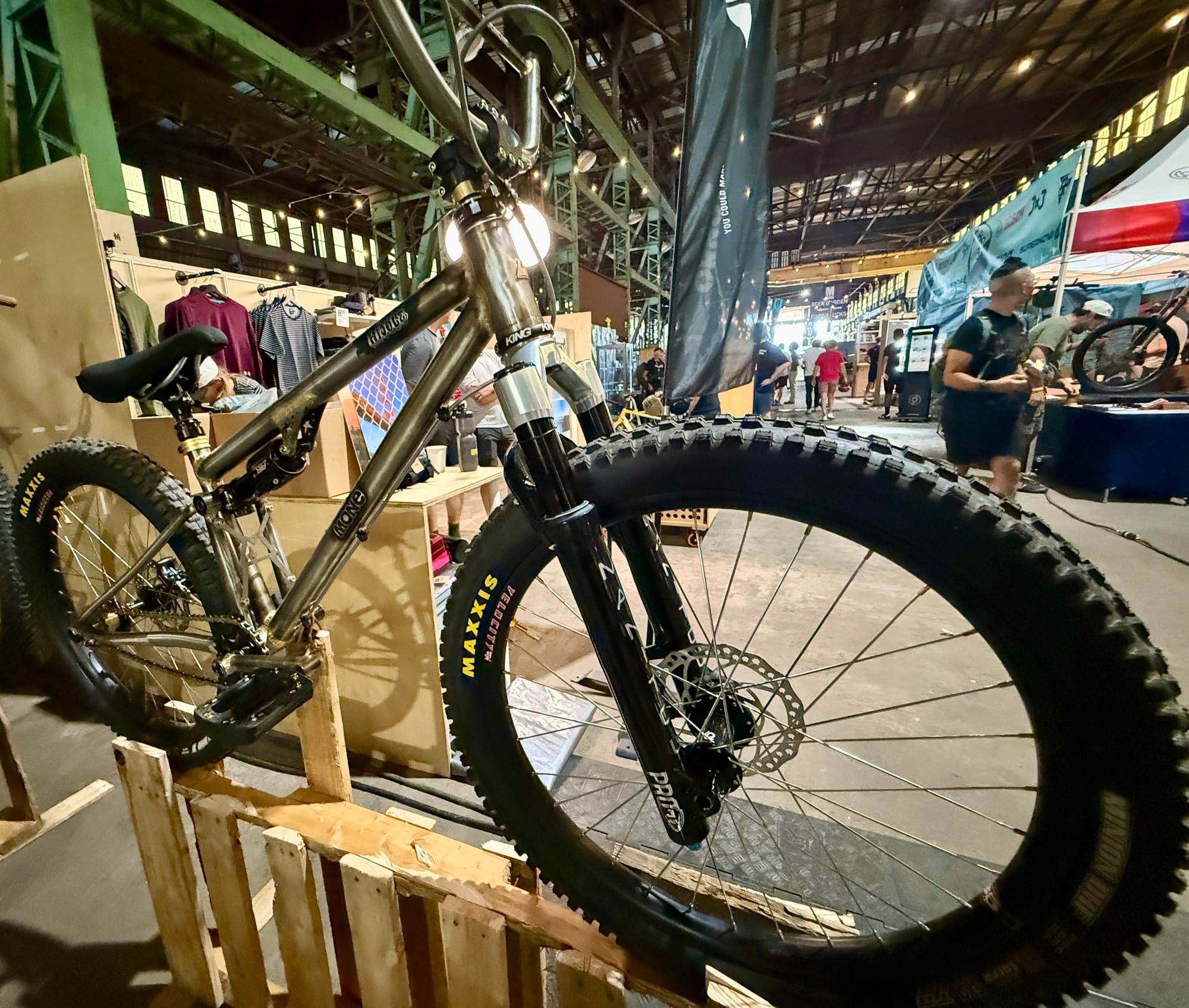
Not everything was about appearance, there were fascinating builds from people trying new things. On the left here you'll see a fully CNC'd aluminum full suspension MTB that the builders told me took about 30-40 hours of cutting a solid block of aluminum into this. They're hoping to get the process streamlined so they can pump out at least one bike per day from a CNC machine.
The next bike was interesting, a full suspension dirt jump bike with I think 24" wheels, like a big BMX bike that could probably soak up any sort of impact off jumps.
Anyway, it was fun, if you're in Portland, Oregon this weekend, check it out.
UPDATE: If you can't make it, be sure to check out videos from riders on the ground like Bikepacking.com and Path Less Pedaled, they'll have extensive coverage and interviews with builders in the next couple days uploaded to their respective YouTube channels.
My dream gravel bike build 10 Aug 7:16 PM (2 months ago)
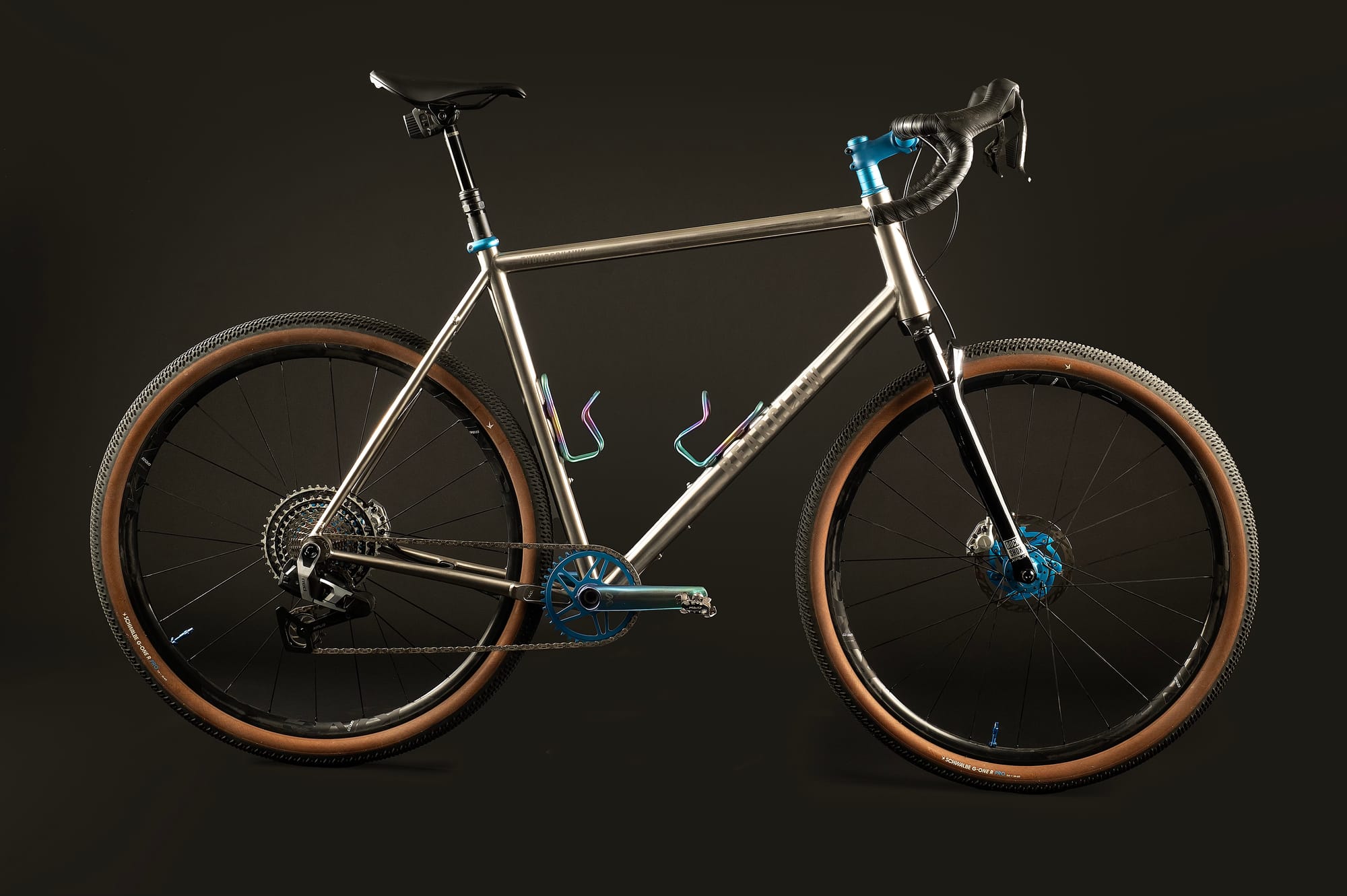
Back in March, my bike got stolen.
I own a few different bikes, but the stolen one was my main rig. It was my do anything, long distance, off-road, on-road, gravel bike that covered 90% of my riding.
It was a load-bearing bike. And I was lost without it.
Planning a new bike
After losing my bike, I immediately started planning a replacement. This'd be my fourth gravel bike over the last 10-15 years and I wanted to build it perfectly fit for my needs. So I came up with a list of build ideas.
I want a "forever bike" built with "forever materials"
I own bikes made with all sorts of different materials. I wanted to return to a titanium frame because they really do feel bulletproof, have fun ride properties like a steel frame, but can also be stiff like carbon or aluminum. I wanted to avoid carbon fiber for everything, even though I still have a couple bikes with carbon frames. I'm a big, heavy guy and I planned to ride this over rough terrain so I wanted a bike that was more metal than plastic that could really last forever.
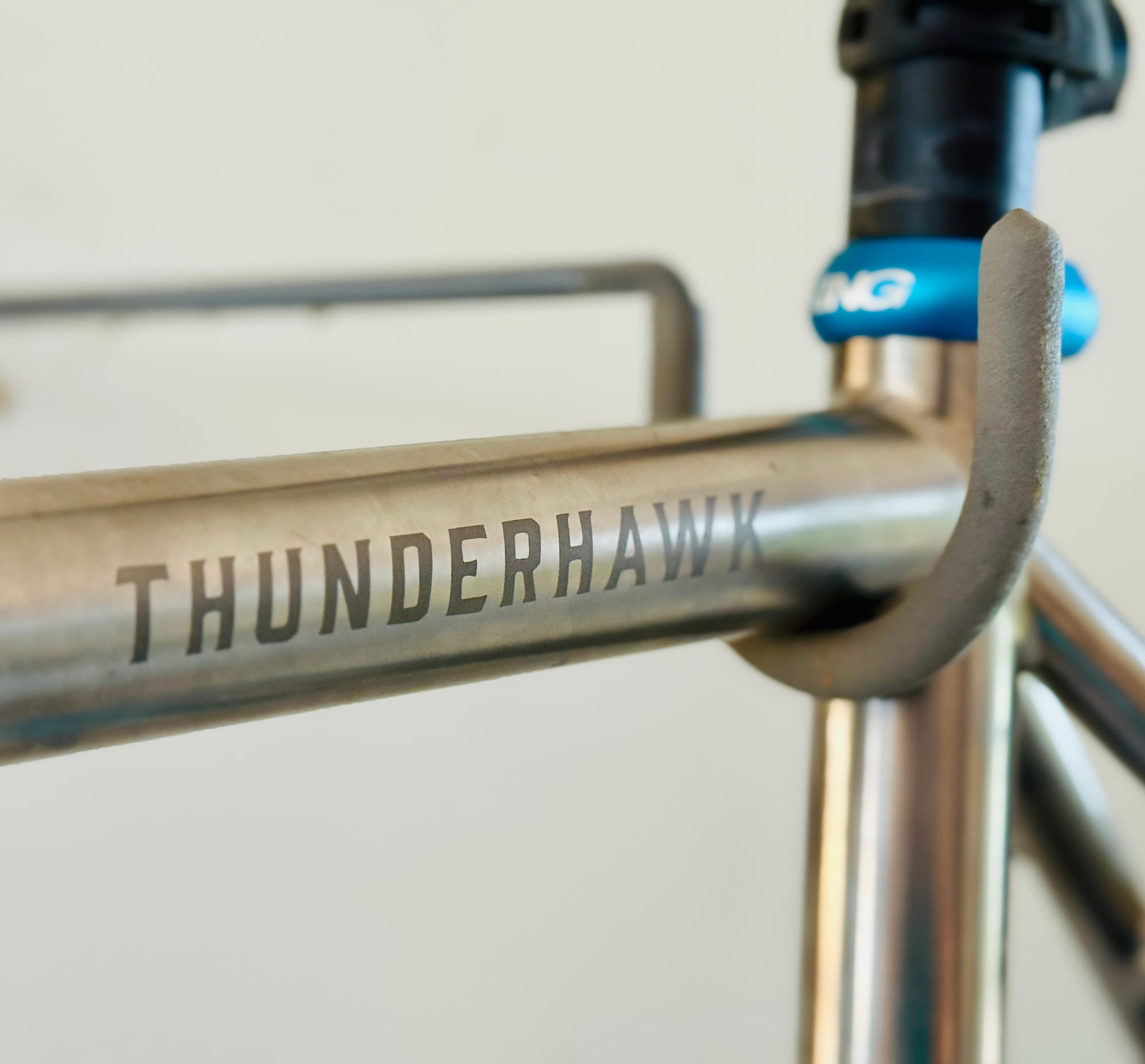
I settled on a Bearclaw Thunderhawk in size 60cm as the base for the build. Bearclaw had one in stock so I bought it and it shipped so quickly I had the frame in my hands within days of losing my last bike. I've waited up to two years for custom frames to be built for me before, so getting a titanium frame within days was a revelation.
Durability and capability are king, speed and lightness, not so much
There are trade-offs when building a bike and usually it's between things like aerodynamics versus comfort or lightness over capability. If you ride in a hunched-over position, you can go faster due to less wind resistance, but you won't be comfortable after a long ride. Same goes for running narrow tires. Sure they'll go fast on pavement, but the first time you take a high-speed turn in deep gravel, you'll wish you had fatter tires with more traction.
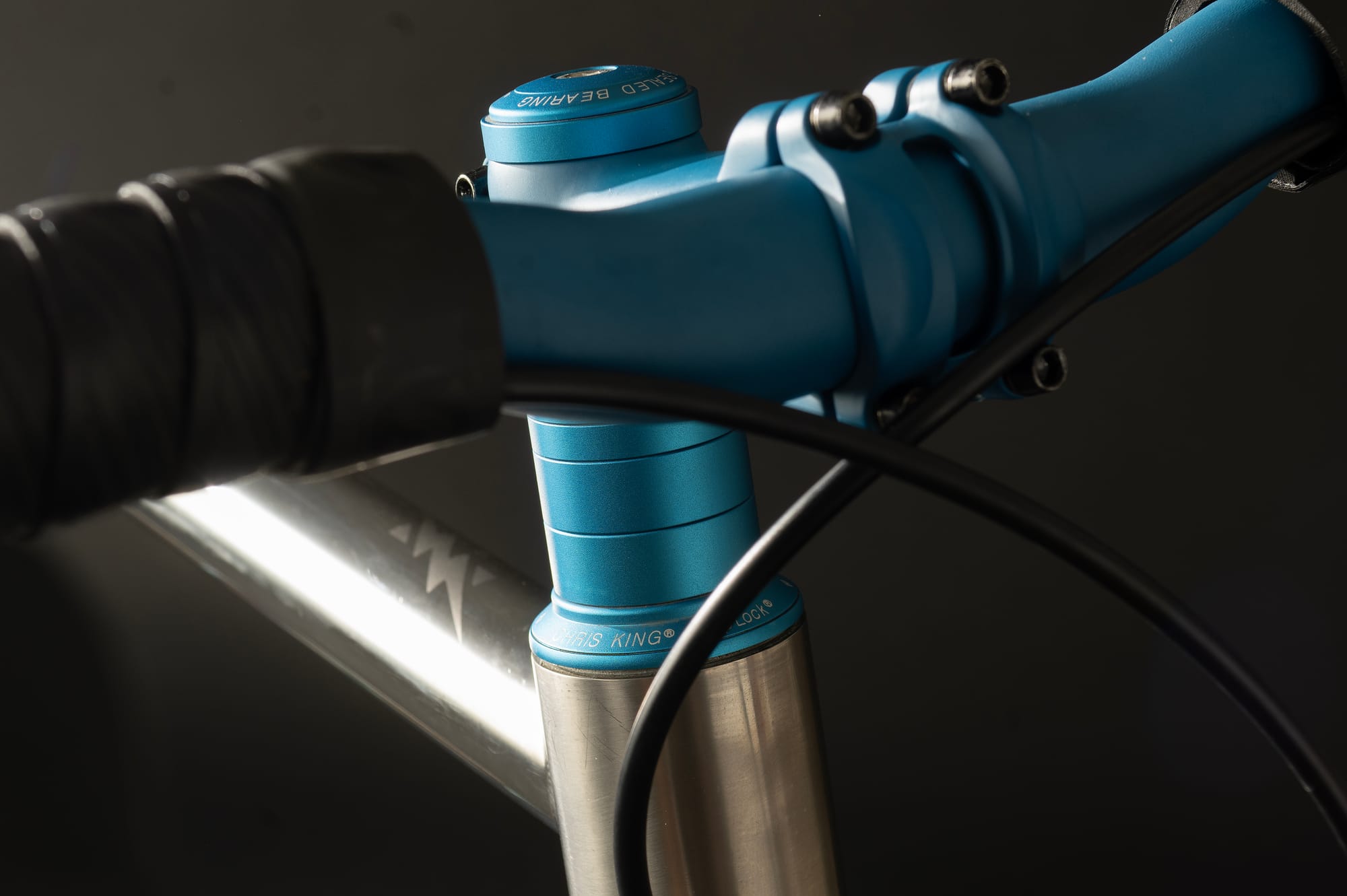
The bike industry is obsessed with lightweight things and I've raced <16lb bikes before and honestly, there's not a ton of difference riding ultra light bikes versus slightly heavier bikes after an entire day out on the roads.
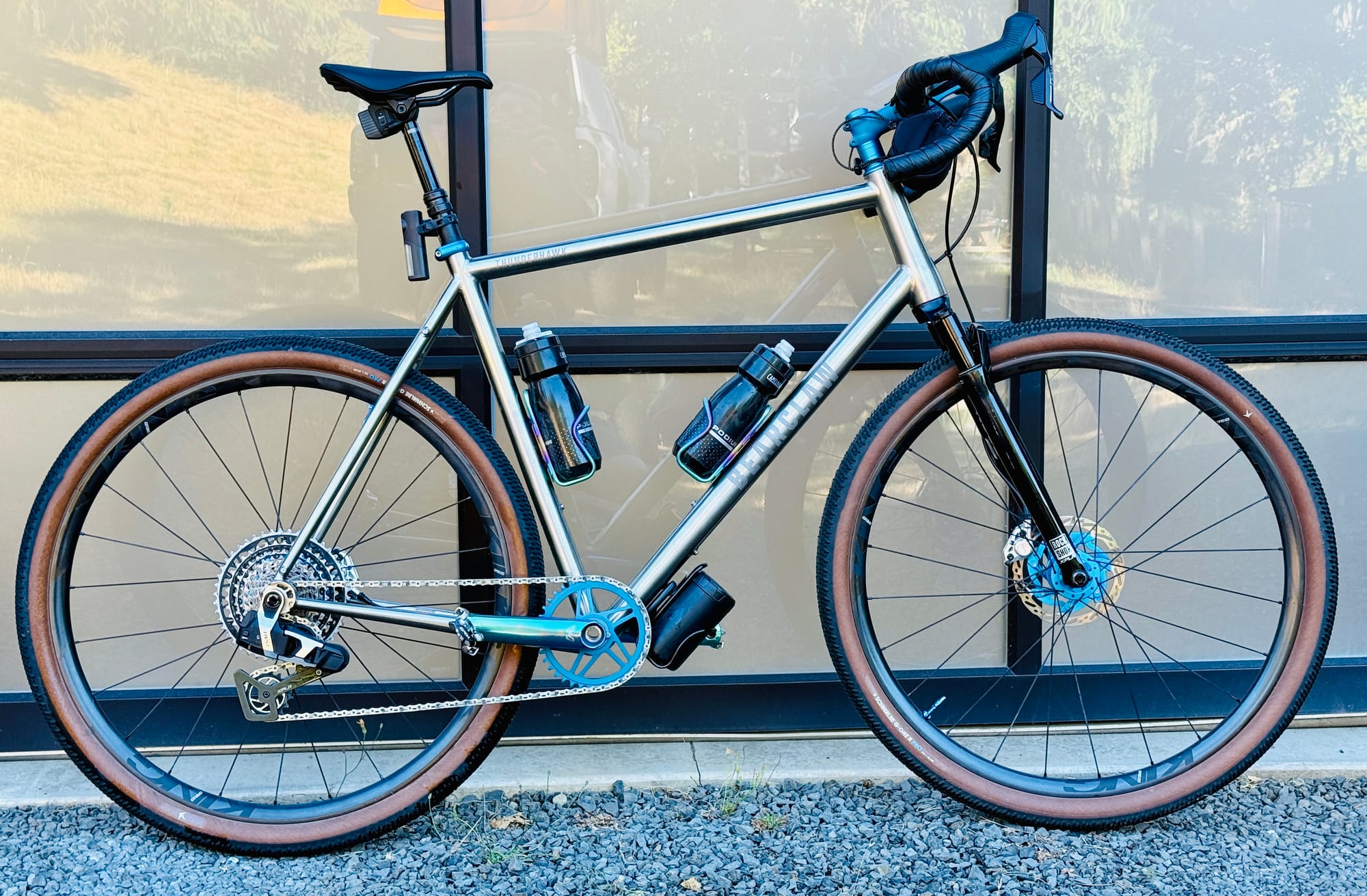
I deliberately didn't focus on light weight on this bike, and fully loaded, the bike probably weighs about 23lbs with water and gear.
The importance of cushioning
For years, I raced bikes in all sorts of genres and during one of my last cyclocross races before the pandemic hit, I decided to skip my lightweight, suspension-free cyclocross bike and instead I raced on a full suspension enduro MTB. The bike was easily 10lbs heavier than my race bike and I expected to finish in last place, but on the final lap of my race, I had so much energy still in the tank that I was passing people like they were standing still. My body wasn't hammered by bumps for the previous hour and I felt superhuman by the time I hit the finish line. I finished 15 places higher than I usually did in the same age class even though I was on a slower, heavier bike.
That result was an eye-opener, as I had never suspected suspension was all that important in racing bikes, but to this day, whenever I can, I opt for comfort.
For this bike I wanted a dedicated suspension fork. Gravel bikes don't typically have front suspension, but over the years I've experimented with several, using a stem shock absorber in my previous Specialized Diverge bike as well as Redshift's suspension stem on my Canyon Grizl. I knew a suspension fork would be smoother on rough downhills, so I picked a Rudy Ultimate XPLR 40mm gravel suspension fork.
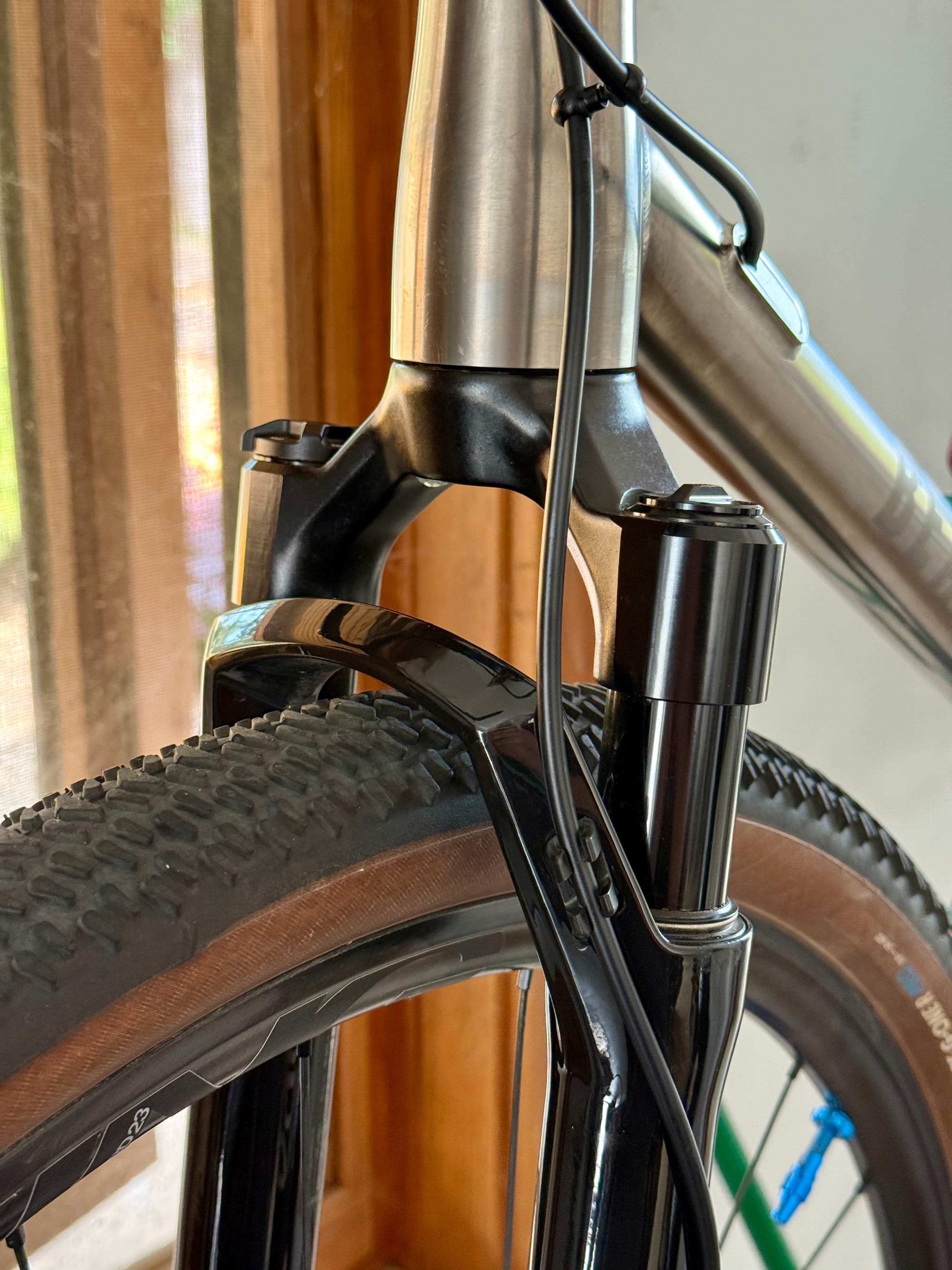
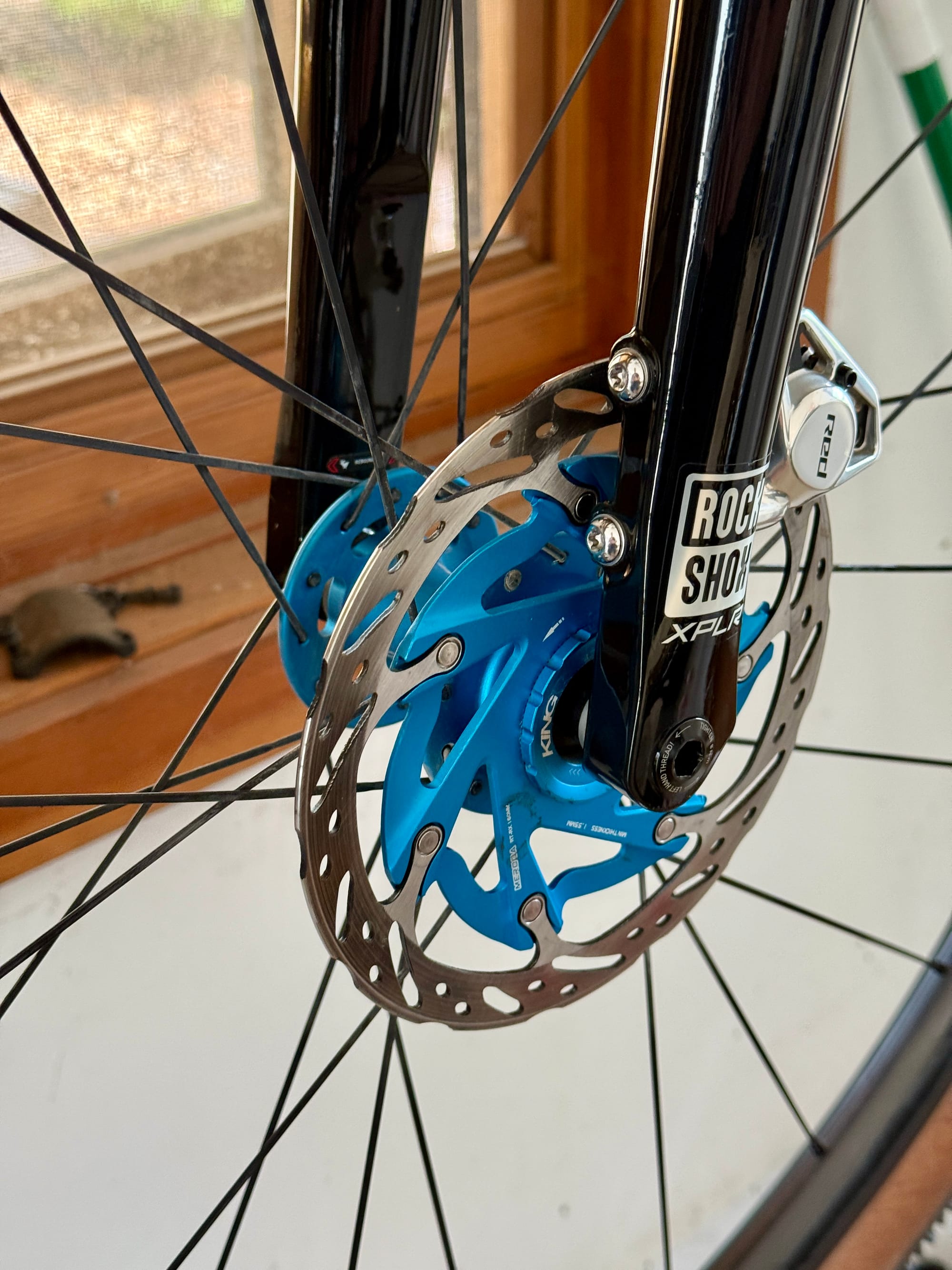
This fork adds a couple pounds to the bike but the comfort and safety are worth every ounce. I can bomb down gravel downhills like I'm on a mountain bike and the sense of control is fantastic compared to being bumped all over on a solid fork.
Future proof as much as possible
Lastly, I wanted my bike to support new features so it was relevant for as long as possible. This meant ditching a derailleur hanger in favor of a frame mounted shifter, aka a Universal Derailleur Hanger (UDH). This has been around the MTB world for a few years, but it's still new in gravel bikes. Another reason why I picked the Bearclaw Thunderhawk was the frame supported a UDH.
I bought the newest SRAM Red XPLR group and it comes with a 10-46 tooth rear cassette that I paired with a 38 tooth front single chainring.
Reflections after the first couple hundred miles
I basically built a 1990s hardtail MTB with drop bars and I love it. Here are some photos of it in my pal Jared Souney's photo studio and in action on the road.
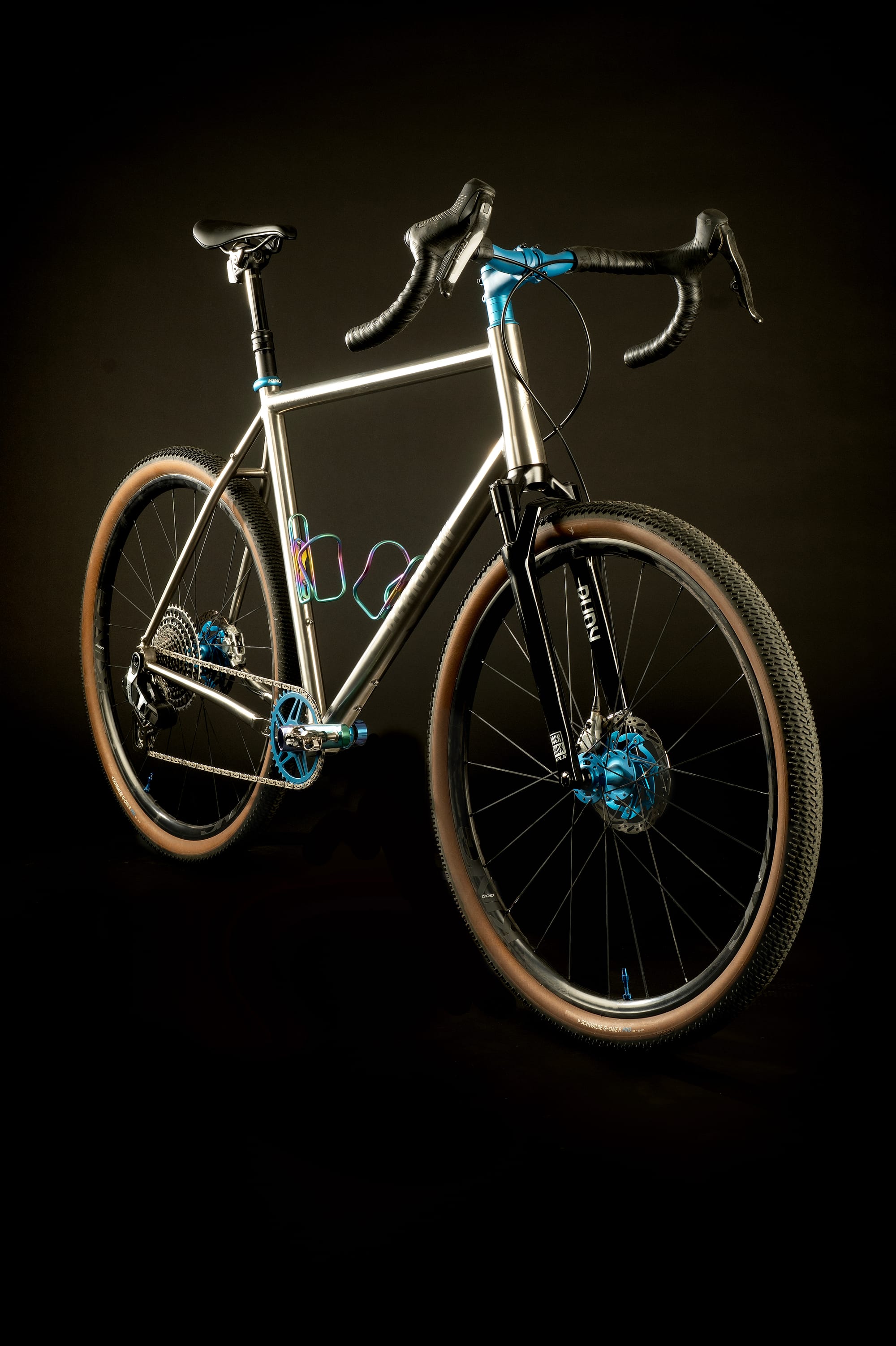
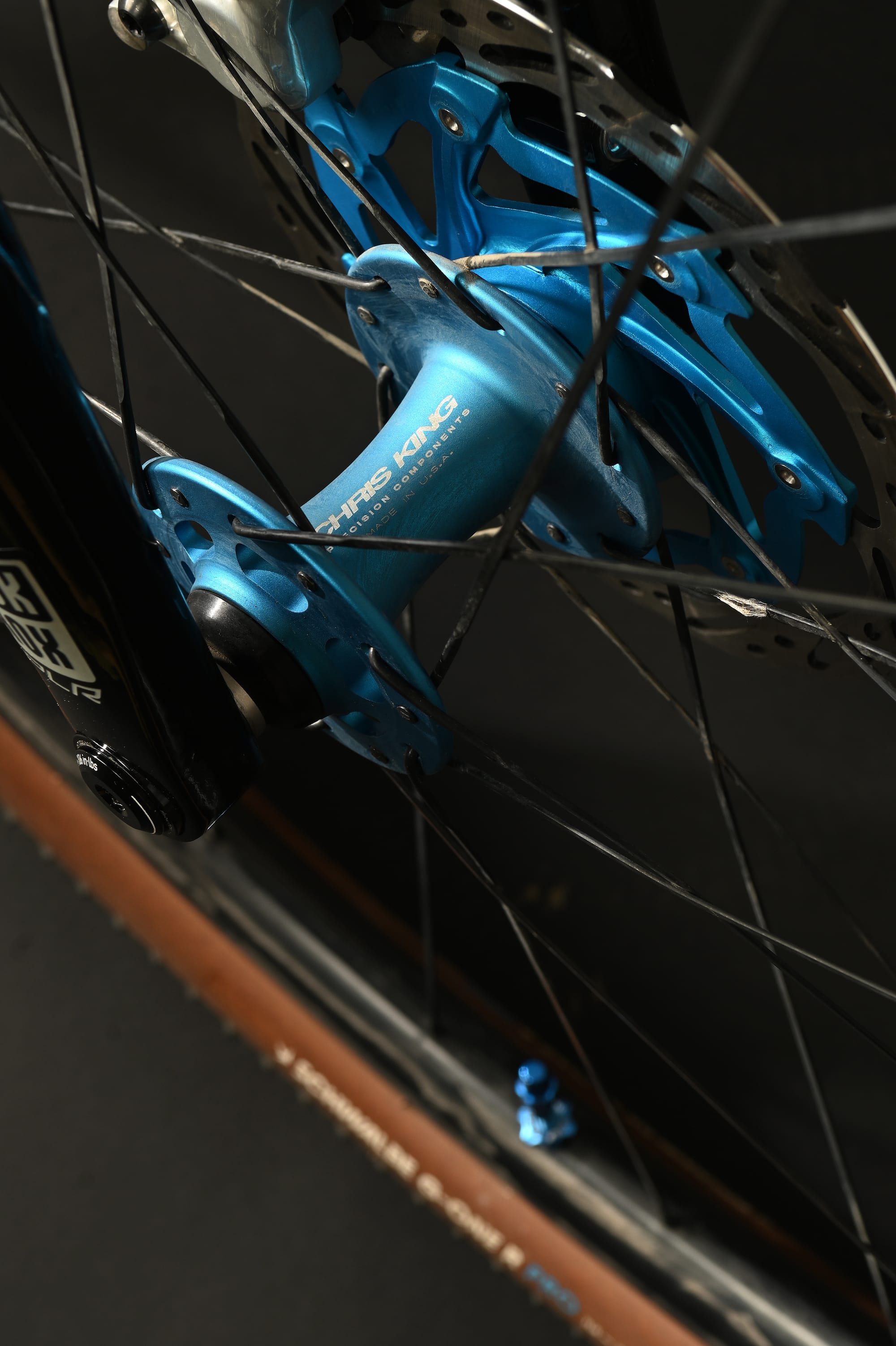
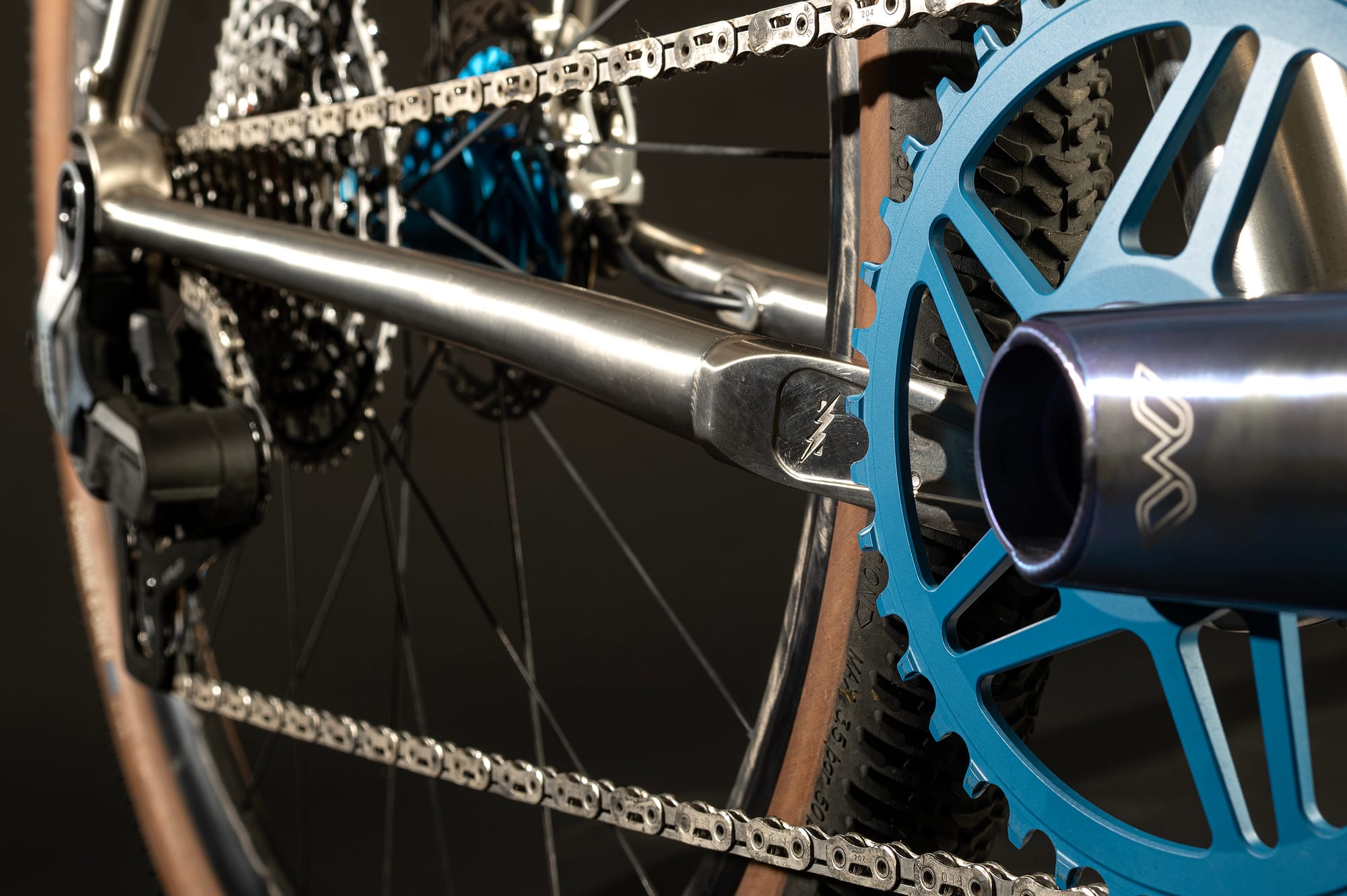
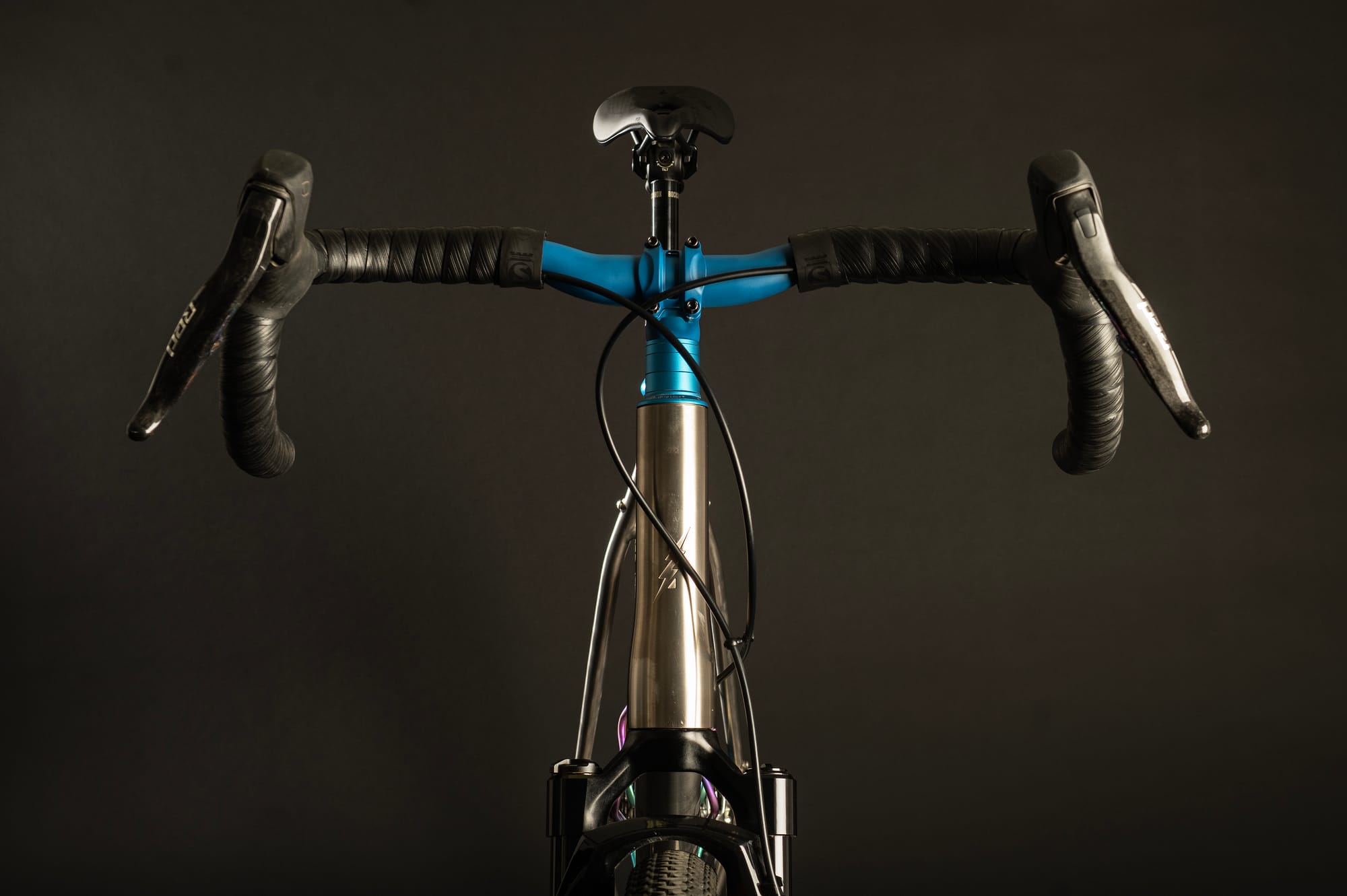
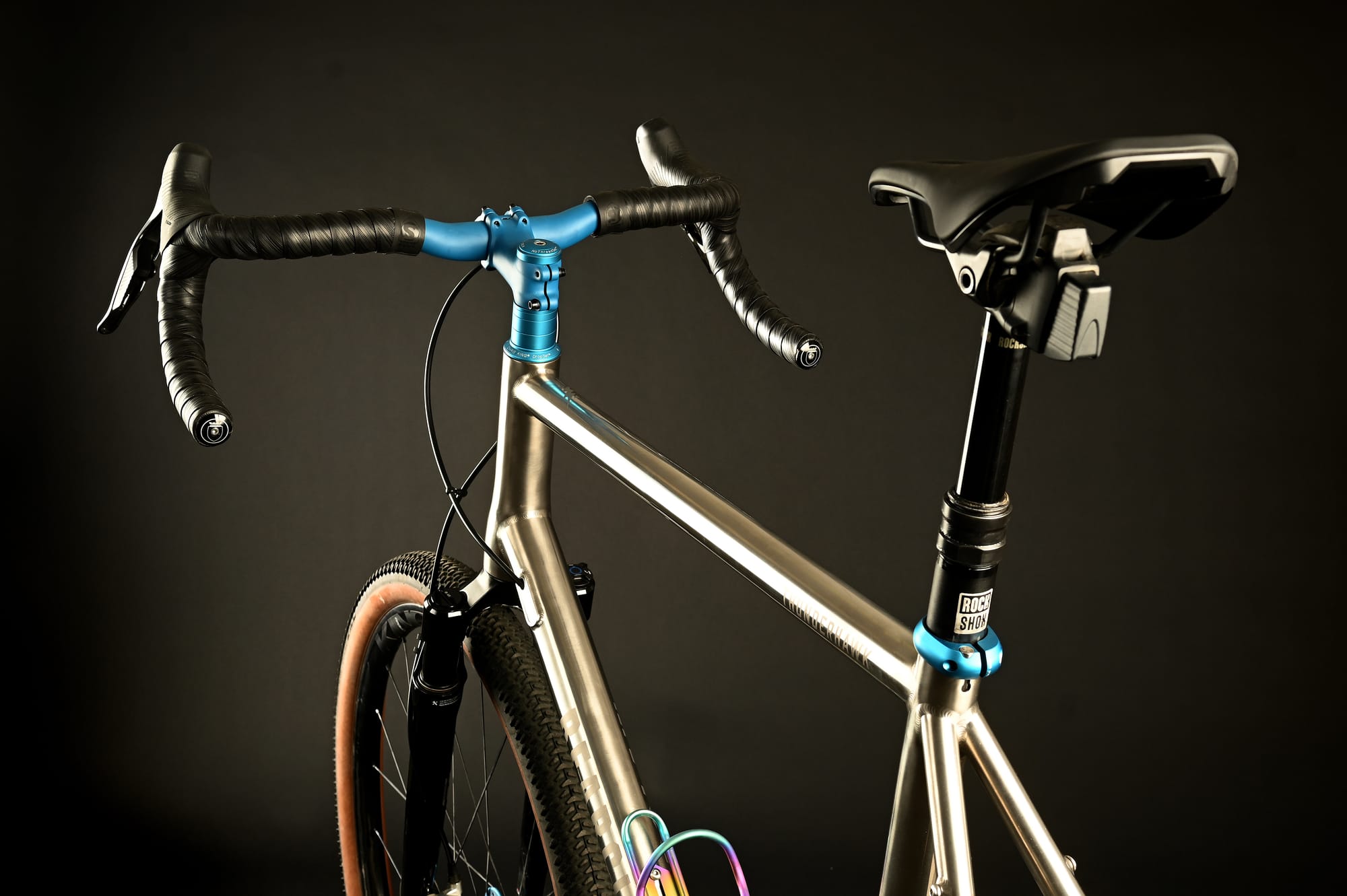
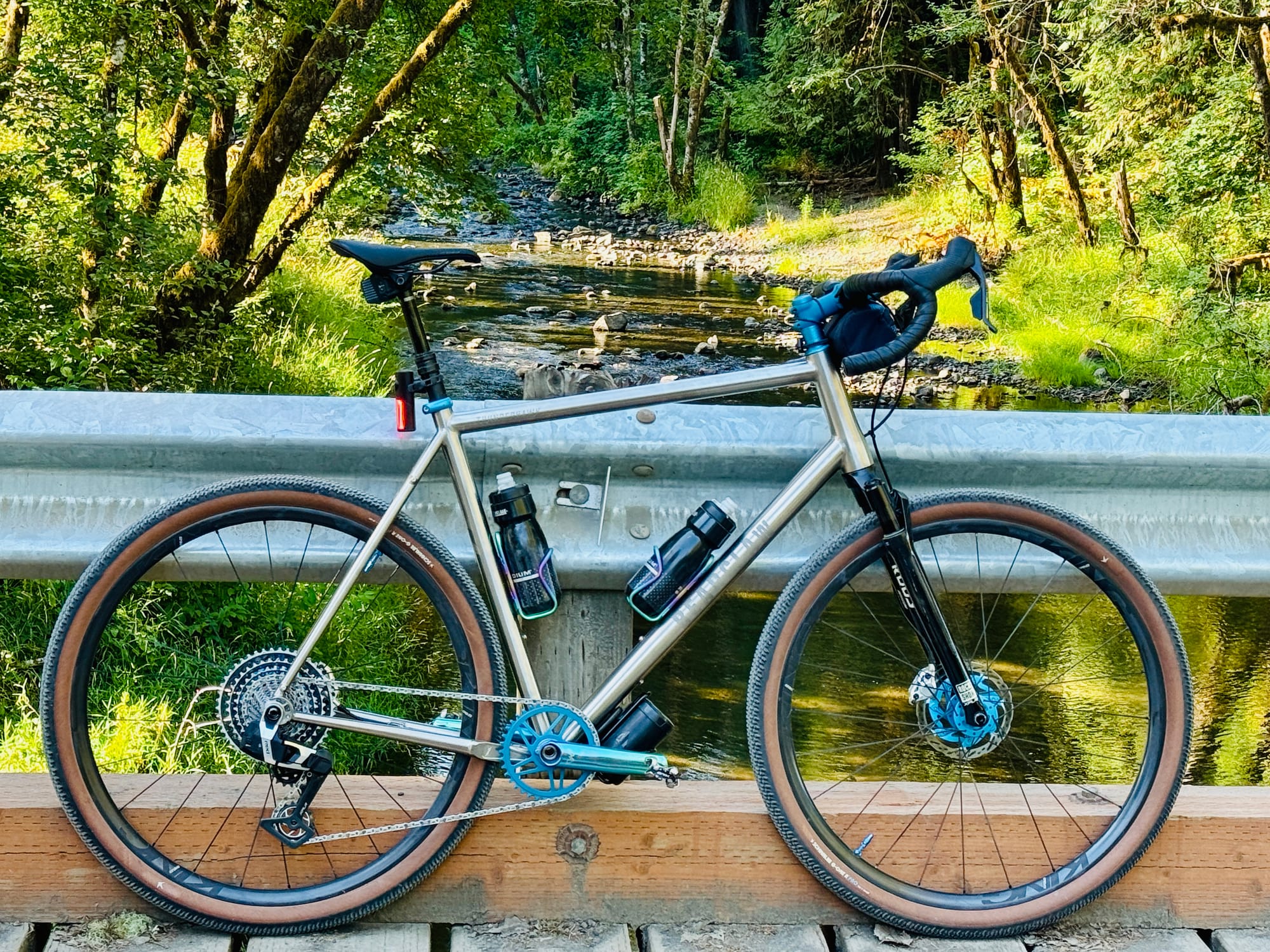
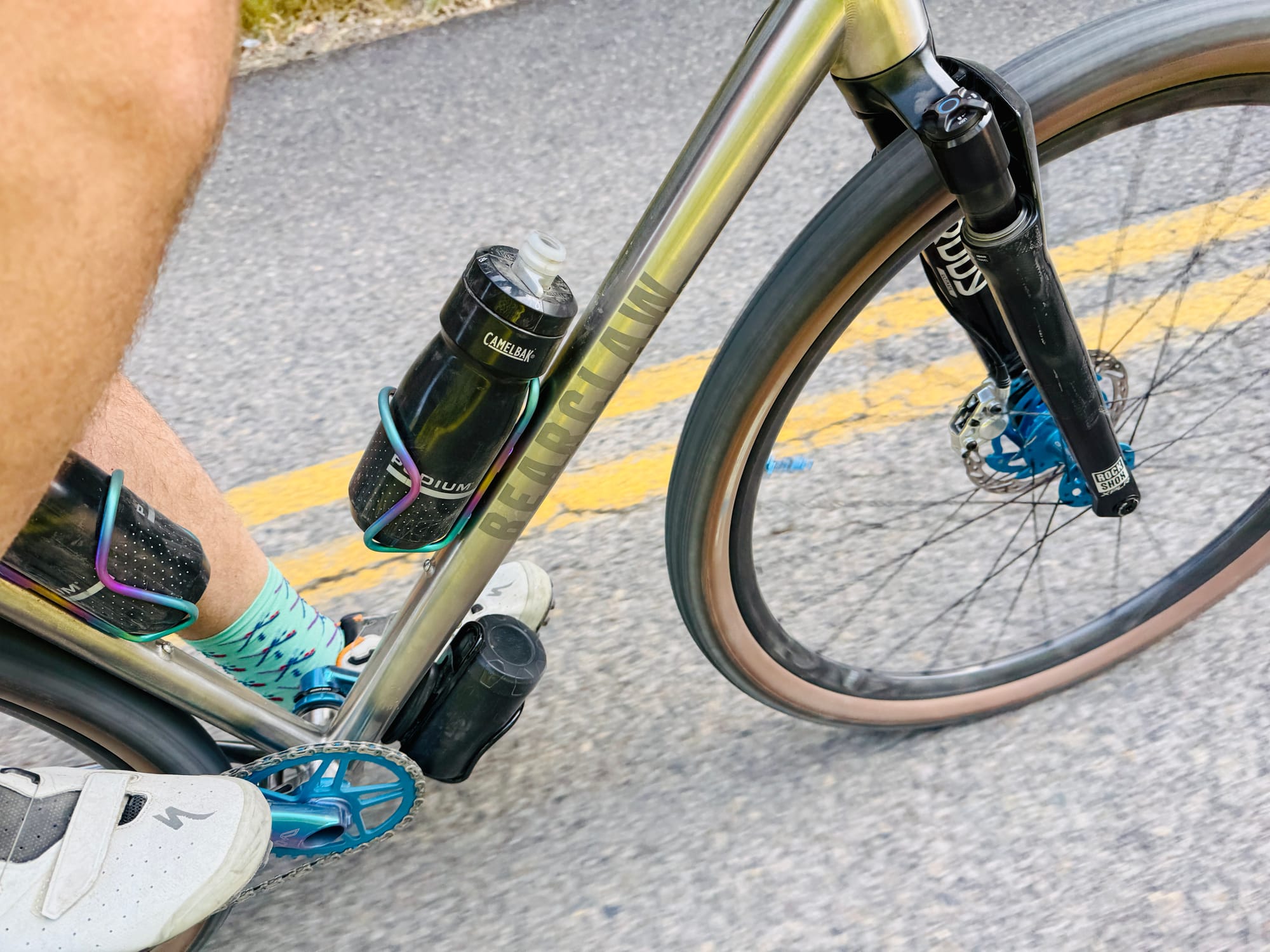
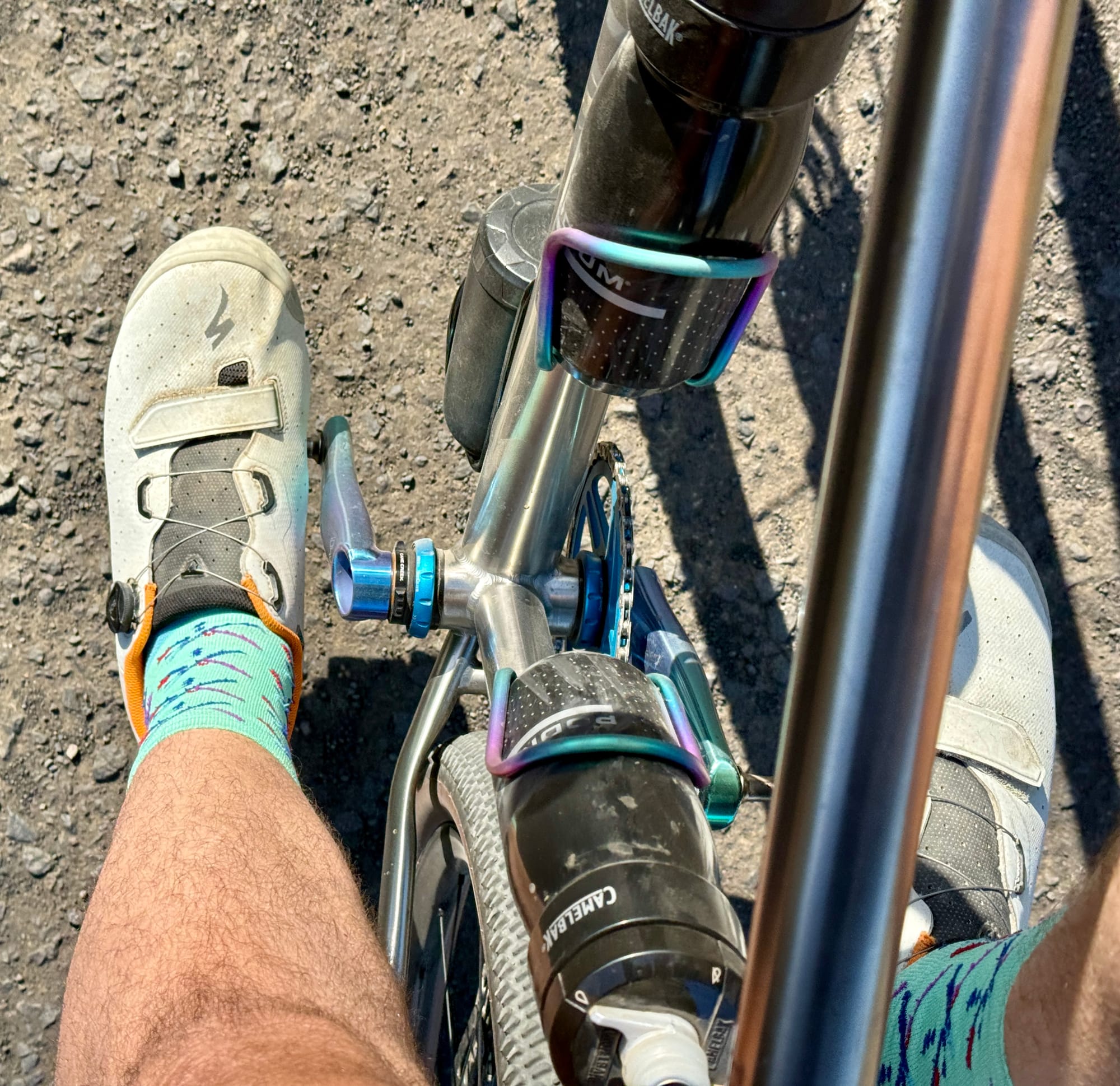
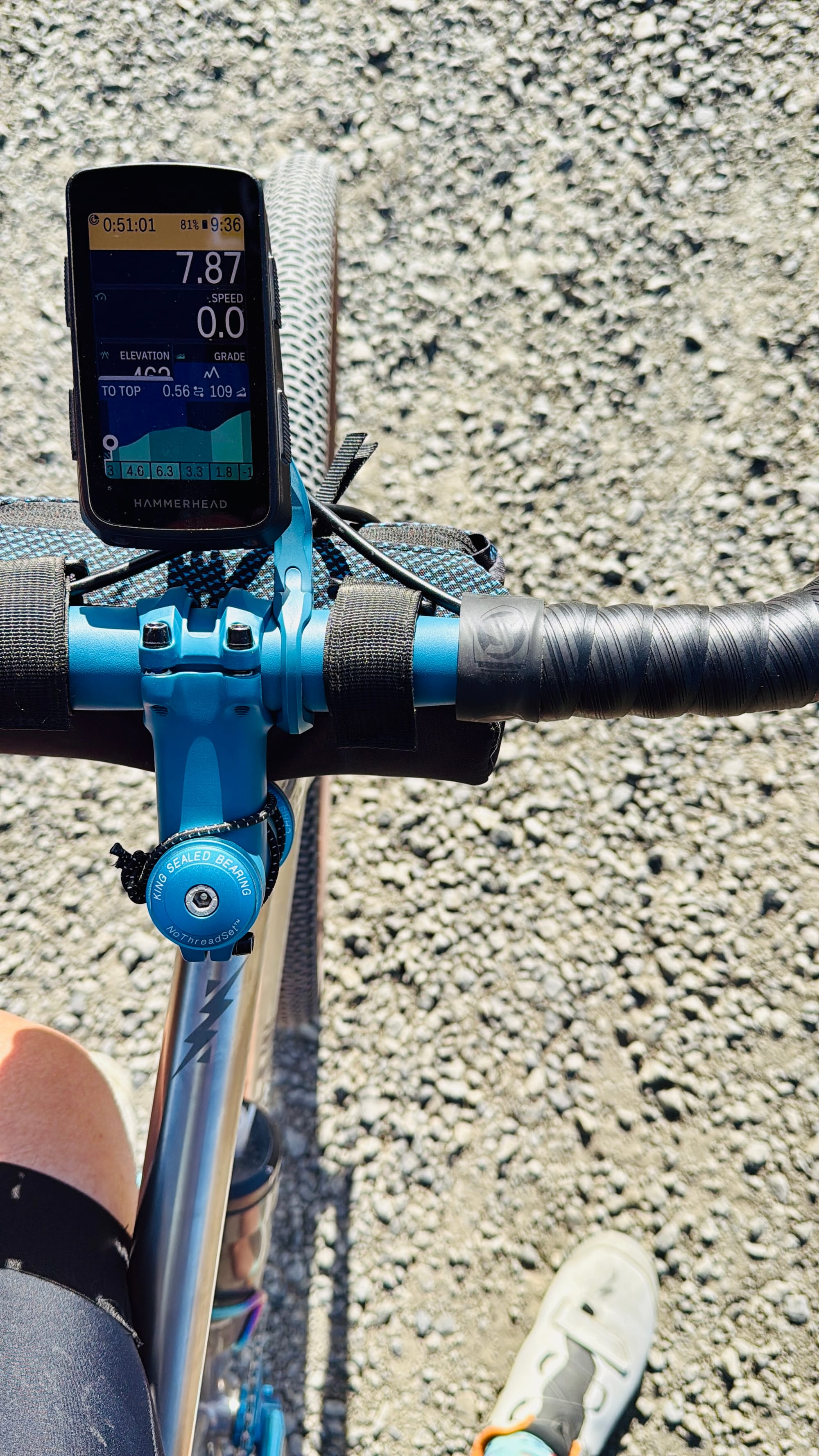
Lesson 1: Direct-mount shifting is a game changer
Over the last 30 years I've ridden bikes with either Shimano or SRAM shifting and the Shimano options were always quieter, smoother, and more accurate on shifting. SRAM is famous for cheaper, clunky stuff that works, but not as well.
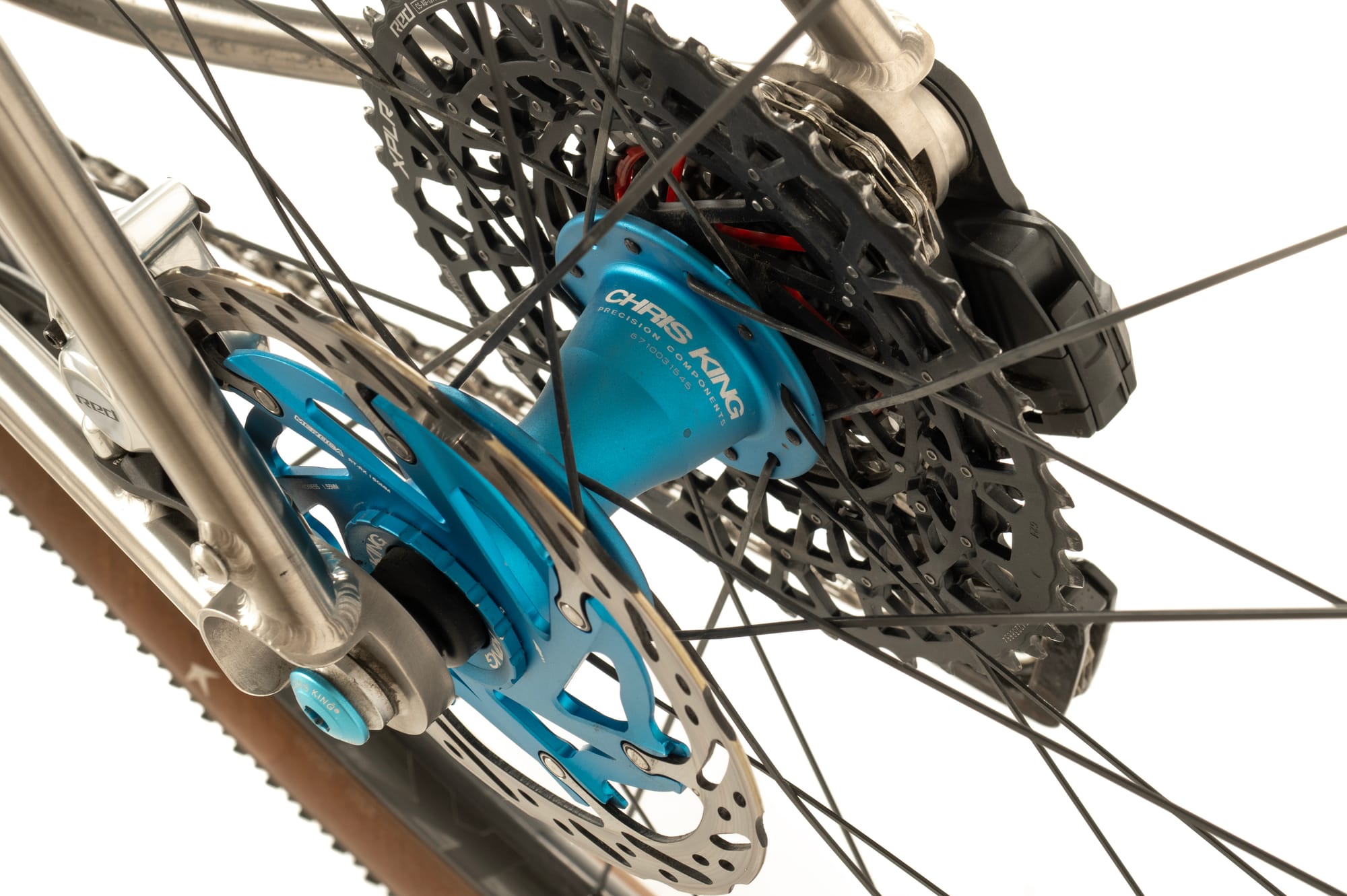
SRAM's new direct mount shifting is phenomenal. Every shift is instant, quiet, and perfect. Honestly, this is the first SRAM setup I've ridden that feels as smooth as the best top of the line Shimano electric group sets. The frame mount means there's no chance of bending the mount so shifts are accurate without the need for minor tweaks, it just always works perfectly.
You can also shift under load without dropping a chain. For the past 40 years I've had to instinctively ease up while pedaling before every shift, but with the derailleur mounted directly to the frame, you can shift while sprinting, or on a hard climb while pedaling full blast, and there are no issues. I wish I moved to SRAM's new system sooner.
Lesson 2: More gearing is always better
The largest cassettes I could run on previous bikes were usually in the 30-40 tooth range, and those were just barely enough for the steep hills where I typically ride. The new 46 tooth rear setup feels like having an additional set of low gears on my bike and it's amazing when you can slowly spin up any hill at 3mph no matter how steep.
I considered going with SRAM's Eagle transmission MTB rear shifting for the 52 tooth rear they offer and maybe someday I'll give that a try. Having lots of low gearing is amazing when you're riding hills and you don't have to sacrifice top end speed while getting it. Since every SRAM cassette has a 10-tooth small gear, with the 38t front chainring, I can still crank up to 30mph on flat roads.
Lesson 3: Simplicity is king
My last bike was my first time trying a single front chainring on a gravel bike and I stuck with it for this new build. With a 1x setup, I shift much more often because I don't have to worry about maxing out the gear range of either front chainring and I don’t have to think about when to switch between them. Instead, when speeds change, I instinctively start shifting to a better gear because it's so quick and easy, even if it's just a few hundred feet before another climb.
SRAM's wireless electronic shifting is customizable, and on my bike you tap the left lever to make pedaling easier (lower gears) and right lever taps make it harder (higher gears). I also run Camelbak water bottles with valves that stay open without spilling water, so you don't have to unlock them to drink, you just squeeze.
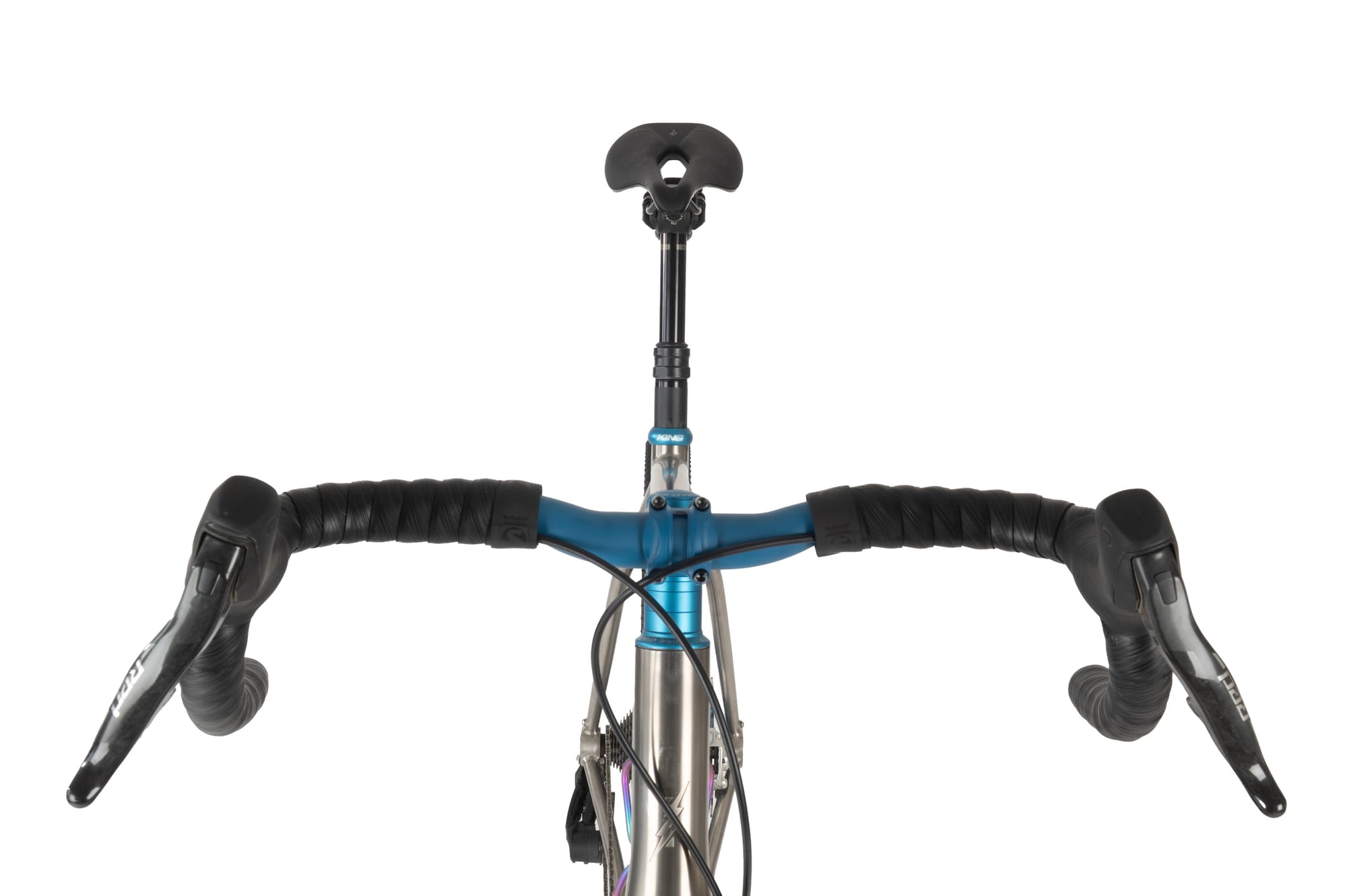
On long, exhausting rides when I'm low on energy, I don't like overthinking anything, and I love that shifting is left-easy, right-hard and drinking water is just grab-a-bottle-and-squeeze.
Lesson 4: Suspension and dropper seatposts make descents safe and easy
After a couple hundred miles of riding I tend to keep the suspension fork locked out on pavement, and opened up on gravel roads, and it's been great, especially on rough descents. It looks like a mountain bike and rides like it too, and I can hammer downhill at 30mph+ on the chunkiest roads and be in perfect control of the bike.
This is my second gravel bike with a dropper seat post and I continue to love having this option for downhills, both paved and on dirt. Whenever I see the road ahead is headed steeply downhill, I drop my seat several inches and my center of gravity drops as well, making high speed turns easier, and it also means I'll never get bucked off my bike by the saddle on bumpy roads.
Some final bike nerd notes
- I custom painted the Wolf Tooth 38t front chainring, Specialized 46cm gravel flared bars, K-edge bike computer mount, and PNW design stem in a blue ceramic cerakote that's tougher than powder coating and done up to match the rest of the anodized blue bits.
- I used every Portland-made Chris King product in their turquoise matte finish that I could including the bottom bracket, headset, headset spacers, seat post clamp, hubs, and gravel wheel set.
- The titanium cranks are Cane Creek's 170mm "eewings" model in a special ocean finish.
- The King bottle cages are titanium in their "unicorn" finish.
- The chain is pre-waxed from Silca and so far it's been flawless for months. The bar tape is also from Silca and is super cushy.
- I run an Ornot mini front handlebar bag for everything I used to put in my jersey's back pockets.
- I'm running a MagicShine rear radar light that pings my Hammerhead bike computer when any cars are approaching from behind. I still love radar taillights, ten years later.
- The downtube cage holds a storage bottle with a multi-tool, emergency tube, extra SRAM batteries, and a compact USB-C inflator inside.
- I'm running 700x50mm Schwalbe gravel G-one tires with Wolf Tooth tubeless Clik valves, and the new valves work so much better than normal presta valves that I'm converting all my bikes to Clik.
- There's almost no carbon fiber on this bike. I am pretty sure the brake levers and the wheel rims are the only things on it made of carbon, as everything else is either titanium or aluminum.
- Getting a professional bike fit after a month of riding the bike was a godsend. We only had to adjust a handful of things 10-20mm here and there but the bike felt night-and-day better afterwards and was worth every penny.
I really love this bike and will enjoy it for many years to come. It was expensive, but everything on it is bulletproof, strong, and designed to perform. I haven't built a bike up from scratch in a long time, but getting to research, test, and pick every single part of it makes it feel custom made for my needs.
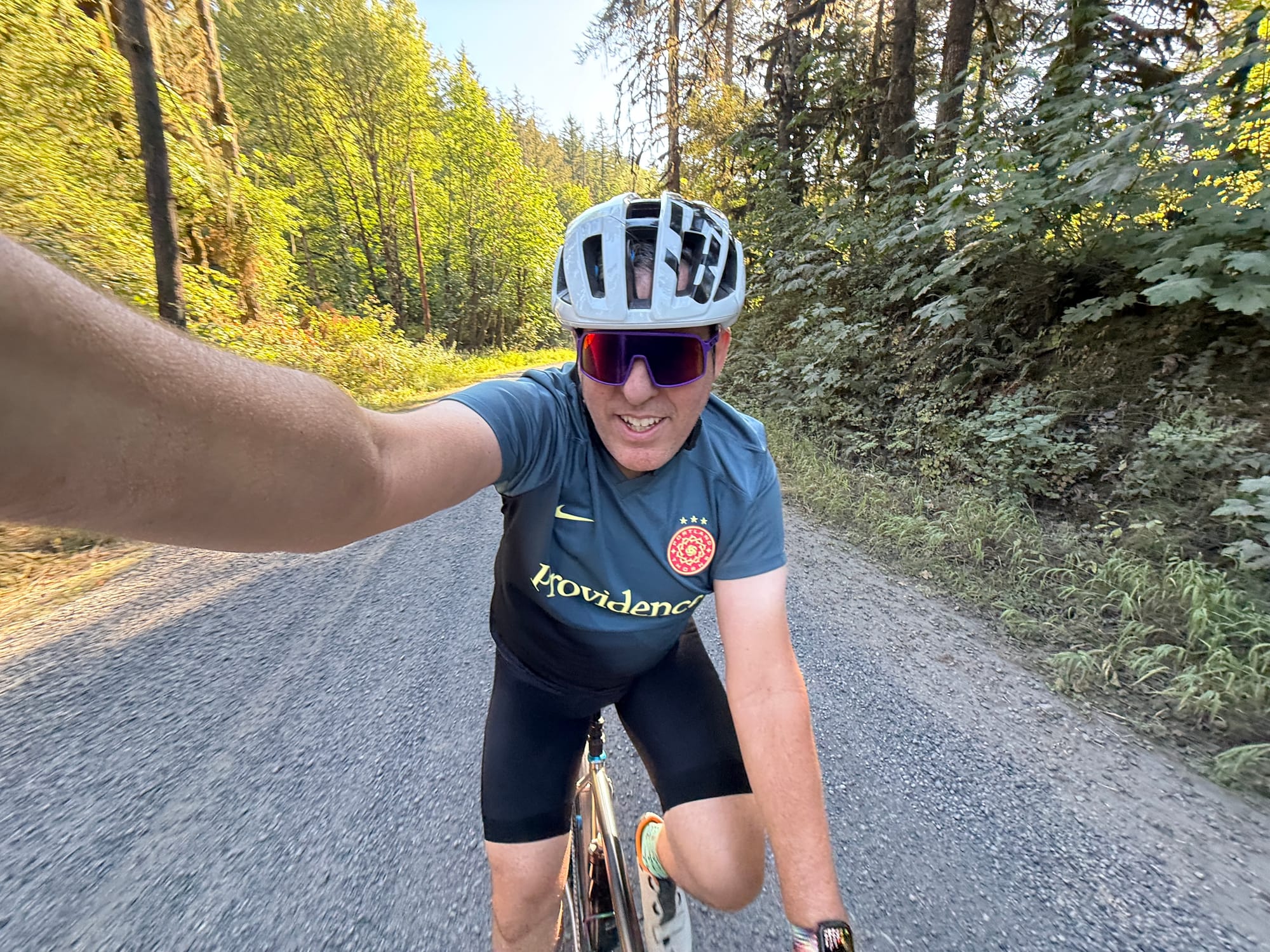
My current favorite video games 28 Jul 10:24 AM (2 months ago)
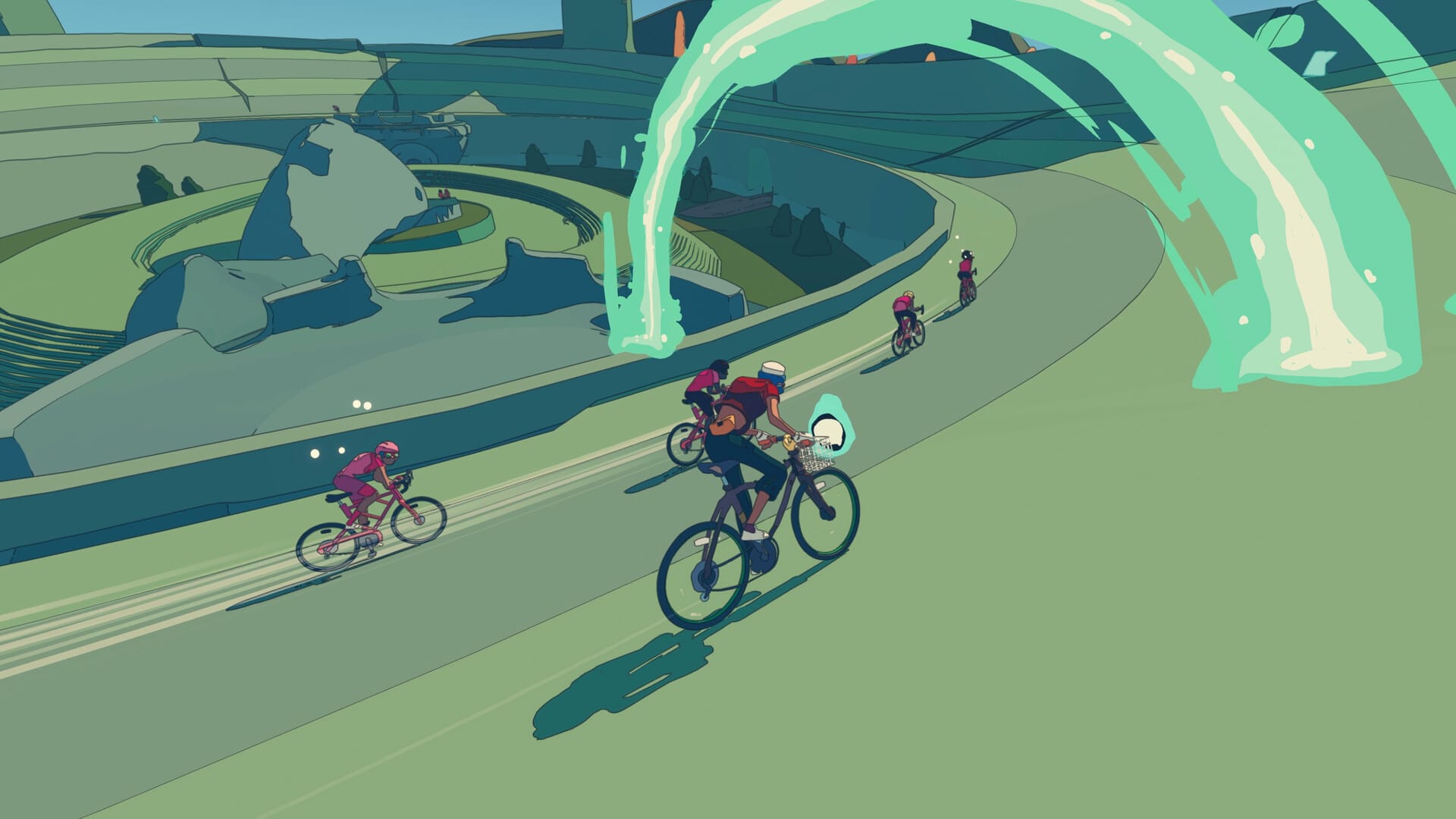
I don't know why, but video game recommendations have always been terrible for me. I've owned every major console system and had accounts on Sony, Nintendo, and Microsoft app stores for nearly 20 years, and yet, every time I go to a downloadable game store on a device, I'm met with all the most popular games, most of which I don't play.
It's baffling because each service knows what games I've bought before. Even way back in the pre-AI-everything days of the early 2000s, Amazon was pretty good about predicting what I might like based on my purchases. Why can't video game stores do the same?
I tend to enjoy the following types of games:
- Driving games, especially when you get to crash for fun
- Skateboard/bmx/motorcycle/bike games
- Open world games
- Indie games that are $20 and smaller in scope and time than the massive AAA platform games that usually go for $80
- Anything with interesting artwork or style
I find new cool games mostly on social media or from talking with friends. So in that vein, here are some of my current favorites since no video game company can suggest fun games to me, I might as well share with everyone else in case they're looking for the same.
Playstation 5
I've really enjoyed the PS5 since it came out. Even though the console itself is a weird large ugly piece of plastic, the controllers are perfect and feel faster and more accurate than any other platforms. I've literally done better at a game on a PS5 than the same game on a Switch, because the PS5 controllers are just better in every way.
Wheel World
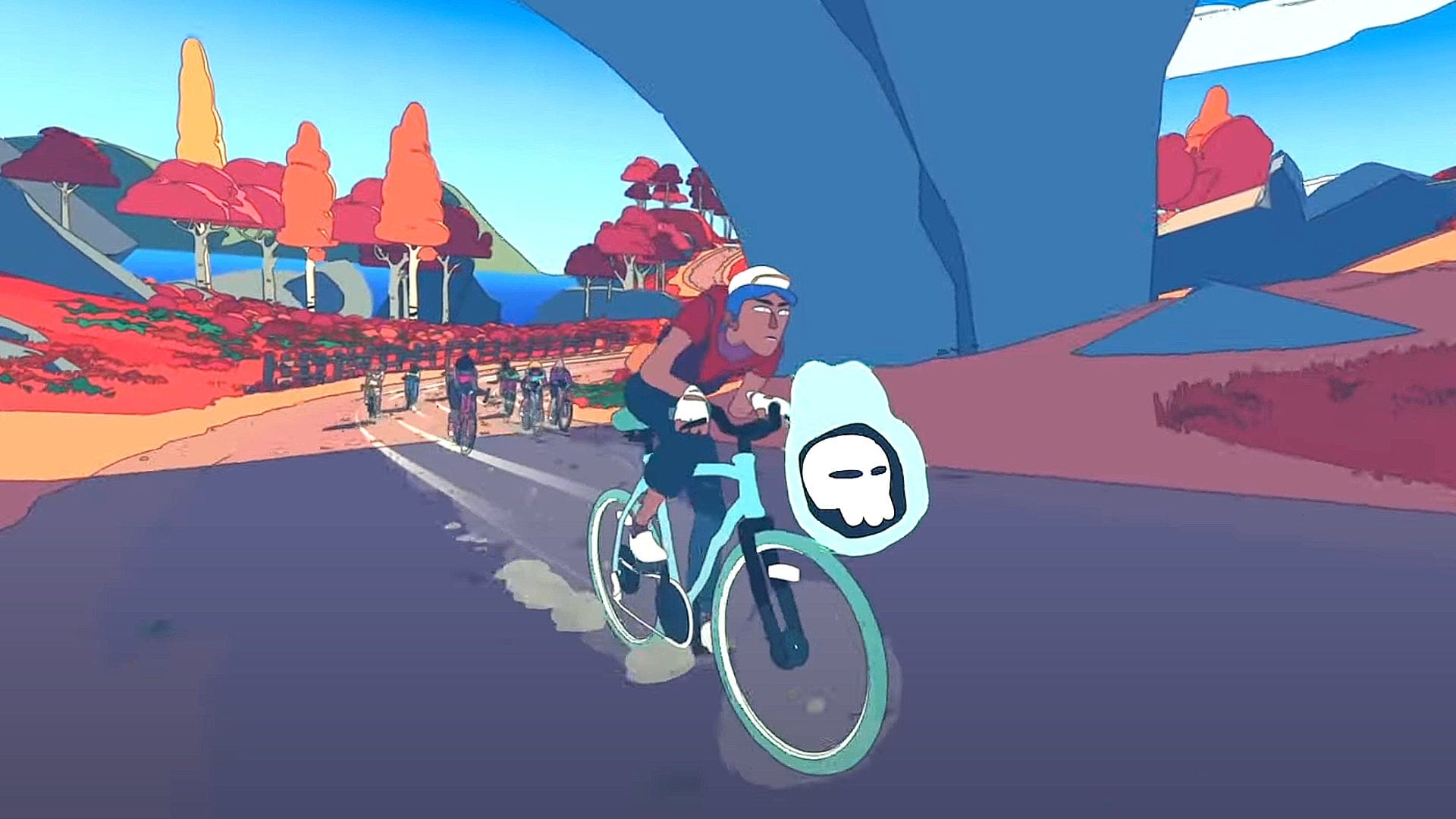
Wheel World is the reason I made this post. I had no idea it existed until Thursday of last week, even though I've bought several games released by Annapurna Interactive (they're like the A24 of video game studios). Sony knows I love bike-related games since Sam Pilgrim's Shred 2 and Pumped BMX+ have been my longtime favorites on the platform and yet, I had to search the playstation store to find this after hearing about it on The Verge.
It's an open world bike racing game that starts easy and gets pretty difficult by the end but I really loved the loose hand-drawn looks of the game and I had a blast exploring the first map as I discovered areas of interest and won my first races and kept finding free bike parts to upgrade my ride. A great fun game that you can complete in a few days that was worth its $20 price.
Astro Bot
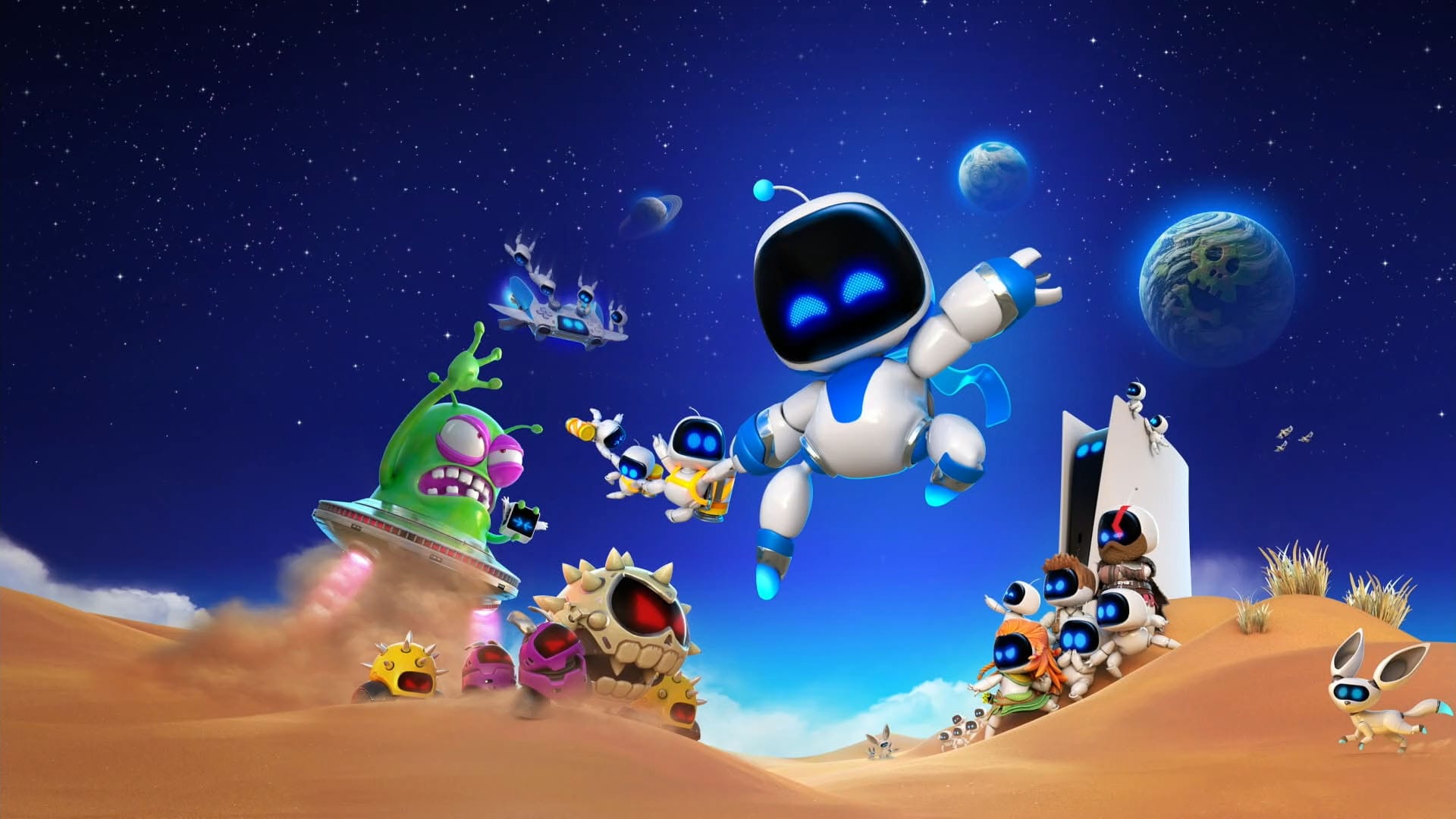
I briefly played the original Astro game that came with my PS5 and it was a good demo of the hardware and how it could be used in unique ways in puzzle games. I gave up after an hour or so and moved on to other games.
The full Astro Bot platform game that came out this year is fantastic. It's like an entire Super Mario universe where you start small, build up your skills slowly as you discover all the ways the game environment works, and eventually a few weeks later you'll find yourself up playing at 2am trying to get every hidden bonus item on every single stage. I really love the light fun nature of this and the way you discover new skills slowly over time. Nothing feels impossible and you can always go back to early levels and apply your newfound skills to them to be rewarded.
I had such a great time playing this game for a few weeks that I went back and did everything I could in the old Astro demo game that shipped with the PS5 and enjoyed taking that game to 100% completion within a few days.
Tetris Effect Connected
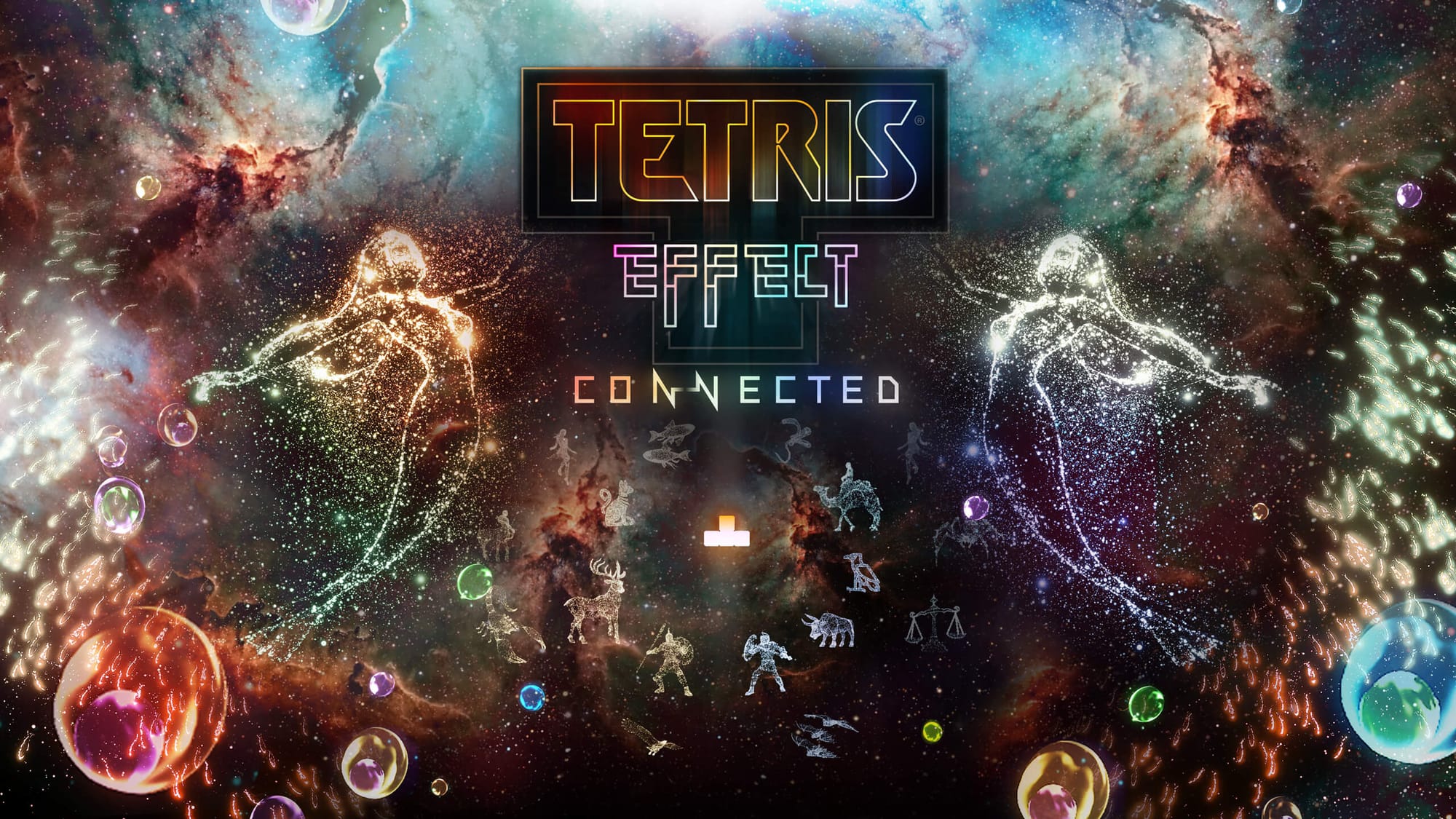
I love Tetris games and it's tough to find anyone doing anything new or interesting with the genre but I did enjoy Tetris Effect Connected. You slowly walk through dozens of Tetris puzzles that run for 5-10 minutes each, with groups of puzzles being part of a level. This gives you a pretty fun and interesting way to spend an hour or two leveling up and coming back to your progress later. It also combines interesting music and visuals to keep things fresh as each level is a little bit harder just due to a new-to-you interface on each level.
Switch 2
The new Switch is a great hardware upgrade. The screen is gorgeous if you ever play it as a handheld, and when running it connected to a TV, everything feels way faster and snappier than the original Switch hardware. The new pro controller is really comfortable to use as well.
There aren't a ton of games for the Switch 2 yet, but I will say while I am enjoying Mario Kart World, but the best parts are the races, not the open world exploring part that was added to the game. Cruising around the Mario Kart world is fun for a couple hours but I soon stopped doing it and instead go straight to racing. Similar games like Forza Horizon 5 reward players for exploring/discovering things so much so that I can do it for hours on end but the new Mario Kart falls short in that regard.
DK Bananza is super fun and feels a lot like Astro Bot above. You slowly discover and build skills on low levels and each big boss level requires you to try something new and get good at it. After a week or so I'm only about 50% of the way into the game map and I'm enjoying it, though the big bosses are getting tougher and tougher.
Lastly, I'm still enjoying old games on the new hardware. Animal Crossing is fun again since levels seem to load faster and my island looks good again after not touching things since 2021. The Puyo Puyo Tetris game is also a fun way to play a classic-style Tetris for hours. I haven't revisited any of the Zelda games from the first switch on the new hardware, but mostly because I kind of went overboard and finished them years ago and have forgotten how to use most of the controls. I really loved a full replay from the start of A Short Hike. I forgot how perfect that little indie game is, I wish there were more titles just like it.
Conclusion
I continue to try out every new skateboard game that comes out on every platform, even though none of them are as good as Skate 3 was on a Xbox in 2010. It's fun to play the retro Tony Hawk games on new hardware, but the game play and controls aren't nearly as good as the Skate universe was 15 years ago.
I continue to check in on Skate 4 development every few months and can't wait until that's available as I can already tell it'll be something I love. I don't have high hopes that any video game stores will even offer it up to me though, since for some reason they're only good at pushing me Fortnite, a game I've tried once and never touched again.
One month of using iOS/MacOS developer builds 7 Jul 8:44 AM (3 months ago)
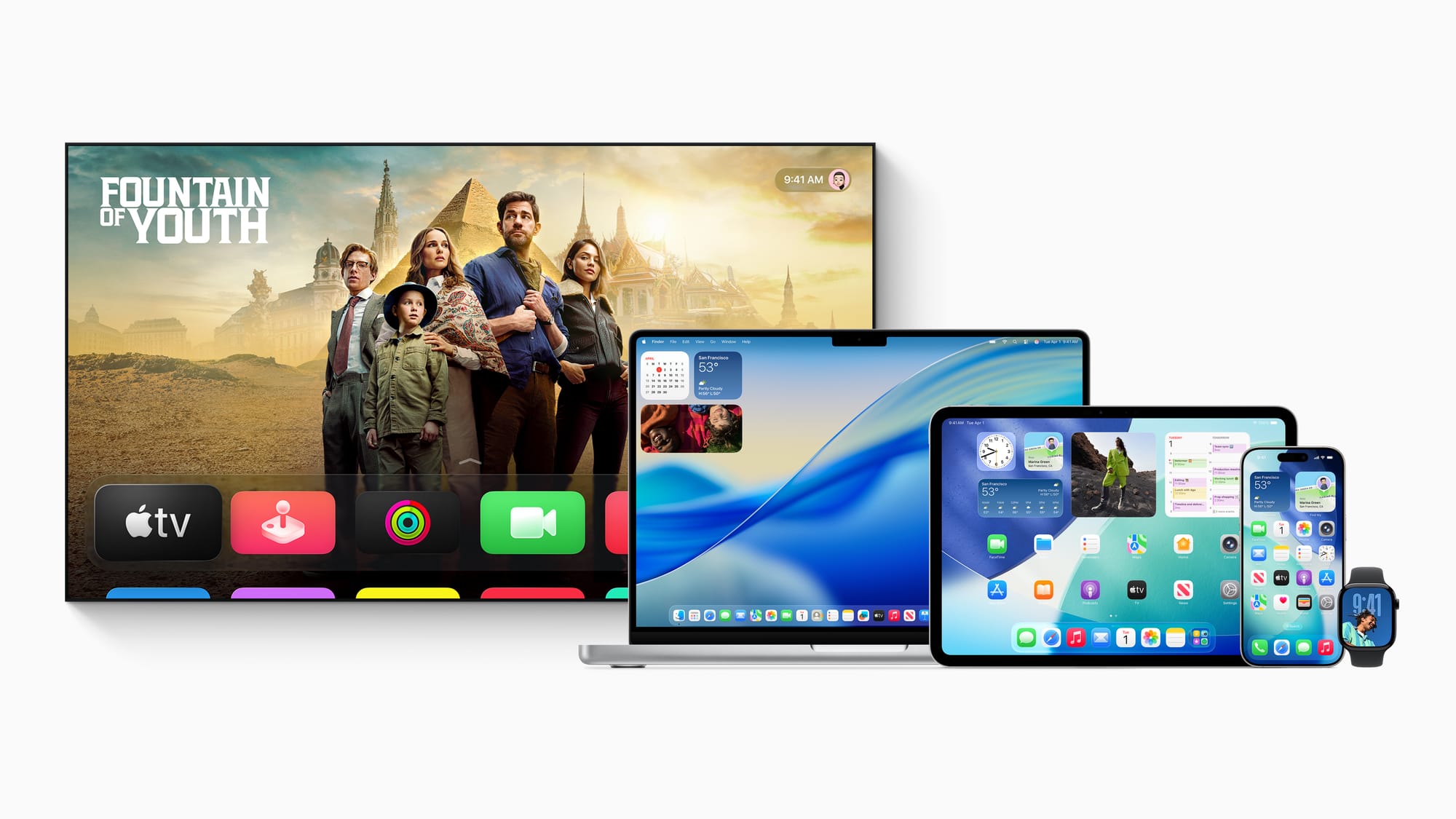
Every June, Apple shows off new features coming to their devices at WWDC, but it was only a couple years ago when I realized I was no longer working at a big company with security protocols that prohibited beta software, so I could install them on day one. So I started taking the plunge and using the new developer builds months before they get released to the public to get an early look at new features.
Caveat: I know that running early release software risks everything on my devices and I have backups, but be warned your phone and computer WILL be less stable, might lock up from time to time and might need to be restarted.
What follows are my initial impressions, one month in while using new OS software on all my Apple hardware, including problems and highlights of things to come.
iOS26 (iPhone and iPad)
The new "liquid glass" look comes off as fun at first, but legibility was a struggle on the first beta. I'm on the second beta now, and they've fixed some contrast issues and I suspect they'll fix most of them before the final public release in October hits phones.
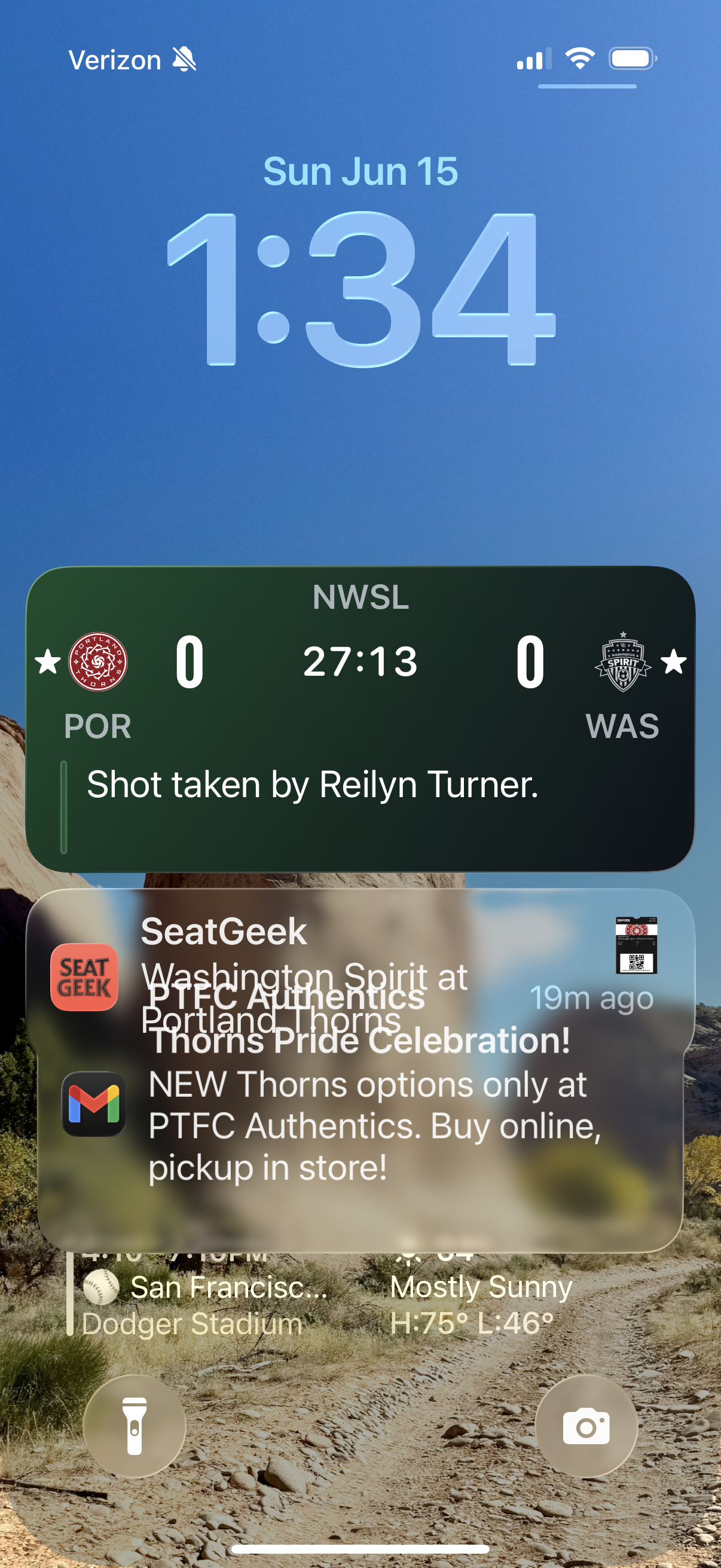
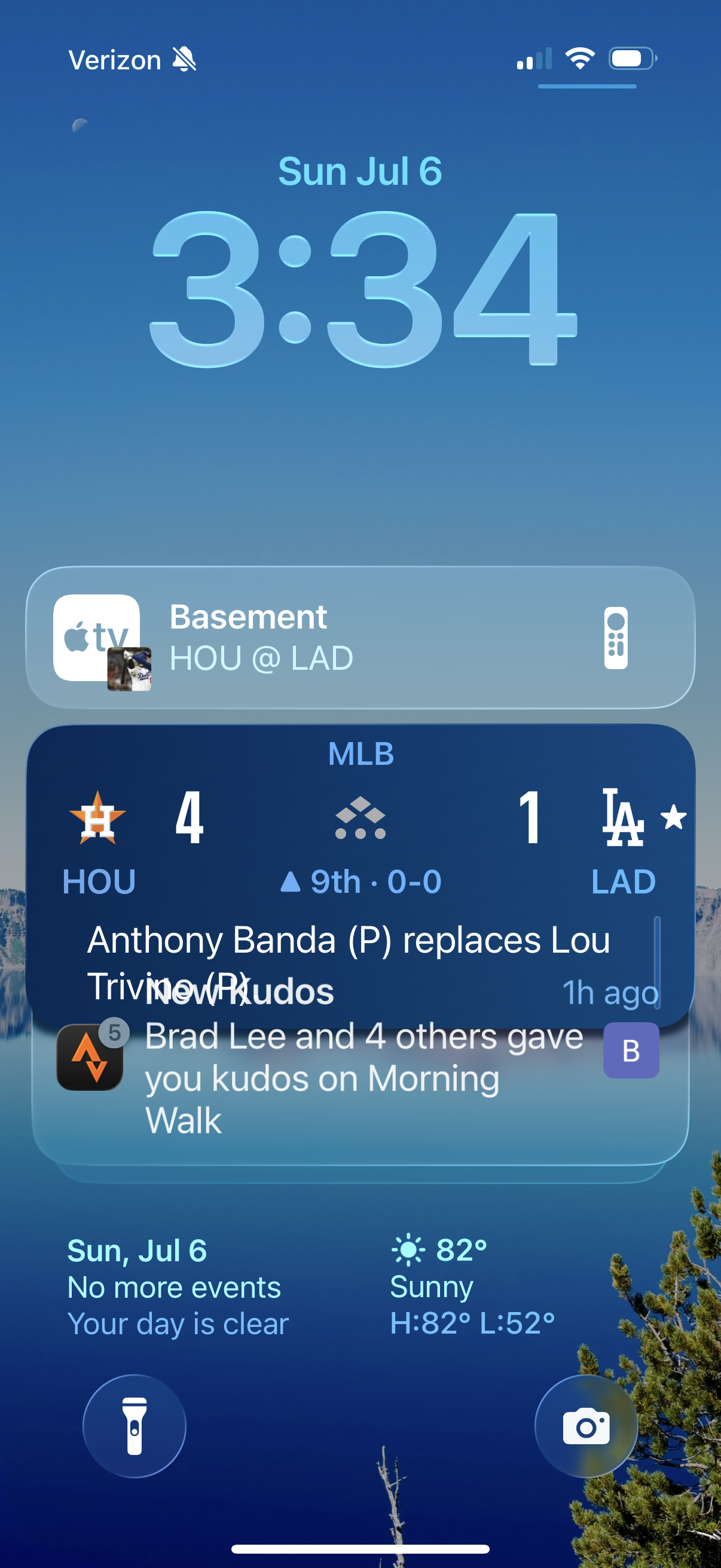
The biggest issue seems to be text overflowing in the lock screen, as notifications flop text over one another making them unreadable. It continues in the second beta release.
The iOS Safari browser has gone through a pretty significant redesign in how it handles multiple windows and you'll have to hunt around for a view of all your tabs, but that's mostly because iOS26 is stuffing a lot of toolbar buttons into a little menu marked off with a tiny … icon. You get used to looking for it in every app when you can't find something.
Battery life on my phone is pretty abysmal now, but that's probably because battery life optimizations are the last things to go into a new OS release. I seem to have to charge my phone about twice as often as pre-beta days.
There are some fun aspects, the lock screen pulling nature photos from your own photo roll is actually quite impressive. The new emoji word-guessing game in News is fun too.
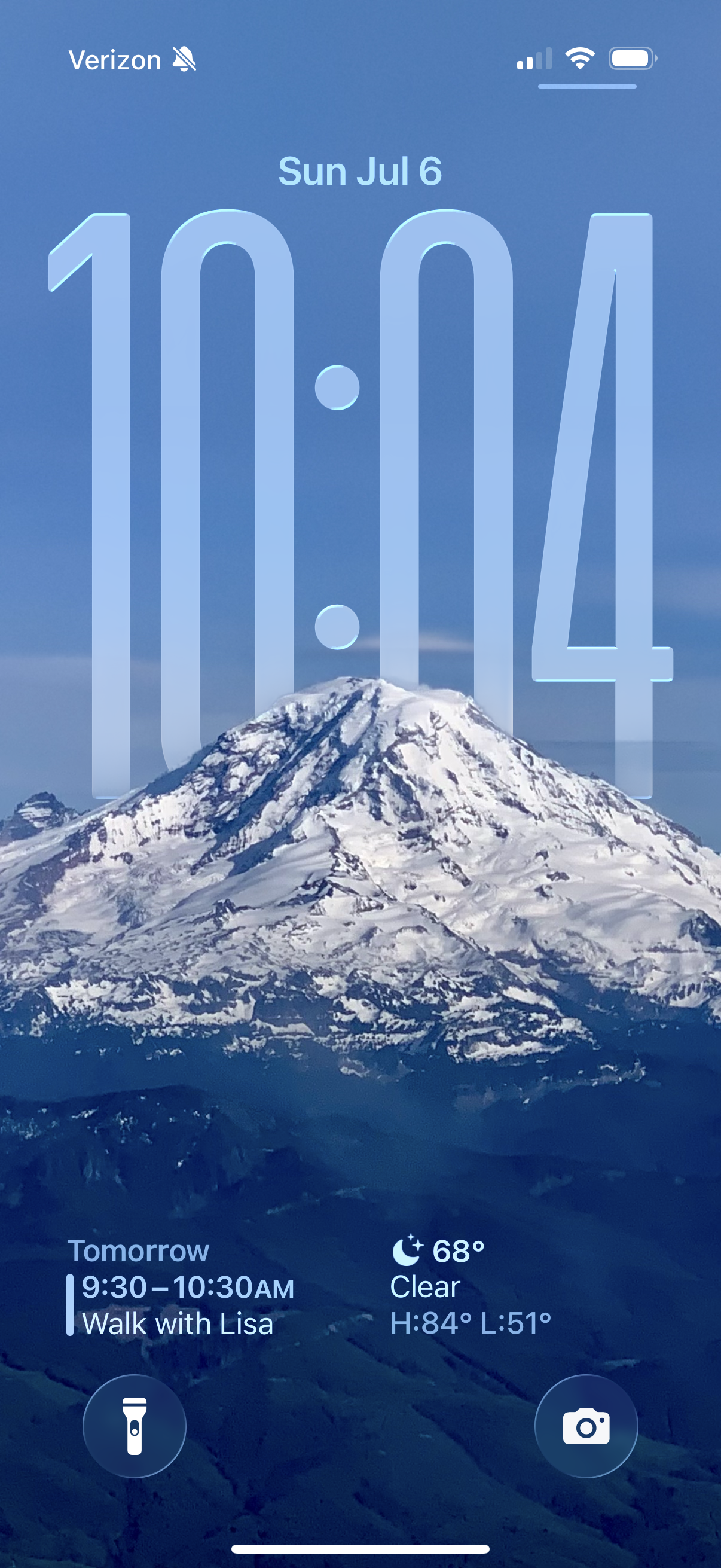
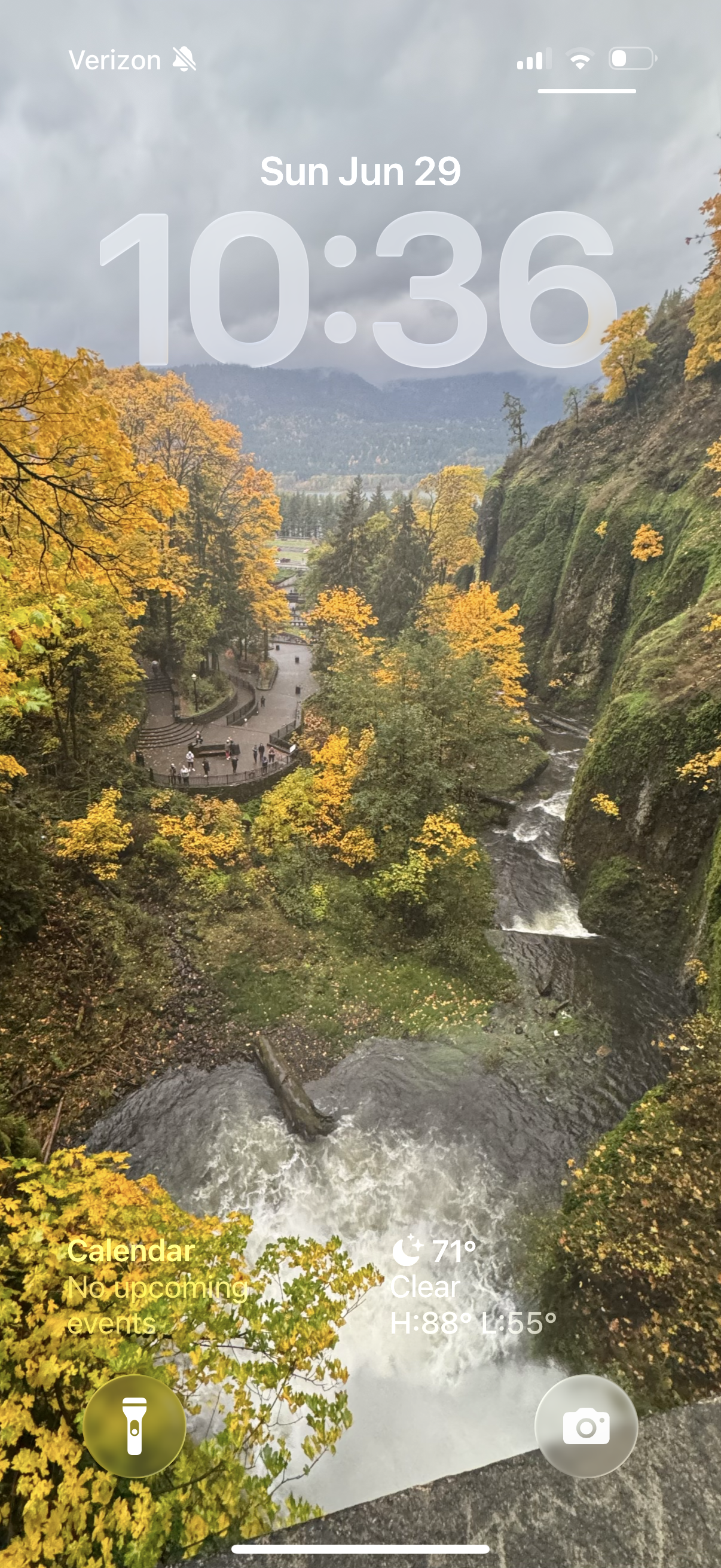
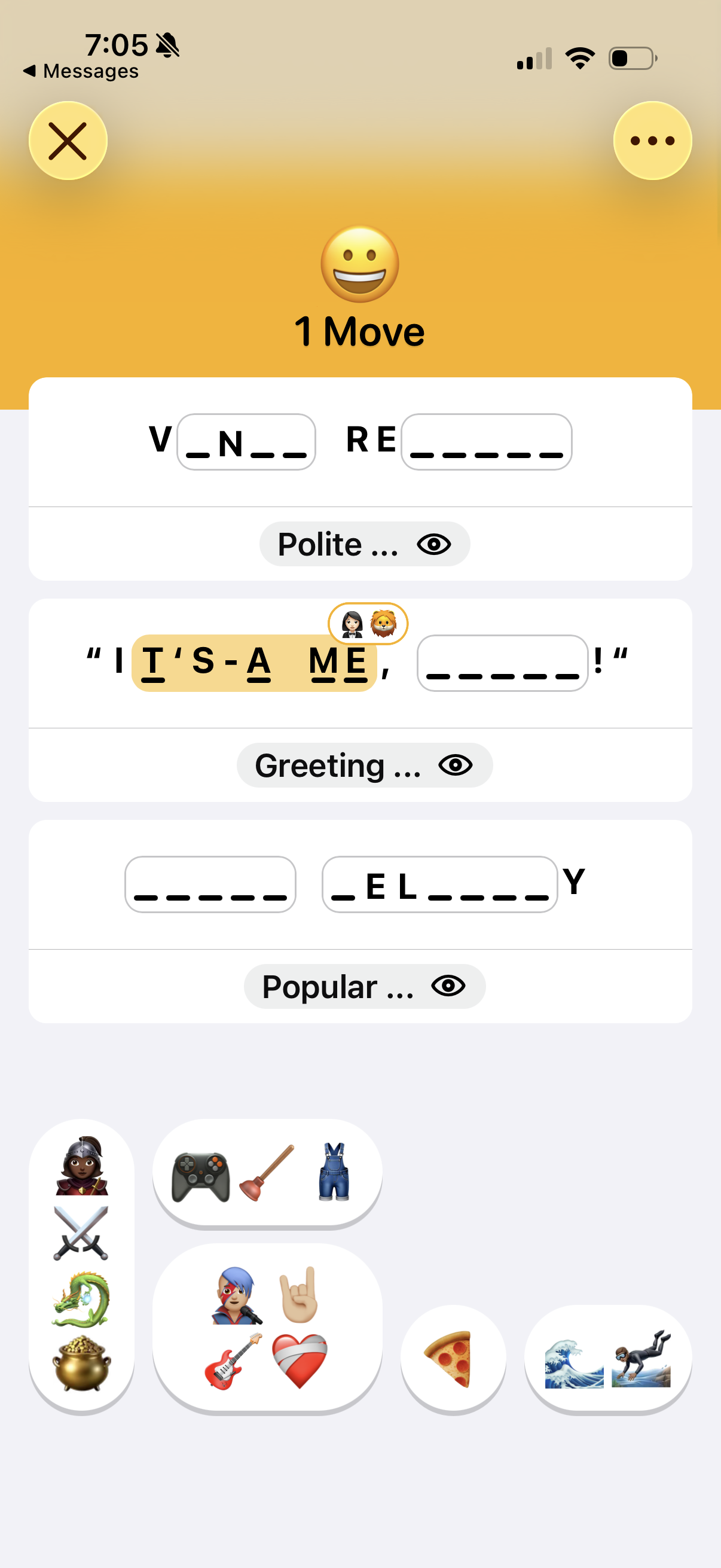
On my iPad running iOS26, I enabled the new multiple window interface and it really does feel a lot more like a desktop than a phone. One of my biggest gripes on trying to use a iPad as a real work tool was it was too hard to switch between apps or grab info from multiple windows to combine into others, but the new iPad OS looks to fix a lot of those problems. I bet with a real mouse and a keyboard I could finally get some real work done on an iPad in ways I couldn't before. To date, I've always used my iPad in a mono-tasking way because that's how the interface was presented to users. With the upcoming changes, it really feels more like a full blown desktop OS.
MacOS
The "liquid glass" interface is more subtle on a Mac, it mostly reminds me of the throwback "Aqua" interface of MacOS 10 in the early days. Stability has been good so far, with no real issues with the beta crashing apps or the OS.
So far my biggest nitpick is how Safari handles your tab bar. In previous releases, tabs you're not currently viewing would appear as greyed out, making it pretty obvious which tab was "live". For some reason, they switched it to putting an underline on all dormant tabs with the active one having no underline.
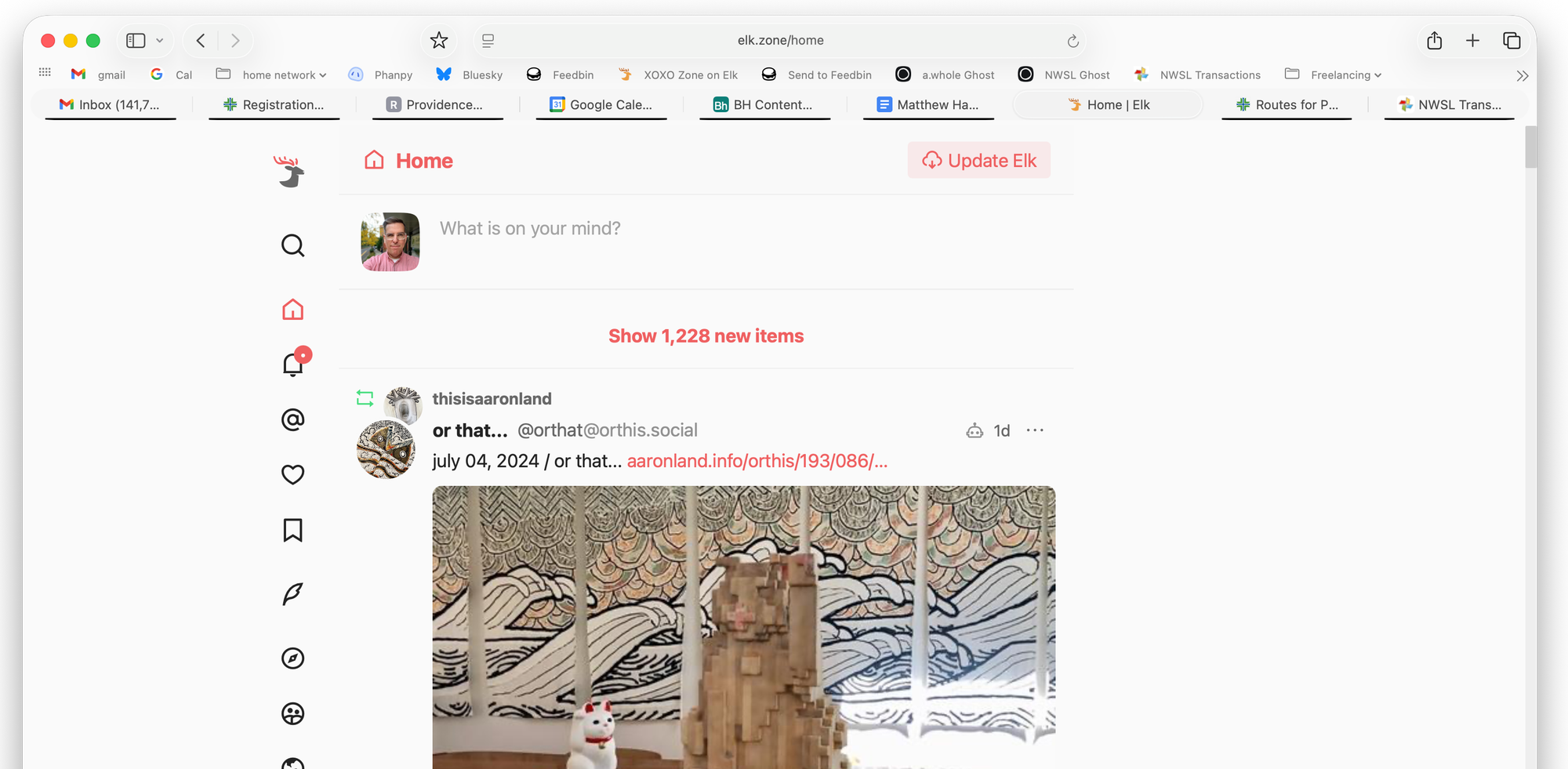
Look at the horizontal display of tabs in the screenshot above. Is it super obvious the "Home | Elk" tab is the one currently being viewed? I keep finding the opposite, as my eyes are drawn to the underlines automatically, as they seem to grab more attention than a simple plain tab.
This feels like one of the interface missteps that show up in new betas and I really hope they revert this before the final release around October.
CarPlay
CarPlay has a bunch of nice little tweaks. You can customize icons as light, dark, or even clear. Maps now render full screen with menus and toolbars floating over maps.
There are new widgets and I noticed once I even got sports scores on my CarPlay home screen during a game, which was nice. It's great to finally see Weather in CarPlay and I'm happy to see more HomeKit features appearing in CarPlay. With new HomeKit widgets you could run custom shortcuts much more easily as you drive home each night, to automatically open a garage, turn on some lights, and kick on your A/C.
My biggest gripe with CarPlay is that horizontal screen space is most important to getting information on small screens in cars, and Apple really should follow the lead of Android Auto and move their app switching element from the left side to the bottom of the screen, giving more space to displaying apps side by side.
It's especially obnoxious on tall car touchscreens, as you sometimes see a really tiny cramped CarPlay view that's only 5" wide even though a car's physical screen can be over a foot tall.
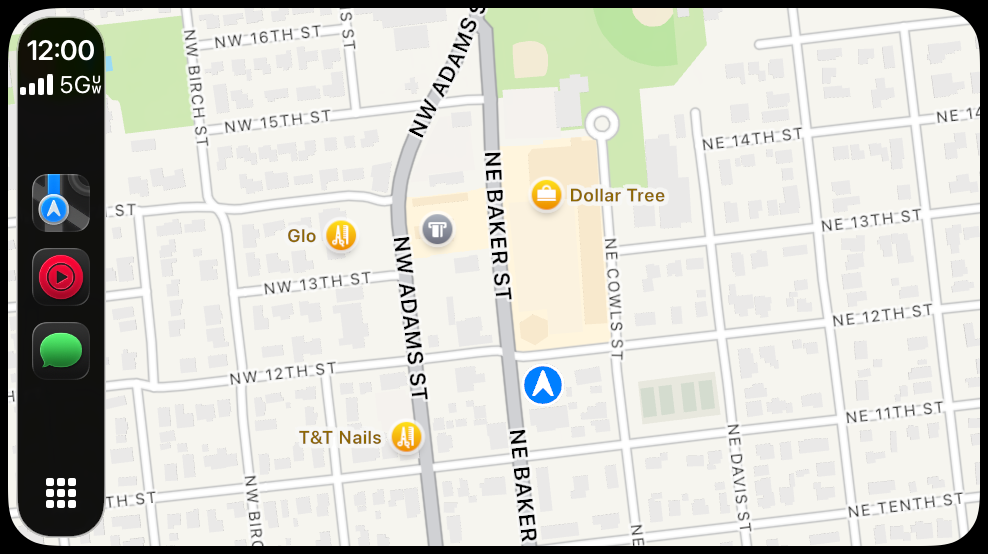
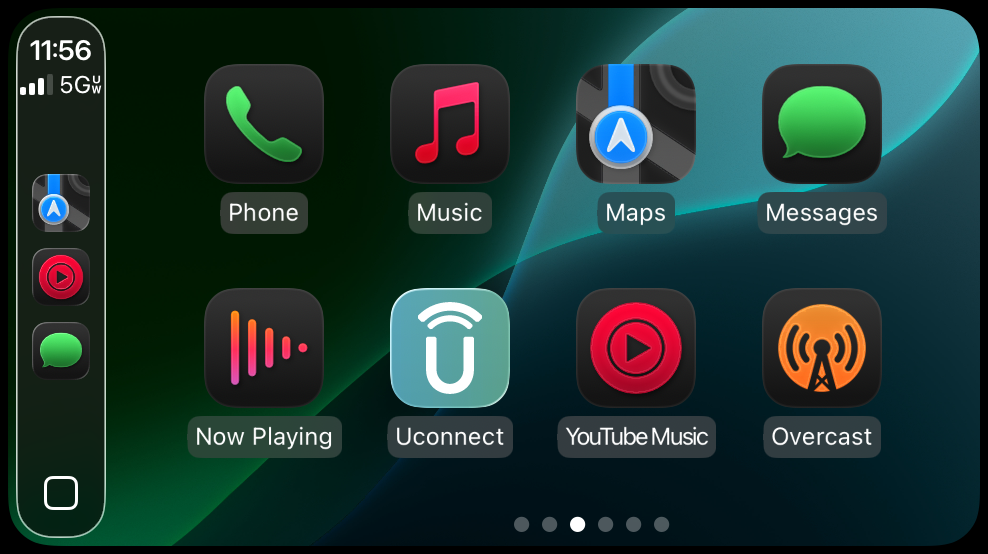
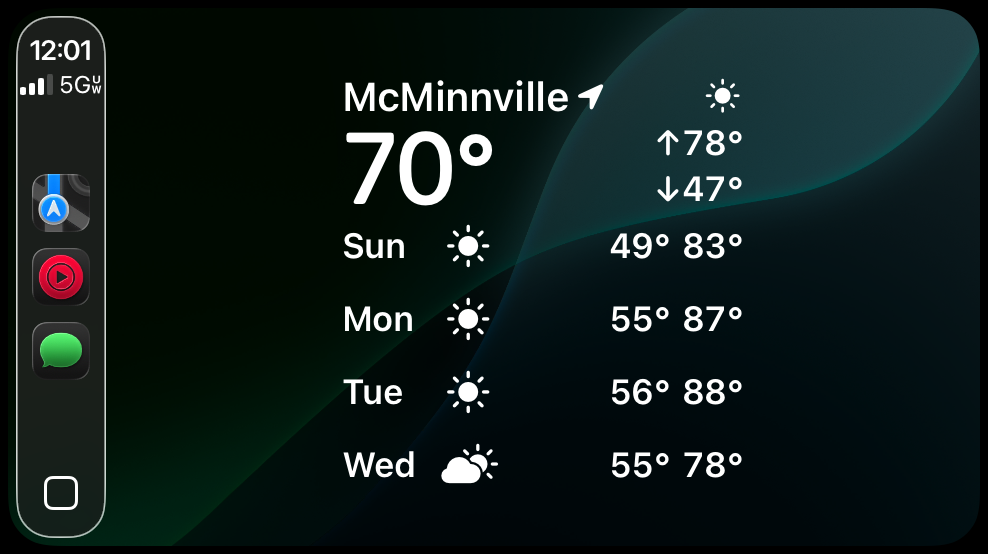
Apple Watch
Not a ton of changes aside from some subtle interface tweaks and again, abysmal battery life. You really notice it on the watch, as my battery is hitting 50% gone by most early afternoons, when that usually took 12+ hours of wearing it before I'd see that on the previous WatchOS. I'm sure they'll fix that up by October.
Overall, I'm pretty happy with the new look and features though a lot of parts feel rough and in need of optimization. I haven't taken the plunge on my AppleTV devices but will after the public betas come out.
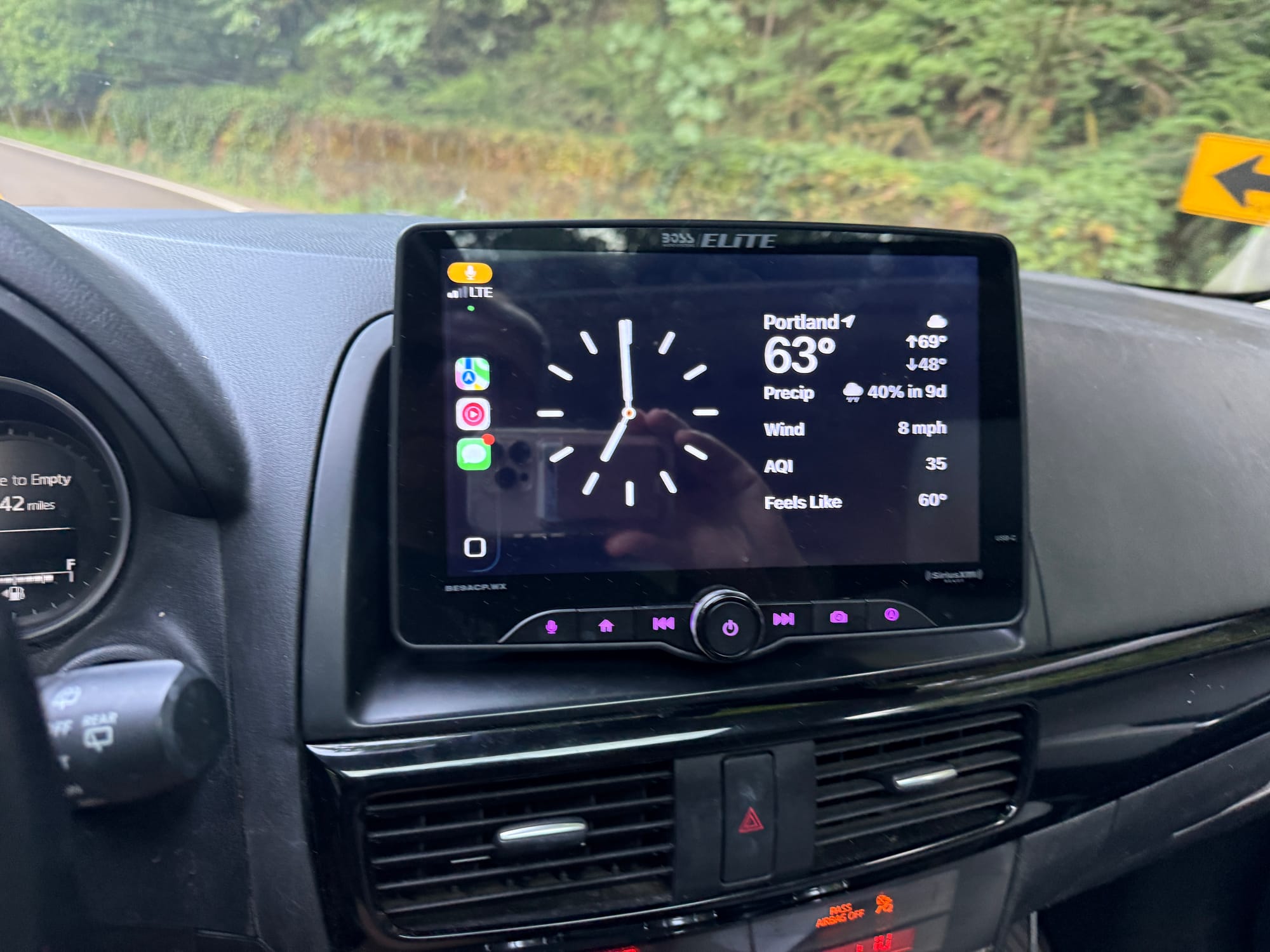
Food reviews during the federal occupation of LA 16 Jun 12:43 PM (4 months ago)
There's a guy I've been following on YouTube for his food reviews in and around LA for the past year or two. He exclusively takes public transit to get from place to place, so I also love the bonus reviews of Metro trains and buses as they continue to grow.
He's like a junior version of Jonathan Gold, going deep into the heart of LA every few weeks to unearth true gems from restaurants that operate out of an alleyway or above a laundromat. He also reviews viral LA eats and I'm always curious to hear what he thinks because you never know if popular things are truly good or just popular for some reason.
Today he uploaded a new video, reviewing street vendors during the NoKings protests over the weekend:
What I love most about this is that by simply turning on a camera as he walks around you see that while there were tens of thousands of people there, everyone was chill, but when he pans the camera towards federal buildings, you see mostly masked US Marines holding guns standing around what clearly looks like a peaceful neighborhood gathering.
The juxtaposition of people standing around with signs against a hostile invading force complete with helicopters circling couldn't be more stark, and really illustrates how unjust and ridiculous the current president's actions are.
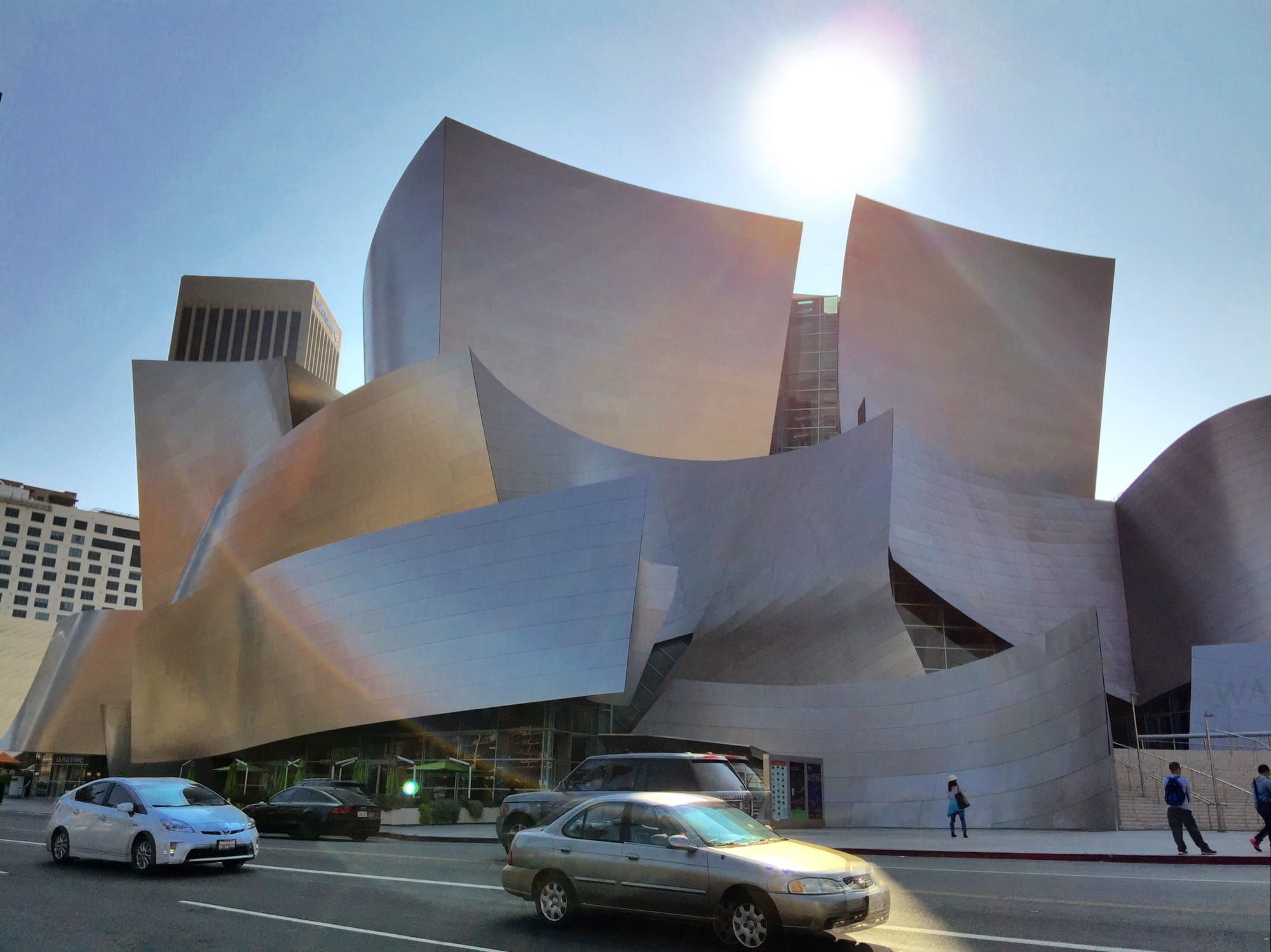
Visor is the best app for car shopping 10 Jun 12:46 PM (4 months ago)
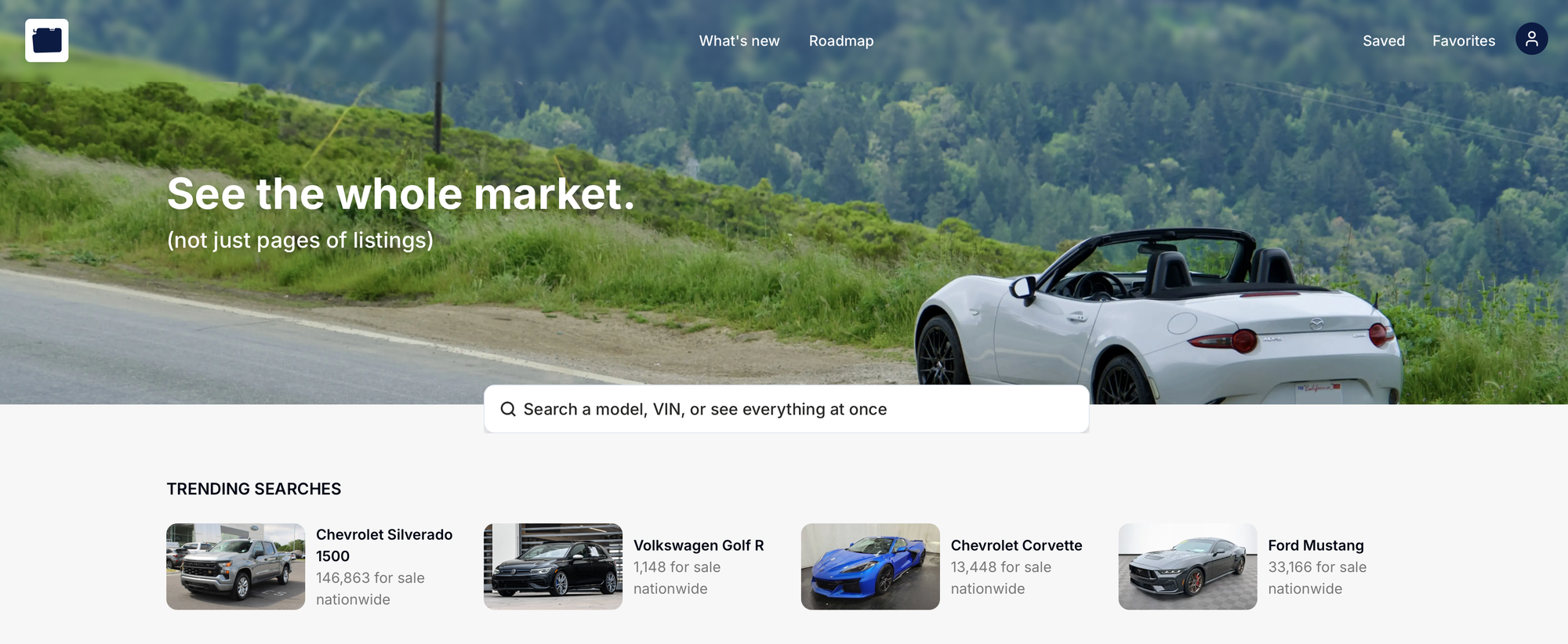
A few months ago my pal Joel mentioned a new car shopping app to me and even though I only buy a car once every several years, I love to browse listings or figure what my current favorite car is that I don't own, or be able to find the cheapest example of any car I can think of in America as quickly as possible.
As a kid, I watched MotorWeek religiously on PBS and browsed Road & Track at my local library from cover to cover. I'd read the local Autotrader or Pennysaver or Recycler often just to browse what was out there, and eventually I moved on to browsing Craigslist late at night looking for gems I'd never buy (or even get to drive).
These days, I mostly stick to sites like cars.com or multiple-craigslist search sites but they're never quite right and you can't always see things on a nationwide level.
 Visor
Visor
I've been using Visor.vin for several months now and it does everything you can imagine. You can look up a car, then look for only used ones, then only ones with the touring package, and then only ones with the green exterior and the tan interior. You can filter cars endlessly to where you can find obscure models that might only number in the couple dozen nationwide, and then find ones going cheaply because the sellers don't know what they have.
Here's an example: a few years ago Volvo released a version of their largest wagon, the V90, in an "Ocean Race" edition, to represent an America's Cup style yacht race team they sponsored. They only sold it for a year, priced around $70k when it was new because it had every option possible plus some custom stuff just for that trim.
Here's a screenshot of the couple dozen used ones that exist in the nation that are for sale:
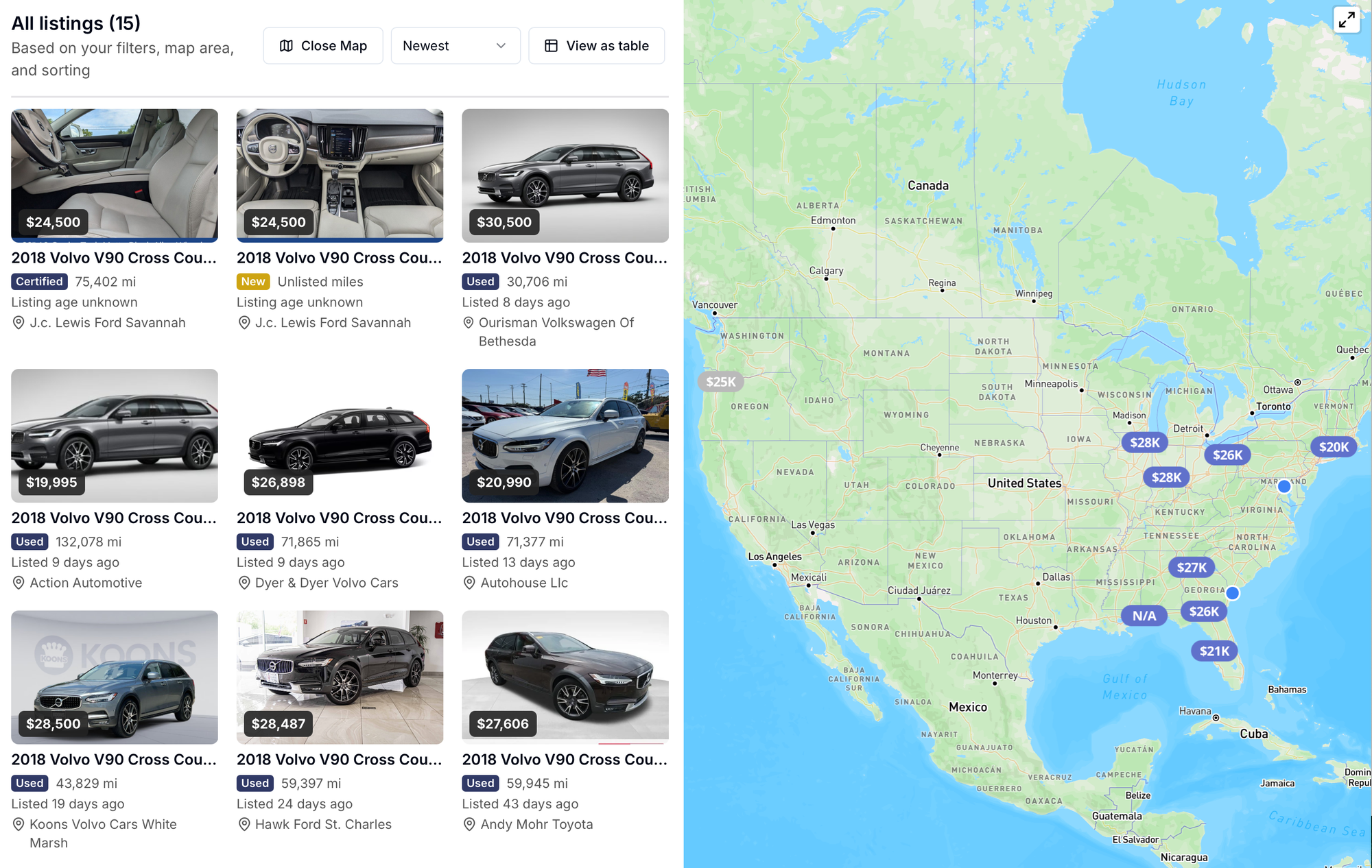
Visor also has a mobile app, and here's me looking for a used Honda Prologue EV Elite model in just blue because I love the weird turquoise Honda sells it in, and while these new on dealer lots are going for $59k right now, you can find them in the low-to-mid $30k range with less than a thousand miles, quickly and easily on Visor.
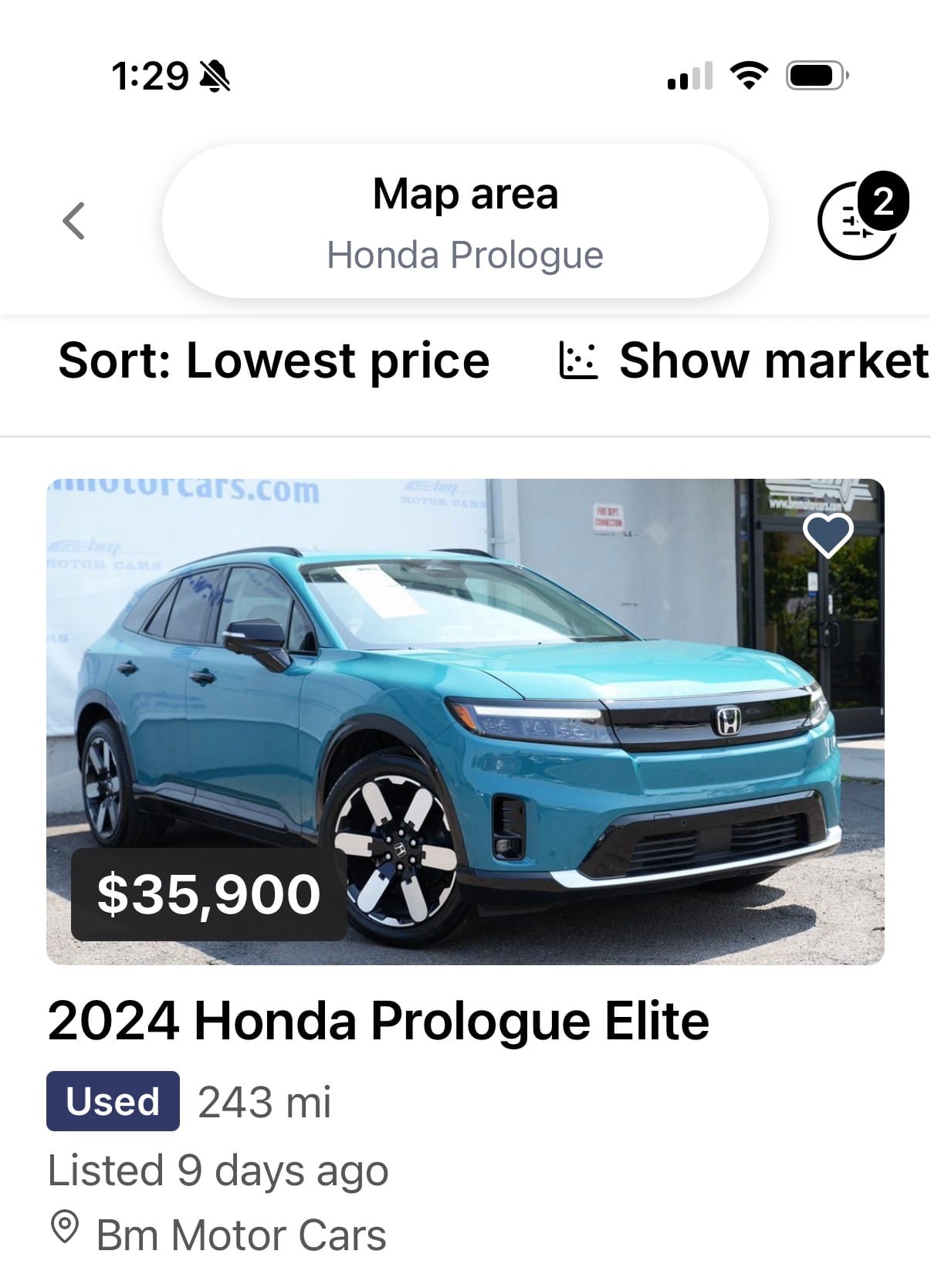
I also love their car detail pages. Every other website that lists cars makes you view small images in a gallery or carousel that requires tons of clicking. Visor just puts all 35 photos on a single page so you can see everything at once. So many features at Visor are like this, just totally user friendly.
The perfect tool for the perfect used car
I'm usually "the Car Guy" among friends and people come to me for advice on how to find ones they‘ll like. I love playing matchmaker and I give out recommendations freely once I know what their needs are, and lately I've been telling everyone to seriously consider a used EV for their next daily driver.
A typical gas-powered car contains tens of thousands of parts that can fail in the engine, the drivetrain, the brakes, and the exhaust, while an EV has batteries and a motor and then the interior. EVs are cheaper to build, cheaper to maintain, and most are garaged for nightly recharges. They'll run for decades until the batteries give out, so you can think of them like a golf cart. Or, think of an EV more like a dependable toaster on your kitchen counter than any other car has been before.
Also? EV car prices drop like rocks. Typically, most EVs can be purchased used for about half their original price after only 2 years. And Visor is a killer app for those kinds of deals.
If you know exactly what make, model, and options you want in a new or used car, Visor is amazing at finding the needles in the haystack, in just your state or nationwide.
I can't recommend Visor highly enough if you're in the market for cars. I don't know the people behind it (I think it's just two people?) and they didn't pay me to write this post and I even pay for the app myself because I find the pro features so useful.
I have a couple dream cars I keep tabs on every couple months, and if their prices ever drop from the original high stickers down to $20k-30k, I think it'll be time to take the plunge on a used one someday.
Lael's ride around the globe 29 May 11:56 AM (4 months ago)
Last year I remember hearing about Lael Wilcox's ride around the world and how she was gunning for the fastest known time for any woman who has ever done it. Every couple weeks I'd check in on her dot as it shifted around the globe and when I was at the XOXO conference last August, I heard someone at the event say she was on the Oregon coast as we were talking and I kicked myself for not staying up to date on her progress so I could meet up and ride with her a bit.
The film embedded above is about 90min long but every minute is worth watching as Lael takes off from Chicago, heads to NYC, then to Madrid, across Europe, then to Australia, New Zealand, then up to Alaska to ride back to Chicago. It was filmed by her wife as she did daily check-ins and it's gorgeous to look at and amazing to watch as the scenery changes.
This really is a big, big deal
As a longtime cyclist myself, I can't describe just how hard what she did was. Personally, I've done half a dozen century rides and my longest day ever on a bike was around 120 miles.
The thing is though, like marathon running, you run out of glucose and calories and energy before you hit the 100 mile mark even if you stop for lunch and take lots of breaks and I used to have a lot of fun on long event rides up until about 80-85 miles. After that, every minute on a bike was pain and exhaustion and wasn't so fun.
I never got the hang of taking in enough calories to replace everything going out and it's why I stopped running marathons after completing my first, and I probably won't do a century again for the same reasons. They're painful and you end up feeling completely wrecked by the end.
I've had friends ride the Race Across America race as well as the Continental Divide race that goes from Canada to Mexico along the Rockies. Those friends typically did 150-200mi consecutive miles in those events, day in and day out, and Lael did something similar but for even longer.
She rode 18,000 miles in barely more than 100 days, meaning she had to average about 175mi per day for over three months straight. And if you watch the film, she's smiling almost the entire way, even when the roads suck and freezing rain is pelting her for hours a day.
Back to the film
Her joy is infectious and I found the movie really uplifting. I was in awe of her physical accomplishments but also loved seeing the beautiful landscapes as well as how she deals with everything. I was practically brought to tears any time she got to see a friend along the route, because I remember being on long runs or rides and getting that small injection of joy when someone you know came out to cheer for you. It's remarkable when you're otherwise suffering all day alone.
You can tell it was an incredible thing she did, but she also slept enough, ate well, and rode with and talked to as many people as possible. She's clearly enjoying it even though it's one of the toughest things I've ever seen a person do.
I've heard rumors she's going to try this feat again someday soon, and go for the fastest known time ever by anyone on earth, which I think is around 78 days. That's about 230mi/day and it's certainly possible for her with a few extra hours on the bike each day.
I can't recommend the film above highly enough. It's chill, it's gorgeous, it's uplifting and I came away from it inspired to ride my bike a bit more this week.
Add it to your Watch Later list and pull it up the next time you're in front of a TV.
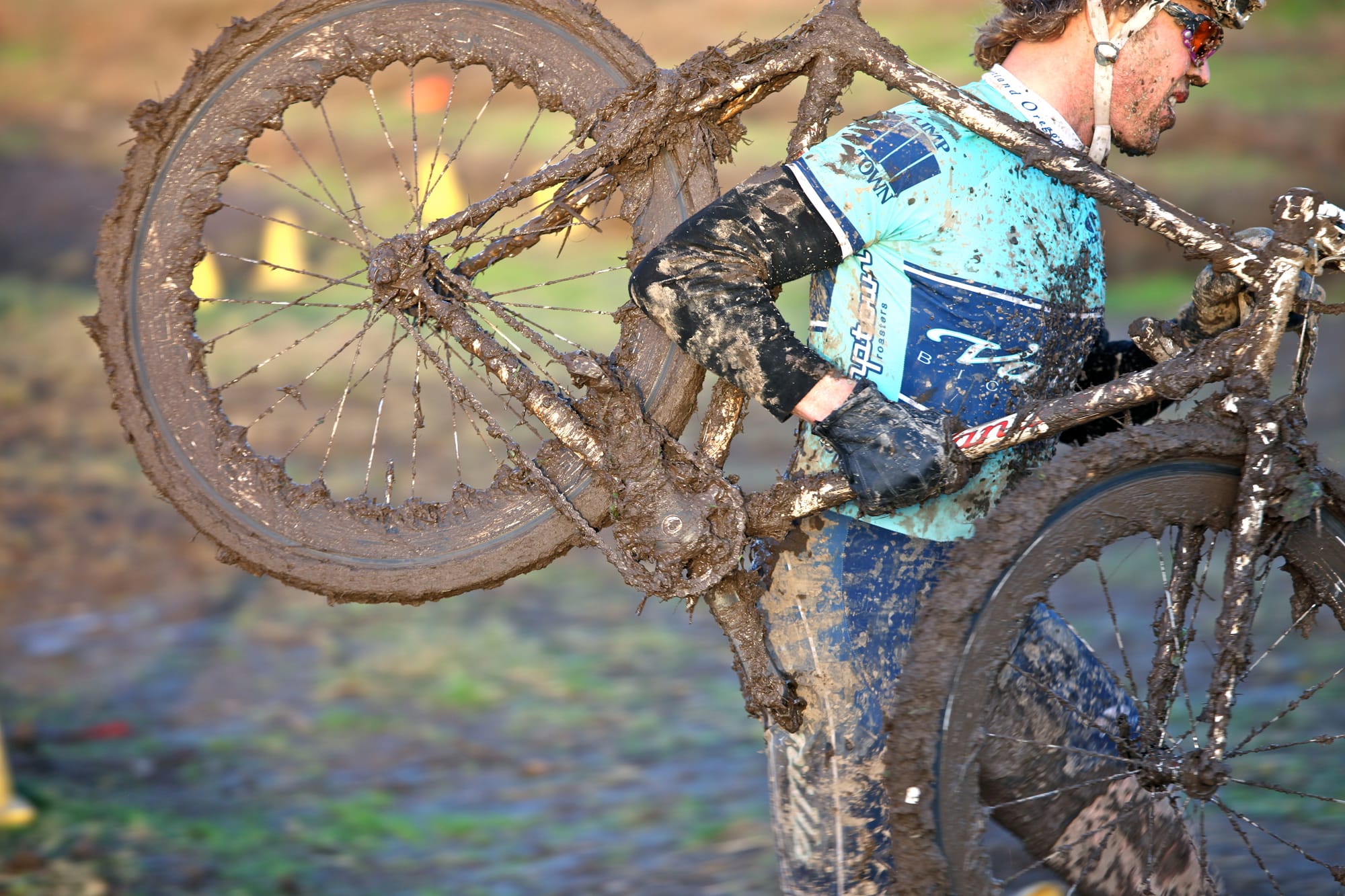
YouTube revenue and recent good ones 27 May 8:39 AM (4 months ago)
There's an interesting trend in YouTube land lately, which is prominent creators talking about how little they make from YouTube/Google itself, instead needing brand deals to advertise a product inside their videos to truly make a living.
For high-end channels that put out weekly videos, they often have a team of 4-5 people behind the scenes, shooting video and editing it all and getting everyone paid but it doesn't make sense based solely on YouTube/Google's ad income. Instead, they take a break into the middle of their video to talk about SquareSpace or BetterHealth, and the creators I follow admit they get $5k-$30k for those ads, while the same video might only make a few hundred bucks from YouTube. When I hear this, I'm both shocked at how high the ad rates are for an embedded ad read but also how little YouTube/Google pays their creators.
This post from a cookbook author who ran a cooking channel for several years shares comprehensive accounting on her real production costs and her actual Google ad revenue. It's a little bombastic since she claims she "loses" $10k a month (until she reveals the brand deals cover those costs), but her story is similar to one I've heard dozens of times before, which is: if you create videos on YouTube with the production level of a network TV show, you'll never be able to pay for it with views from YouTube ads.
I don't know what YouTube is going to do about this, because the amount of people that rise to this level is a minuscule amount of their total uploading population, but on the other hand, those network TV-quality shows are what draw most people like me to watch YouTube day in and day out. But it's interesting that the environment YouTube created isn't self-sustaining at the high end. Unless you're Casey Neistat doing literally every single thing yourself, you can't pay for all the hours required to produce videos by a team.
The one thing I will note is that the cookbook author reveals Google keeps 2/3rds of total ad income, giving creators one third of what comes in. That seems ridiculously high and something YouTube should adjust to better support their creators.
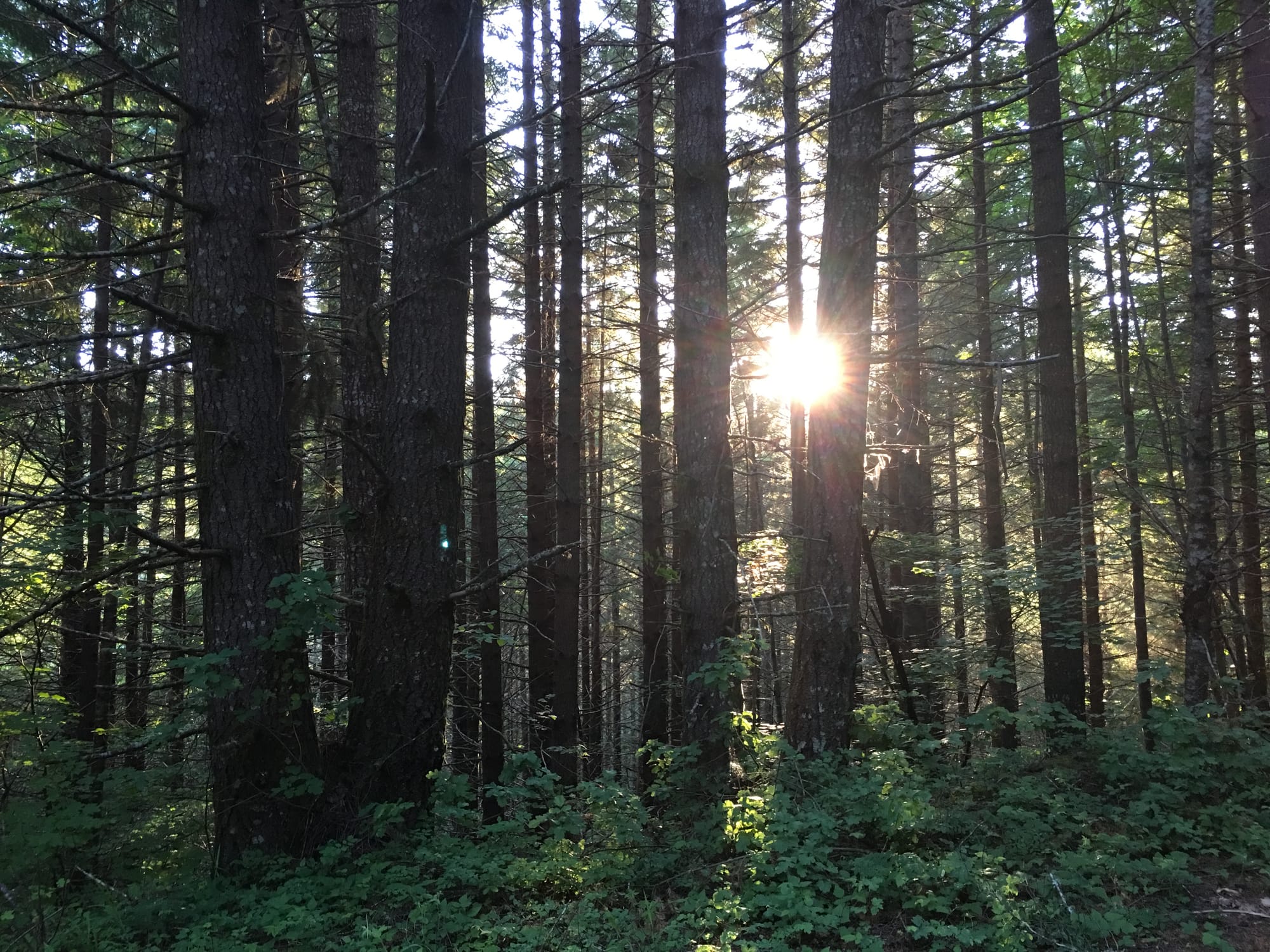
Good recent YouTube videos
This Bob's Burgers parody is amazing, the voices and jokes are scary accurate to the wonderful show I love.
I recently finished the second season of Andor (and jumped right into a Rogue One rewatch) and the whole series was utterly fantastic about how it tackled big subjects and felt like an adult show about something I always thought of as kind of silly as a kid. Anyway, amidst all the recaps and wrap-ups I watched on YouTube after I finished, I loved Stephen Colbert talking to the director/writer Tony Gilroy and actor Diego Luna for an hour about the second season. It's fun, funny as hell, and loaded with insights about how Gilroy approached the project.
Another fun one: Will Forte in a business meeting sketch where he has no idea what the script is and has to improvise while everyone else drives the scene. It's funny, but when you realize no one is swearing and people get nervous when someone makes a joke about divorce, you suddenly realize this is a Mormon comedy show that's apparently popular in Utah. Still, great comedy often comes from restraints and I'm even more impressed with Will Forte's chops knowing he can't touch any controversial subjects to get a laugh. He really threads the needle here.
I caught this Kickstarter project making a splash but I'd never heard of a UV printer and didn't realize what was possible with it until I watched this about it.
It's pretty remarkable, as UV kind of combines 3D printing with inkjet printing, but it also works on almost any surface and this really feels like a major shift in desktop production. If you're an artist of any kind, I would strongly suggest you spend 30min watching this to see how it works because I could easily see Etsy stores exploding with cool custom stuff thanks to printers like this new UV one.
Philips in the Czech Republic gives away 3D printer files for replacement parts, so you can keep using their products instead of throwing them away to get a new one because you lost one of the adapters. This would never happen in the US, but I really loved seeing a big global company take on a good project like this.
This Dyson new kitchen vacuum demo is so simple and spartan and reminds me of the old days of Steve Jobs doing simple live demos on stage 30 years ago. It's such a refreshing break from the overly scripted demos that film on location with perfect lighting and sound. It's just an old guy showing off his latest invention that looks like a pretty promising product.
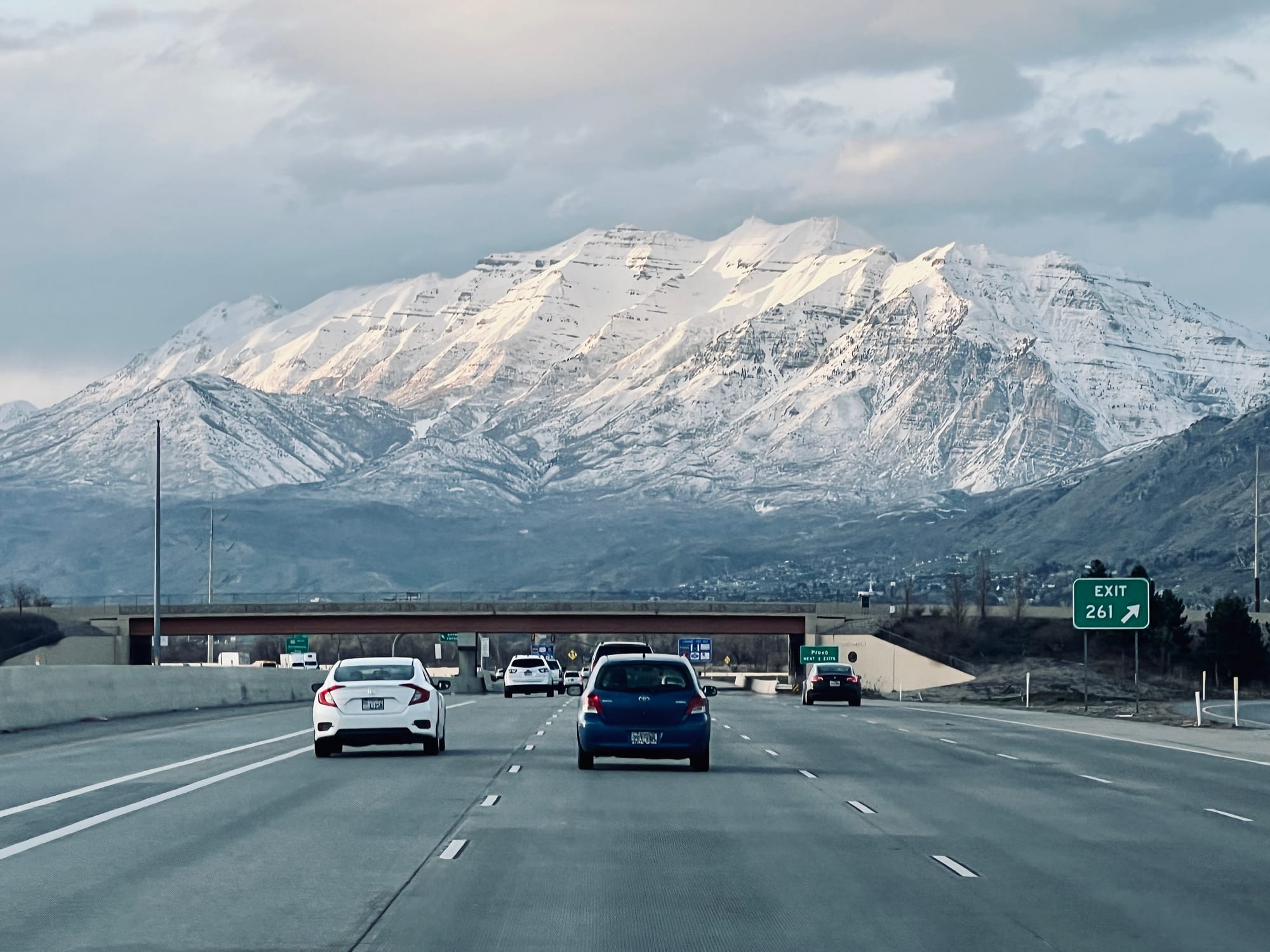
Email newsletters are undercounted and underrated for marketing 8 May 10:35 AM (5 months ago)
The other day I was reading my weekly update email from The Portland Japanese Garden and I know I've mentioned them a few times here in the past couple years, but damn, I have to admit they really treat members well.
There's a monthly magazine and a weekly email newsletter which means they must have a whole content team working there, but what's great is every week I basically get a newspaper about every project and every upcoming improvement and every art installation and every new tour they're offering, and none of it feels like marketing.
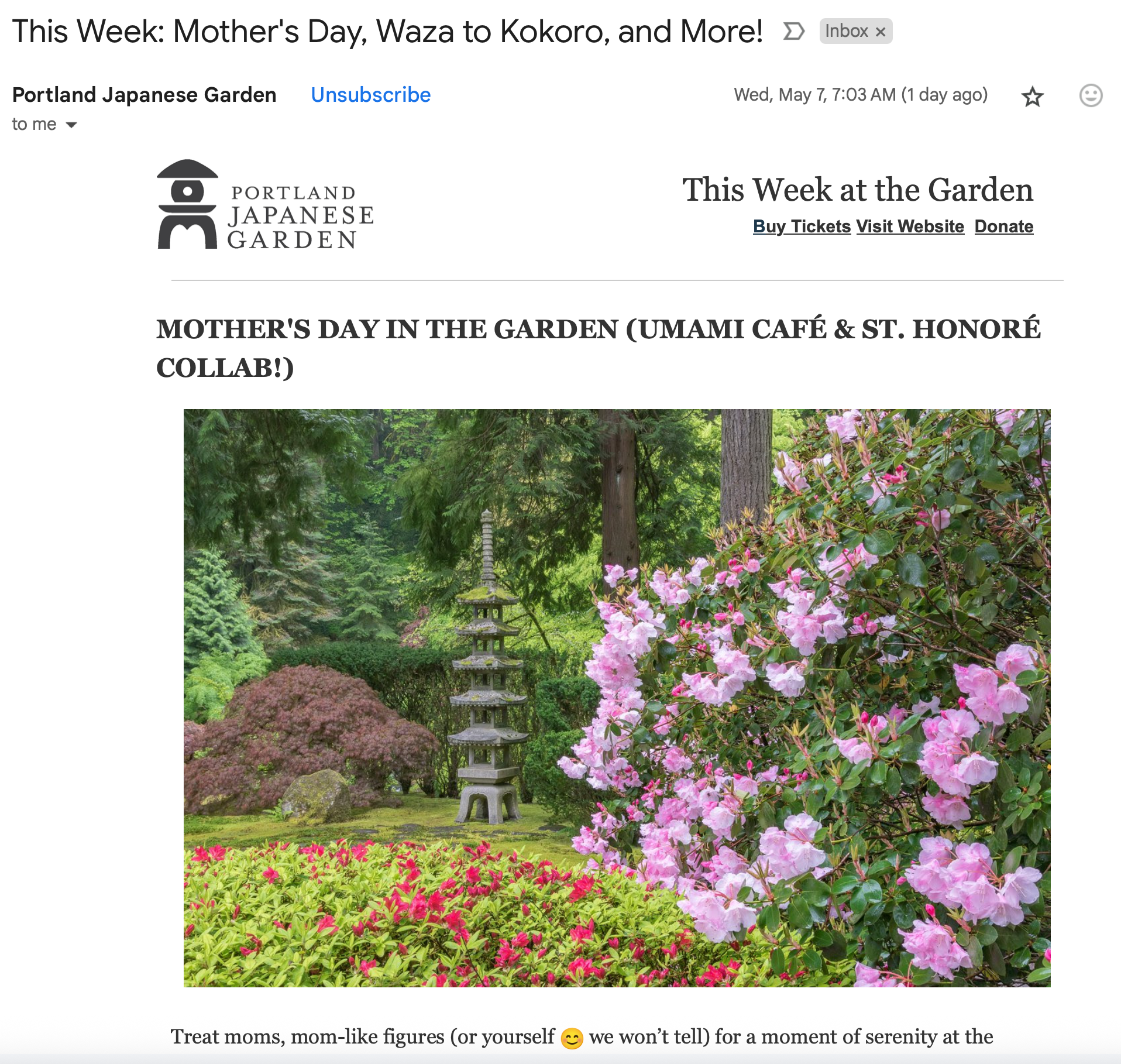
The newsletter promotes the garden and makes me glad that I contribute annually there and it reads like a friend emailing you to excitedly share all the cool stuff they've been working on lately.
Data driven nonsense
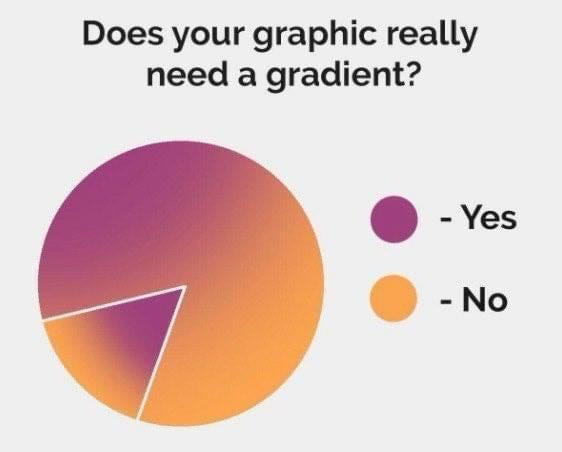
So much of corporate marketing that I've been steeped in for the last ten years is about putting things out and measuring the response, then trying to optimize those numbers to creep up ever higher.
I don't think I've ever witnessed a big content push in any organization showing up quickly or significantly in their numbers. It's not easy to measure how happy I am each week to read about special visitor hours or early-bird tickets to a special event because I saw it in their email. Most often, the organizations I've worked with that have a large content team producing cool stuff mostly do it based on the pure vibes or the gut feelings of one of the higher ups.
Sometimes, you have a CEO with a English degree who takes communication seriously, because to this day I haven't seen the hard work of people writing engaging, interesting content for customers and members of an organization show up in graphs and dashboards because that kind of goodwill tends to grow over months and years. It's not something you'd see as a surge of +10% click-thru rates this week, and that's a bummer, and probably why so few organizations have big content teams elevating and supporting their work.
Seriously, personal one-to-one messaging is more powerful than we think
I love going to movies and I often think back to my two favorite theaters on earth and what they used to do. Basically, both movie houses were owned and operated by a film fan who would walk up to the screen before each showing, welcome the audience in a booming voice right in front of you than share some tidbit, fact, or reason why they like this particular movie/script/director that was about to start
I still fondly remember over 20 years ago when I'd go to a movie theater on the west side of San Francisco that likely paid its rent thanks to a large film fan club that was organized via their email newsletter sent directly from the theater owner.
They'd write a weekly email that told you what was playing and why, and what was coming soon. And I'd add the good ones to my calendar and show up almost every week to catch a screening. When you showed up, you got the old time-y personal greeting inside the theater from the owner along with the information about the movie or the people that worked on it, or other related movies worth checking out afterwards.
I give a lot of money annually to organizations that I like and enjoy, and maybe half of them send at least a few emails each year. But what I really enjoy are those rare places that keep in regular contact with interesting, engaging information that never feels like they're trying to sell me something or shill for donations.
It's not easy to do, which is why it's probably so rare to see out in the wild, but I really do enjoy it when I see it and wish it were more the norm.
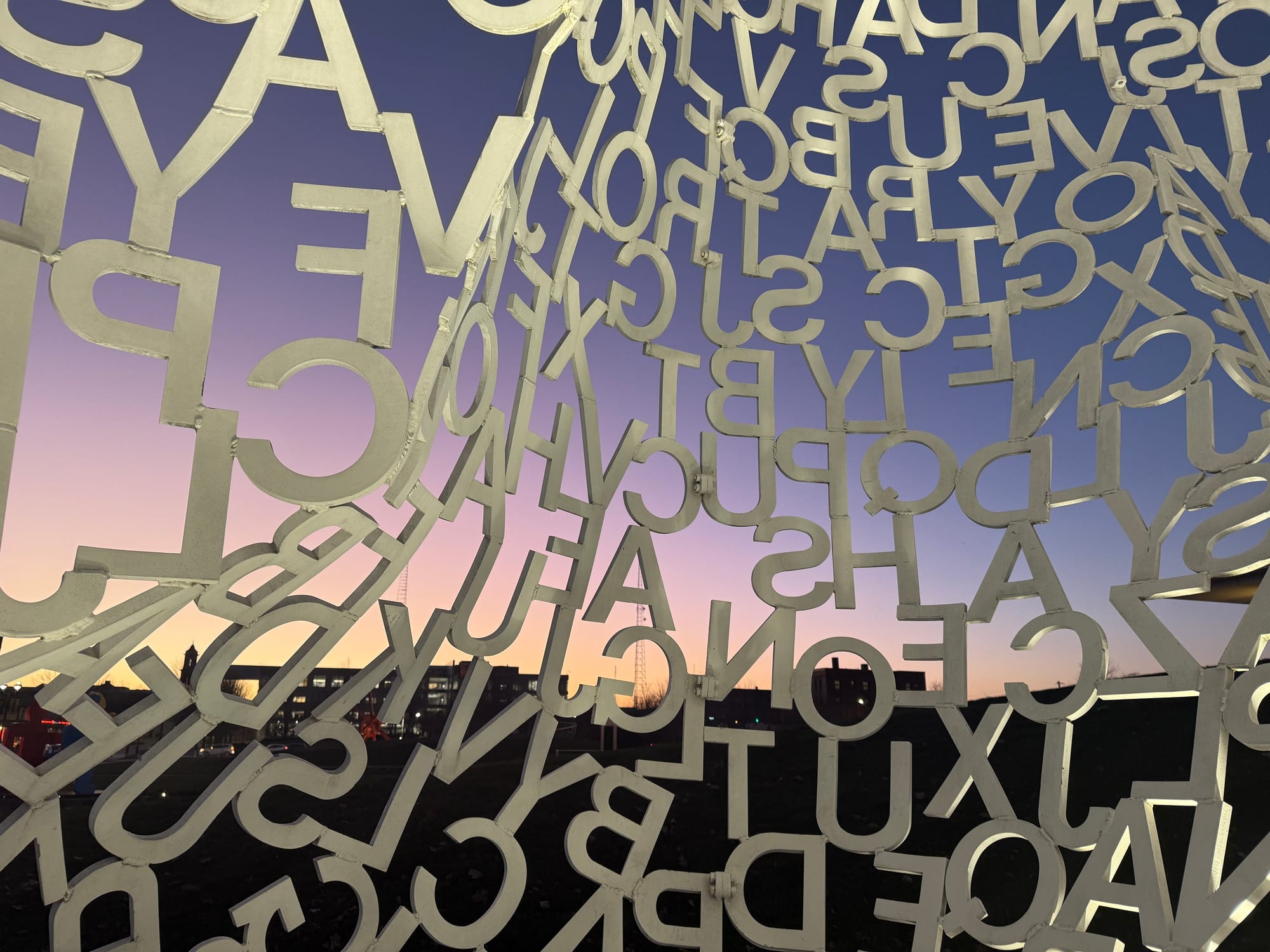
The one good app 6 May 8:14 AM (5 months ago)
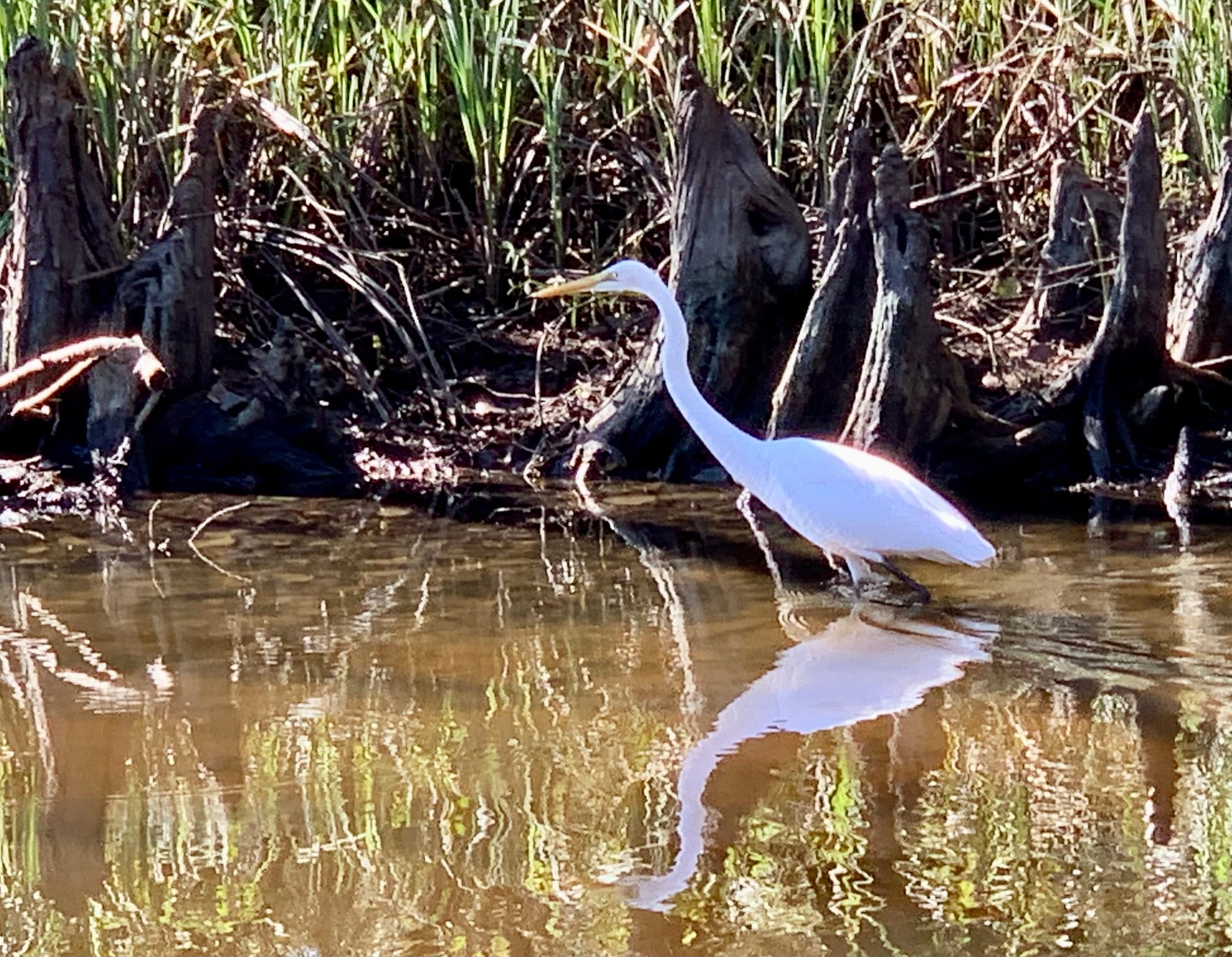
The other day I was walking the dog and as I was turning a corner amid a bunch of tall grasses, I overheard someone naming birds out loud.
I secretly love when this happens because it reminds me of being at an art museum. I can't count the number of times I'm enjoying art on my own and then a tour guide turns a corner as they're dropping facts and knowledge to their group about the art that surrounds us all. I know I'm not on the tour, and I never try to join the tour, but since the tour came to me, with the guide's voice carrying towards and eventually away from me, I get to learn a thing or two unexpectedly for the few seconds that we overlap.
So I was delighted to overhear someone telling their friend loudly that a thrush was nearby and a junco and a stellar's jay. Once I turned the corner, I spotted the person behind the voice, and they were holding their phone high into the air as they were naming unseen birds and I instantly knew what was going on.
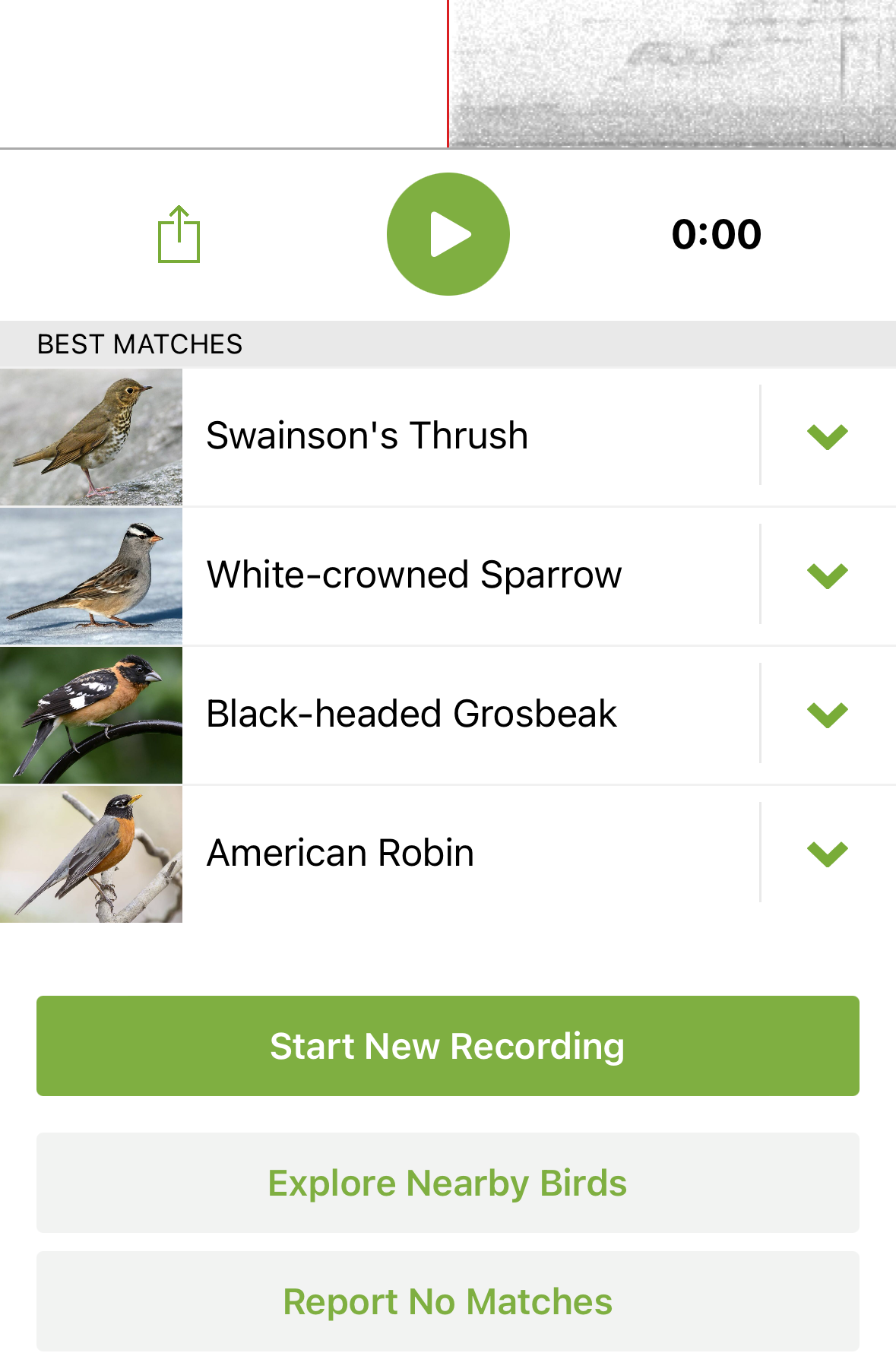
Cornell University's Merlin Bird ID app is a remarkable bit of tech, and probably the app that brings me the most joy on my phone. Everyone should have it on their devices.
It's wild that we have "Shazam for birds" and it's free for anyone and it works so well it's almost scary. Any time I'm anywhere—especially when traveling—and I wonder "What bird is making THAT sound?" I can pull up the Merlin bird app and instantly learn what it is.
It's a remarkable piece of tech and it wows me every time I use it. I'd put it's magical experience up there with the first time I ran the Google Translate app on my phone, as it translated foreign language menus into English in real-time through the camera lens.
The Slate EV truck 29 Apr 8:54 AM (5 months ago)
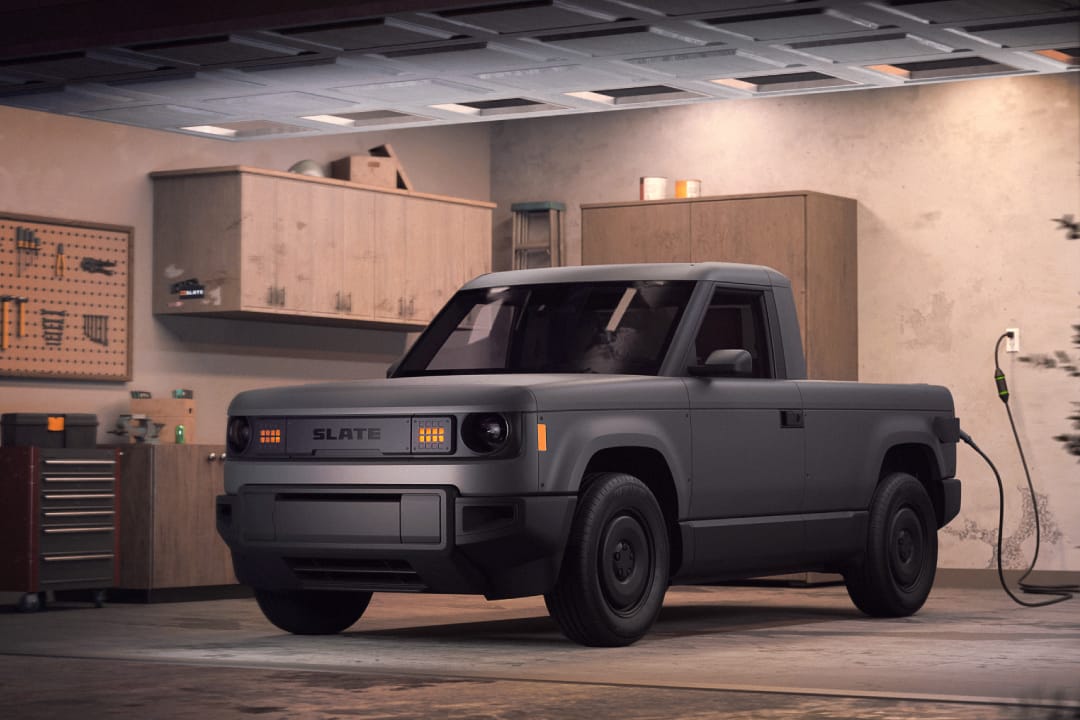
A bunch of friends sent me the announcement of the new Slate EV truck yesterday, asking what I thought. I was already looking forward to the Telo Truck, but the Slate looks even better and frankly, it's frighteningly close to my dream EV platform.
What would an ideal new EV product look like?
I've had a blog post about my dream version of an EV company circling in my brain for the past year but I never got around to finishing it. Basically my dream EV brand would make a product that hit these goals:
- Create a reference platform by selling one or two sizes/lengths of a "battery skateboard" starting around $20k that anyone could bolt any kind of body to.
- Sell various body configurations so people could bolt a sports car coupe body, a four door family sedan, a SUV, or a truck to it, for maybe $5k-$10k more.
- Publish open licensed, detailed CAD files of the battery skateboard so any other company could create a different "car" to go on top.
The EV market is being held back by costs of new EVs.
EVs are cheaper to produce and use, but that's not reflected in the prices of new EVs, as most companies produce luxurious, fast EVs. They need to be cheaper because they frankly can't do everything a gas car can, but as an "extra" car in your household, they should have prices that reflect that kind of secondary transportation. $20k is a great reasonable amount that feels "cheap" for a new or even used car (the average new car price in the US is currently $48k).
EVs are easier to scale up as a platform versus a combustion car.
Most car companies today make one generic EV platform that is used on many different models and configurations. Chevy's current EV platform is used for the Blazer EV and the Equinox EV, plus the Honda Prologue and the Acura ZDX. VW's auto group makes one EV platform that serves the ID4 sedan and the ID Buzz VW bus model, as well as some Audi e-tron models.
You slap four wheels, a basic suspension, and a bunch of batteries along with a motor on the bottom of a skateboard and you bolt any kind of body on top.
I love the idea of a reference platform much like the VW Beetle of the 1950s-1970s.
The VW bug was a car that didn't change much for decades, and its parts were shared with other VW models of that era. People made crazy versions for the beach, and for camping and for racing and for running errands. Every part for it was cheap and interchangeable, letting people change them for how they wanted to use them. EVs could follow a similar plan.
Everything Slate got right
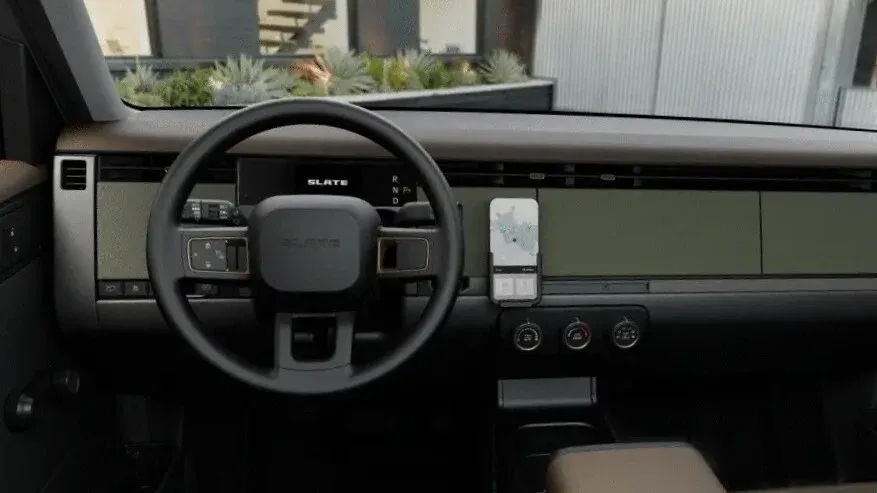
I love the Slate and almost everything about it. I love the low cost, I love the customization possibilities, and I love that they didn't try to make another overpriced luxury EV.
Small trucks are the way to go.
I love small trucks, my first two cars were both mini pickups from the 1980s and I love seeing imported Japanese kei trucks around Portland. I currently own a Ford Maverick that I enjoy driving, but I'd be happy going even smaller. The Slate is the perfect truck size.
>99% of car trips I've ever taken are 100 miles or less.
I love that Slate only shot for a 150mi max battery platform. That covers every use of a small car outside of a long road trip. I had a BMW i3 EV for a couple years, with a 75mi max battery and it was a fantastic city car for getting around the Portland metro area. Seriously a 100mi EV can be small and cheaper and cover almost all your typical driving.
Every car company is focused on making 300 mile range EVs as gas car replacements because that's what most cars get on a full tank of gas, but that means they must be large, heavy, and expensive to pay for all those batteries. People should instead think about an EV as a vehicle for most normal city trips while saving rare long road trips for a rented gas car (or a gas car you keep as a backup).
I love that they shot for such a low price.
EVs offer a bunch of advantages for the companies making them, but few EVs sold in America pass those savings along. Instead we get a lot of super fast, super luxurious EVs with costs that creep up towards (and even beyond) $100k. Public support for EVs won't happen en masse until it's a cheaper, easier, and frankly a better option than buying an entry level combustion car. $20k as a starting price totally nails that.
I love the barebones interior.
The Ford Maverick tried to be a $20k entry level small pickup a few years back and even though most cost around $30k today, one thing I love about the Maverick is that entertainment system offloads almost everything to your phone. It feels like the first truck designed for an iPhone or Android natively, with zero navigation built in (because who even uses the stock navigation when our phones give us up-to-the-minute traffic info?).
When I buy old used cars for projects, I specifically look for bare-bones stripped models because they're easier to work on, easier to upgrade, and have less things that can go wrong. I adore the roll up windows and blank dashboard of the Slate truck. A blank dashboard is exactly where I'd install a 10"-12" CarPlay stereo or iPad screen and I'm happy to know I wouldn't have to strip out (or pay for) a stock stereo I wasn't going to use anyway.
Their suite of customization options is completely and totally my jam.
I already do this with every car I've owned, but them producing something from the factory that is ready to tweak how the owners want to use them is an ideal scenario. Kudos, Slate design team, you nailed this one.
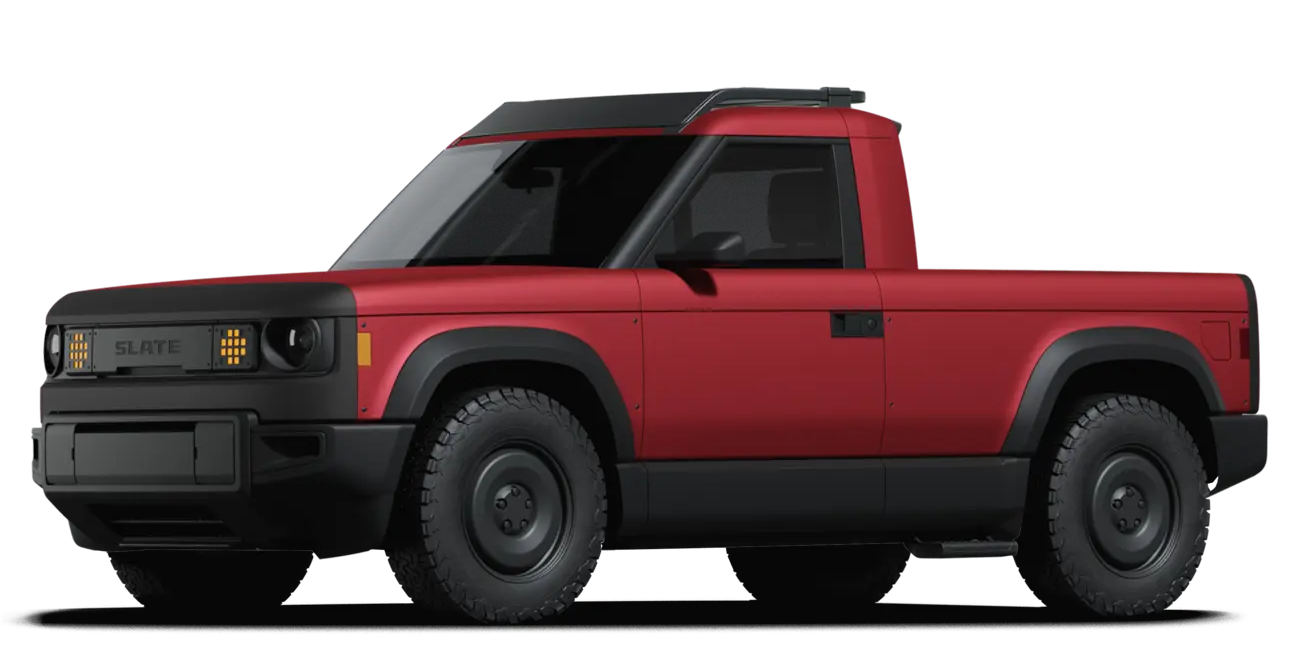
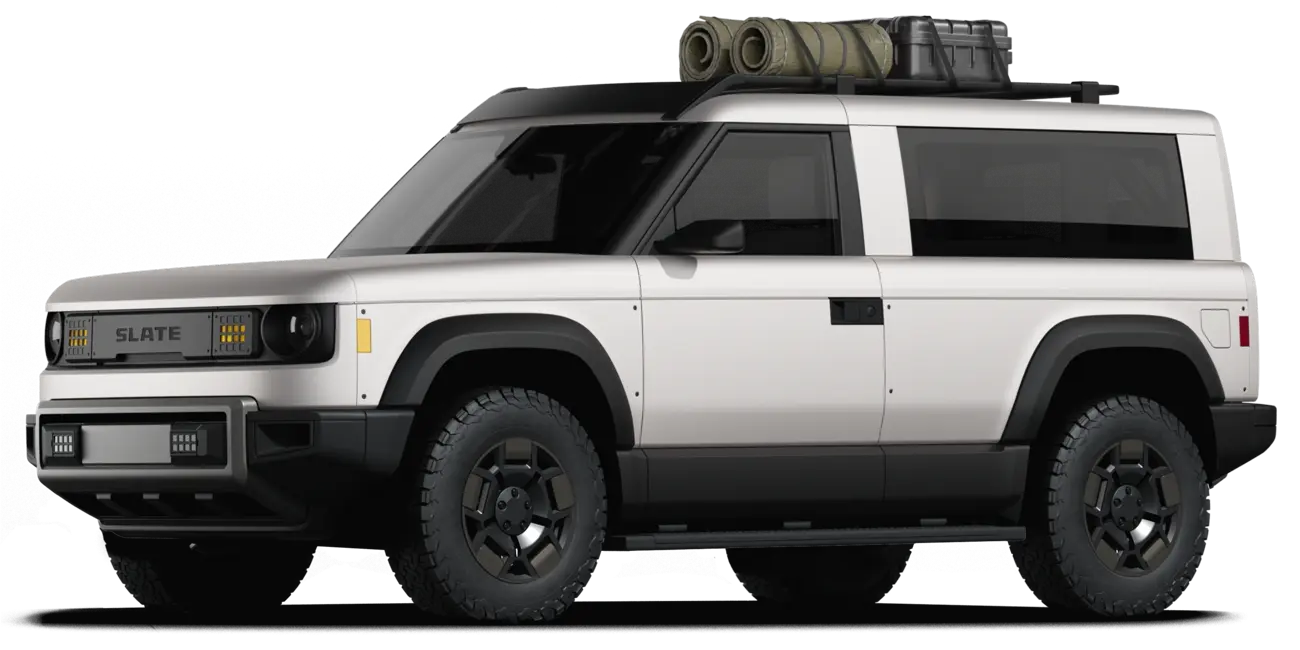
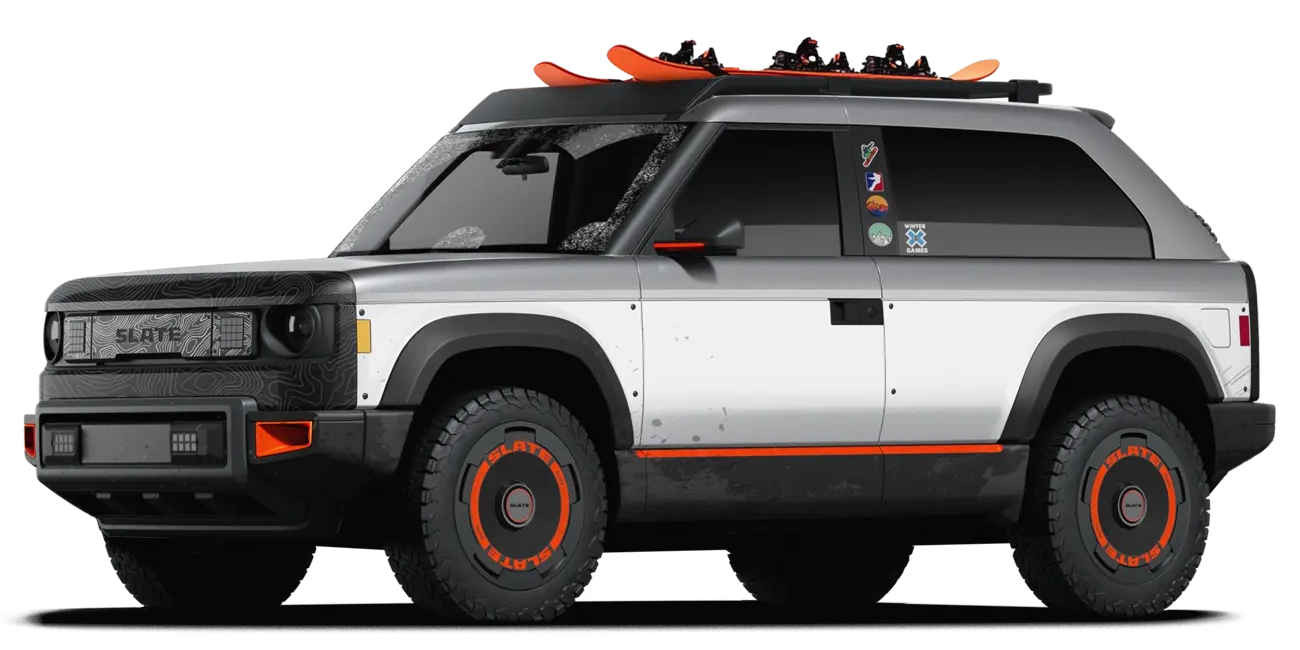
Honestly I would take any of these configurations above and enjoy the heck out of them.
My only hope is that Slate can figure out a way to really produce this simple stripped down platform at the prices they set, but also figure out a way to make it profitable as a company without saddling owners with monthly subscriptions or too much upselling.
I'll be following them closely and if they can put this out around the prices they promised in just a couple years, I think they'll have a huge hit on their hands.
UPDATE: I placed a $50 pre-order for one and hope to see them in June when the company swings through Portland on a demo tour. Here's my aqua and bronze SUV version I made on their customizer:
